Edimax Technology Co 9574381114 300N Wireless LAN Repeater User Manual 802
Edimax Technology Co Ltd 300N Wireless LAN Repeater 802
Users Manual
300N Wireless LAN Repeater
User Manual
Version: 1.0
(October, 2011)
COPYRIGHT
Copyright © 2011/2012 by this company. All rights reserved. No part of this
publication may be reproduced, transmitted, transcribed, stored in a retrieval
system, or translated into any language or computer language, in any form or
by any means, electronic, mechanical, magnetic, optical, chemical, manual or
otherwise, without the prior written permission of this company
This company makes no representations or warranties, either expressed or
implied, with respect to the contents hereof and specifically disclaims any
warranties, merchantability or fitness for any particular purpose. Any software
described in this manual is sold or licensed "as is". Should the programs prove
defective following their purchase, the buyer (and not this company, its
distributor, or its dealer) assumes the entire cost of all necessary servicing,
repair, and any incidental or consequential damages resulting from any defect
in the software. Further, this company reserves the right to revise this
publication and to make changes from time to time in the contents thereof
without obligation to notify any person of such revision or changes.
Federal Communication Commission
Interference Statement
FCC Part 15
This equipment has been tested and found to comply with the limits for a Class
B digital device, pursuant to Part 15 of FCC Rules. These limits are designed
to provide reasonable protection against harmful interference in a residential
installation. This equipment generates, uses, and can radiate radio frequency
energy and, if not installed and used in accordance with the instructions, may
cause harmful interference to radio communications. However, there is no
guarantee that interference will not occur in a particular installation. If this
equipment does cause harmful interference to radio or television reception,
which can be determined by turning the equipment off and on, the user is
encouraged to try to correct the interference by one or more of the following
measures:
1. Reorient or relocate the receiving antenna.
2. Increase the separation between the equipment and receiver.
3. Connect the equipment into an outlet on a circuit different from that
to which the receiver is connected.
4. Consult the dealer or an experienced radio technician for help.
FCC Caution
This equipment must be installed and operated in accordance with provided
instructions and a minimum 20 cm spacing must be provided between
computer mounted antenna and person’s body (excluding extremities of hands,
wrist and feet) during wireless modes of operation.
This device complies with Part 15 of the FCC Rules. Operation is subject to the
following two conditions: (1) this device may not cause harmful interference,
and (2) this device must accept any interference received, including
interference that may cause undesired operation.
Any changes or modifications not expressly approved by the party responsible
for compliance could void the authority to operate equipment.
Federal Communication Commission (FCC) Radiation Exposure
Statement
This equipment complies with FCC radiation exposure limits set forth for an
uncontrolled environment. In order to avoid the possibility of exceeding the
FCC radio frequency exposure limits, human proximity to the antenna shall not
be less than 20cm (8 inches) during normal operation.
The antenna(s) used for this transmitter must not be co-located or operating in
conjunction with any other antenna or transmitter.
The equipment version marketed in US is restricted to usage of the channels
1-11 only.
R&TTE Compliance Statement
This equipment complies with all the requirements of DIRECTIVE 1999/5/EC
OF THE EUROPEAN PARLIAMENT AND THE COUNCIL of March 9, 1999 on
radio equipment and telecommunication terminal Equipment and the mutual
recognition of their conformity (R&TTE).
The R&TTE Directive repeals and replaces in the directive 98/13/EEC
(Telecommunications Terminal Equipment and Satellite Earth Station
Equipment) As of April 8, 2000.
Safety
This equipment is designed with the utmost care for the safety of those who
install and use it. However, special attention must be paid to the dangers of
electric shock and static electricity when working with electrical equipment. All
guidelines of this and of the computer manufacture must therefore be allowed
at all times to ensure the safe use of the equipment.
EU Countries Intended for Use
The ETSI version of this device is intended for home and office use in Austria,
Belgium, Denmark, Finland, France, Germany, Greece, Ireland, Italy,
Luxembourg, the Netherlands, Portugal, Spain, Sweden, and the United
Kingdom.
The ETSI version of this device is also authorized for use in EFTA member
states: Iceland, Liechtenstein, Norway, and Switzerland.
EU Countries Not intended for use
None.
C A T A L O G
Chapter I: Product Information ...................................................................... 1
1-1 Introduction and safety information ................................................................ 1
1-2 Safety Information ........................................................................................... 2
1-3 System Requirements ...................................................................................... 3
1-4 Package Contents ............................................................................................. 4
1-5 Familiar with your new wireless repeater ........................................................ 5
CHAPTER II: Repeater mode ................................................................................. 8
2-1 Repeater mode Quick Installation Guide ......................................................... 8
2-1-1 Hardware WPS button setup ................................................................ 10
2-1-2 Web browser quick setup ..................................................................... 13
2-2 Repeater mode Advanced Settings ................................................................ 17
2-2-1 Setup IP address ................................................................................... 17
Windows XP IP address setup: ............................................................. 17
Windows Vista/7 IP address setup: ....................................................... 18
2-2-2 Connect to web configuration menu .................................................... 20
2-2-3 Home .................................................................................................... 22
2-2-4 WPS Setting ......................................................................................... 24
2-2-5 Advanced Settings ................................................................................ 27
2-2-6 MAC Address Filtering ........................................................................ 31
2-2-7 System Utility ...................................................................................... 38
CHAPTER III: Client mode ....................................................................... 44
3-1 Client mode Quick Installation Guide ........................................................... 44
3-1-1 Hardware WPS button setup ................................................................ 46
3-1-2 Web browser quick setup ..................................................................... 49
3-2 Client mode Advanced Settings ..................................................................... 52
3-2-1 Setup IP address ................................................................................... 52
Windows XP IP address setup: ............................................................. 52
Windows Vista/7 IP address setup: ....................................................... 53
3-2-2 Connect to web configuration menu .................................................... 55
3-2-3 Home .................................................................................................... 56
3-2-4 WPS Setting ......................................................................................... 57
3-2-5 Advanced Settings ................................................................................ 60
3-2-6 System Utility ...................................................................................... 63
CHAPTER IX: AP mode ............................................................................. 69
4-1 AP mode Quick Installation Guide ................................................................ 69
4-1-1 Hardware WPS button setup ................................................................ 71
4-1-2 Web browser quick setup ..................................................................... 73
4-2 AP mode Advanced Settings .......................................................................... 77
4-2-1 Setup IP address ................................................................................... 77
Windows XP IP address setup: ............................................................. 77
Windows Vista/7 IP address setup: ....................................................... 78
4-2-2 Connect to web configuration menu .................................................... 80
4-2-3 Home .................................................................................................... 81
4-2-4 WPS Setting ......................................................................................... 83
4-2-5 Advanced Settings ................................................................................ 86
4-2-6 MAC Address Filtering ........................................................................ 90
4-2-7 System Utility ...................................................................................... 97
Chapter X: Appendix ................................................................................. 105
5-1 Configuring TCP/IP on PC .......................................................................... 105
5-2 Specification ................................................................................................ 109
5-3 Glossary ....................................................................................................... 110
1
Chapter I: Product Information
1-1 Introduction and safety information
Thank you for purchasing this mini 802.11b/g/n wireless repeater!
The ultra-compact design with power built-in allows you to install this
repeater everywhere, and still providing excellent network performance
to extend the Wi-Fi signal and wireless coverage.
Other features of this wireless repeater including:
Extend the wireless signal inside your home or office.
Ultra-compact design while maintaining excellent network
performance.
LED signal indicator to easily realize the best location placement
to extend WiFi signal and secure better wireless performance.
The device can support Repeater mode, AP mode and AP client
mode
Hardware switch button for user to change operation mode
quickly without logging into web firmware.
WPS (Wi-Fi Protected Setup) hardware button for easy
installation and secure wireless security.
2
1-2 Safety Information
In order to keep the safety of users and your properties, please follow the
following safety instructions:
1. This wireless repeater is designed for indoor use only. DO NOT expose
this device to direct sun light, rain, or snow.
2. DO NOT put this at or near hot or humid places, like kitchen or
bathroom. Also, do not left this Wireless repeater in the car in summer.
3. Do not allow kids to put any small parts of this wireless repeater in
their mouth, and it could cause serious injury or could be fatal. If they
throw this wireless repeater, it will be damaged. PLEASE KEEP THIS
WIRELESS REPEATER OUT THE REACH OF CHILDREN!
4. This Wireless repeater will become hot when being used for long time
(This is normal and is not a malfunction). DO NOT put the Wireless
repeater on a paper, cloth, or other flammable objects after the Wireless
repeater has been used for a long time.
5. There‟s no user-serviceable part inside the Wireless repeater. If you
found that the Wireless repeater is not working properly, please contact
your dealer of purchase and ask for help. DO NOT disassemble the
Wireless repeater by yourself, warranty will be void.
6. If the Wireless repeater falls into water, DO NOT USE IT AGAIN
BEFORE YOU SEND THE CARD TO THE DEALER OF PURCHASE
FOR INSPECTION.
3
1-3 System Requirements
Wireless network card which is compatible with 802.11b/g/n wireless
network standard.
Windows 2000, 2003, XP, Vista, or Windows 7 operating system
CD-ROM drive
At least 100MB of available disk space
4
1-4 Package Contents
Before you start to use this wireless repeater, please check if there‟s
anything missing in the package, and contact your dealer of purchase to
claim for missing items:
□ Wireless Repeater (1 pcs) …………………………..…………… 1
□ Quick Installation Guide (1 pcs) …………………………………. 2
□ User Manual CDROM (1 pcs) …………………………………… 3
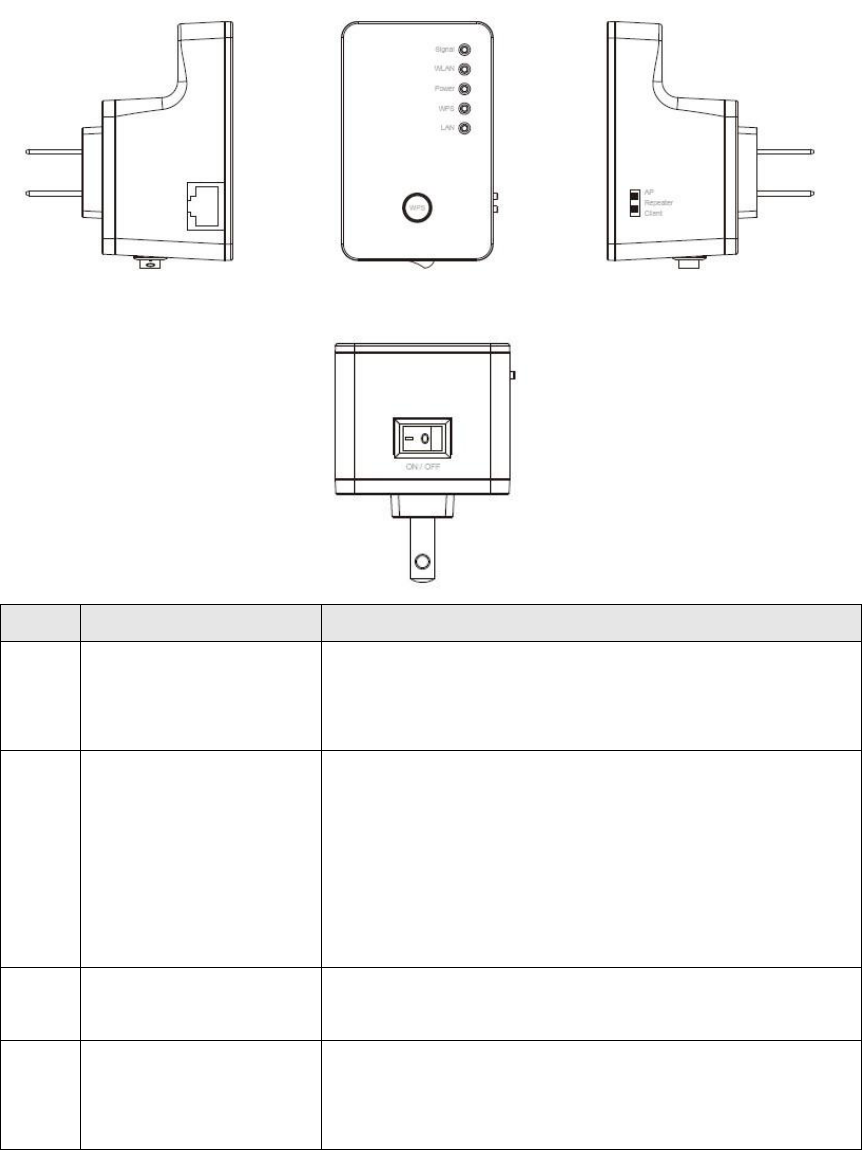
5
1-5 Familiar with your new wireless repeater
Interface Descriptions
Item
Item Name
Description
A
LAN
10/100M Ethernet LAN Port with
Auto-MDI/MDI-X. Connecting to computer,
switch or hub for local network sharing.
B
Reset / WPS
Reset the repeater to factory default settings
(clear all settings) or start WPS function.
Press this button and hold for 10 seconds to
restore all settings to factory defaults, and
press this button for less than 5 seconds to
start WPS function.
C
AP/Repeater/Client
Switch the button to change operating mode
to Access Point or Repeater or Client mode.
D
ON/OFF
This is power on/off slide switch. If you want
to switch off the repeater, switch it to Off
mode.
A
B
C
D

6
LED Definitions
LED
Color
LED Status
Description
Signal
Amber
Steady ON
Good signal reception (signal strength
100%~50%).
Blinking
Normal signal reception
Slow blinking (50%~25%)
Poor signal reception
Quick blinking (<25%)
Off
Out of signal or disconnected/ or LED
off mode.
WLAN
Green
Blinking
Connect to wireless Router/or AP,
wireless function is active (transferring
or receiving data)
Off
Wireless network is switched off/ or
LED off mode.
Power
Green
Steady ON
Power is turned on.
In LED off mode. (except power LED
is on, other LEDs are off *)
*If user selects to enable “LED OFF
mode”, power LED On/Off depends on
user‟s selection, user can select to
leave only power LED on or turn off all
LEDs including this power LED.
Slow Blinking
Ready for “Reset to factory default”,
power LED is blinking.

7
Off
power is turned off.
WPS
Green
Steady ON
When WPS connection is successful,
turn on for 5 minutes.
Blinking
WPS is in progress of waiting another
WPS device‟s connection, blinking (0.2
second on, 0.1 second off) for 2
minutes.
Quick blinking
WPS error, blinking (0.1 second on, 0.1
second off)
Off
NO WPS is in progress/ LED off mode
LAN
Green
Steady ON
LAN port is connected.
Blinking
LAN port is active (transferring or
receiving data).
Off
LAN port is not connected/ or LED off
mode
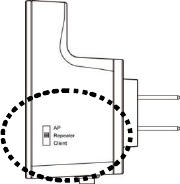
8
CHAPTER II: Repeater mode
Repeater mode is your Wi-Fi range extender!
It can extend your wireless signal and coverage and help you to solve
wireless dead zone problem.
This chapter will show you how to quickly install this device by using
quick setup and show you the each detailed setting on web UI page of
repeater mode.
2-1 Repeater mode Quick Installation Guide
For the first time setup and easy installation, you can move this device
close to the Wireless Broadband Router or Access point you wish to
connect, after installation done and wireless connection is built, you can
move this repeater device to the place you wish to use.
Switch mode selector to „Repeater‟.
Insert this device into power outlet on the wall, and switch wireless
repeater‟s power switch to „ON‟ (1). You should see „Power‟ LED light
up in few seconds (2). If not, please check if the power outlet you‟re
using is working.
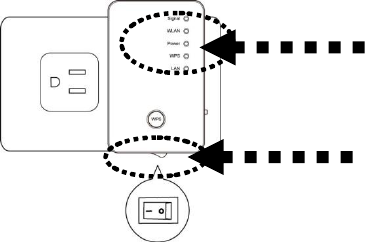
9
You can build wireless connection via „Hardware WPS button‟ or
„Software web browser‟.
If your broadband router or access point also supports „WPS button‟, we
recommend you to use WPS button to establish connection, it is the fast
and secure way without computer.
Using WPS button - please go to section 2-1-1
Using Web browser - please go to section 2-1-2
(2)
(1)
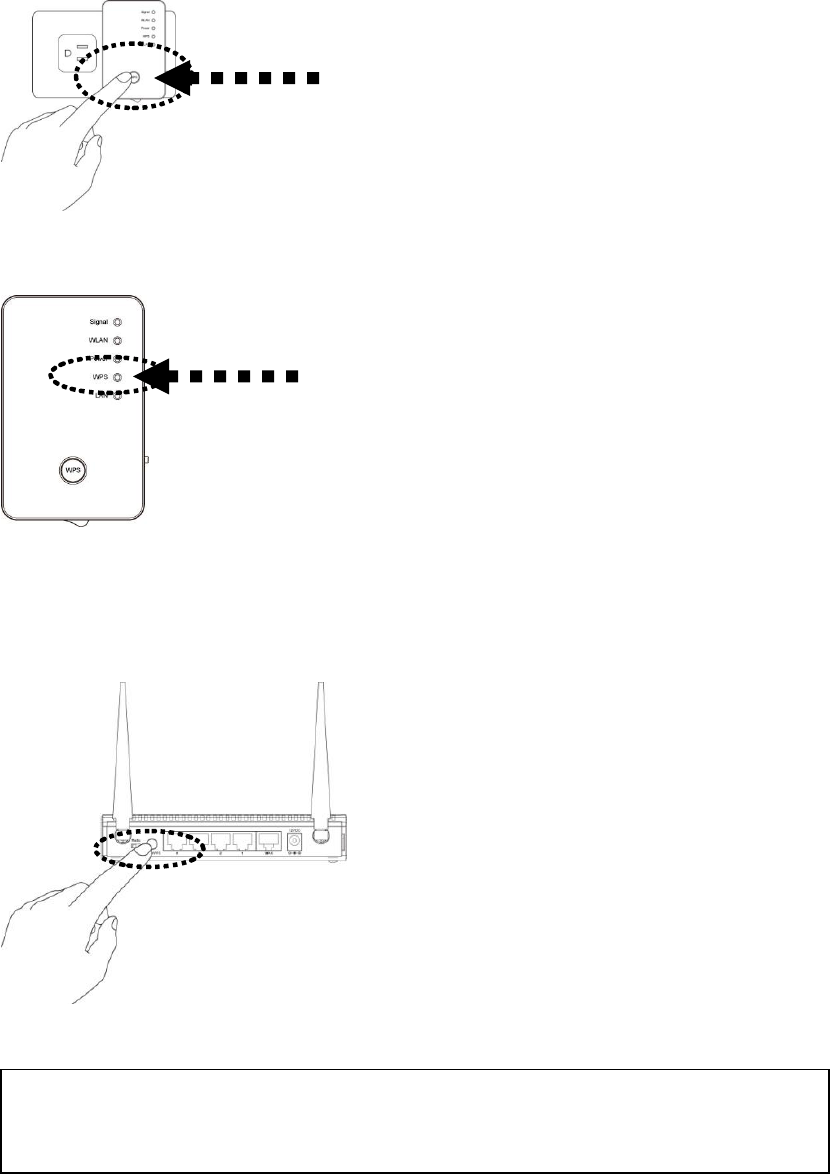
10
2-1-1 Hardware WPS button setup
(1) Press and hold WPS button on repeater for 2 seconds, „WPS‟ LED
will start flashing.
(2) Press WPS button on the wireless broadband router or access point
you wish to connect within 2 minutes.
WPS LED
WPS button
NOTE: this WPS button position on access point is for example,
different device may have different WPS button position.
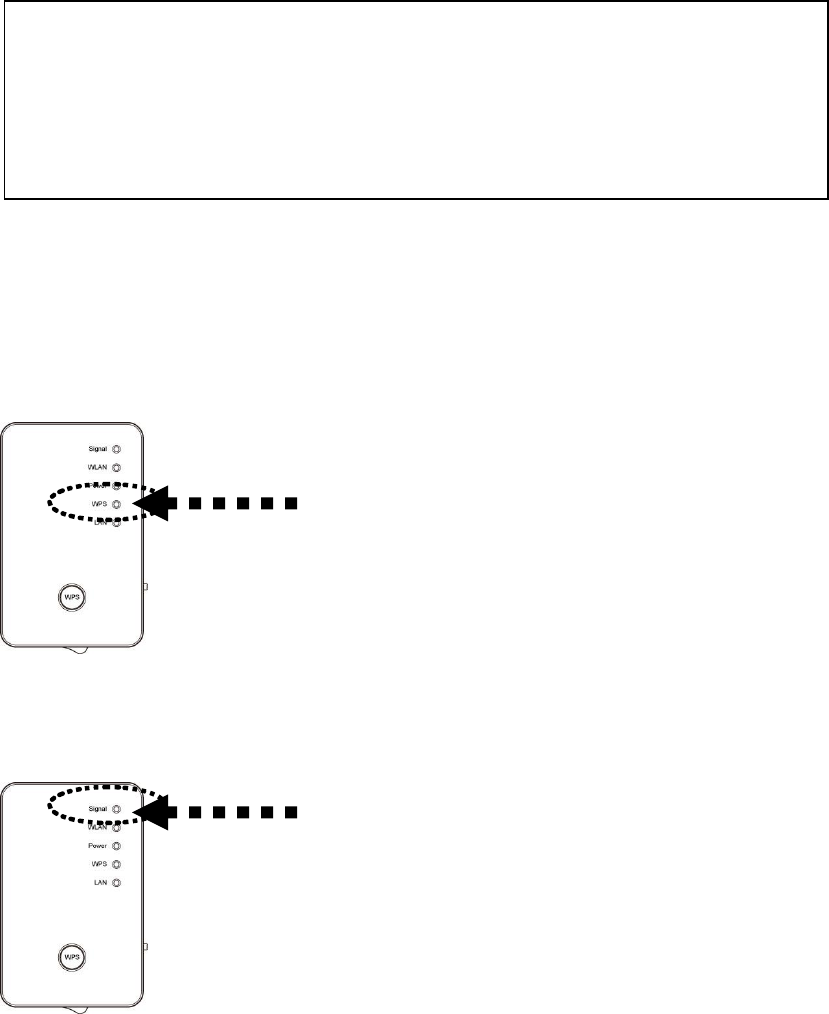
11
(3) If WPS connection is successfully established, „WPS‟ LED will light
for 5 minutes; if „WPS‟ LED flashes fast, there‟s something error, please
wait for 2 minutes until „WPS‟ LED off, and try from step(1) again.
When quick installation is successfully done, „Signal” LED will turn on.
(4) Please move repeater to the place you wish to use (a better place will
be the center of your house) and insert this repeater into power outlet on
the wall, the wireless connection will be established automatically.
You can check „Signal‟ LED status to understand signal reception level.
Steady light: Excellent, Flash: Good, Fast flash: poor.
TIP: If the access point you wish to connect does not have hardware
WPS button, you can also use its web configuration menu’s WPS
function to establish connection. Or you can login this repeater web
UI to have quick setup (detailed setup refers to ‘2-1-2 Web browser
quick setup’ manual)
manual)
WPS LED
Signal LED

12
The quick installation setup is completely done, you can refer to „2-2
Repeater mode Advanced Settings‟ to login in web UI for other advanced
settings.
NOTE: If the Signal LED is off, it means this place is out of wireless
signal of your wireless broadband router or access point, please
move this repeater closer to broadband router until repeater device
can receive signal from broadband router and extend its signal.
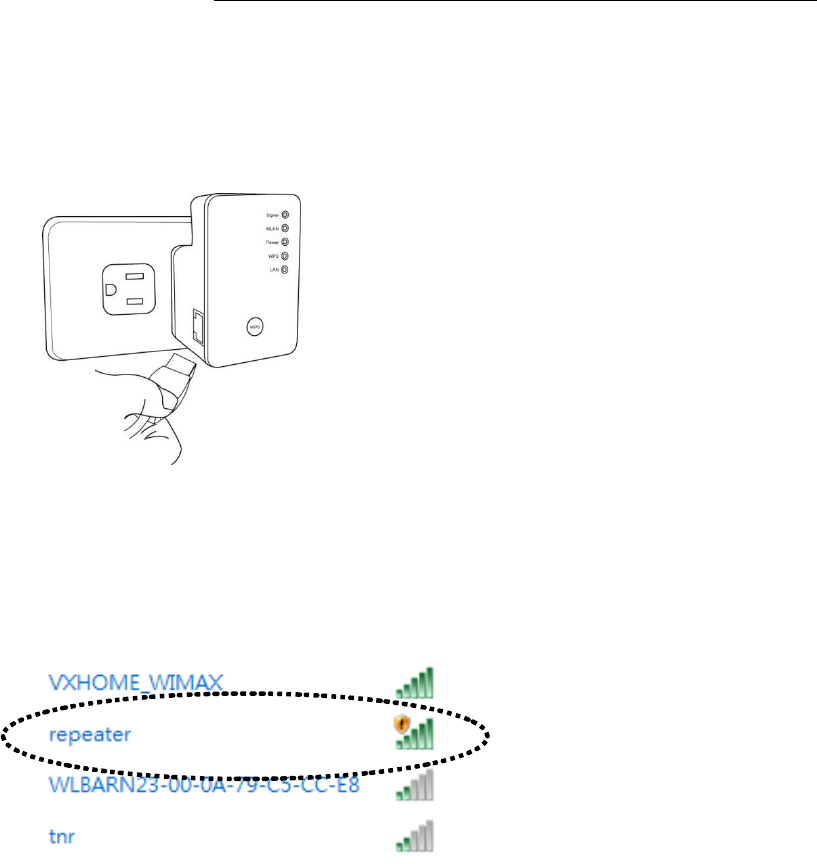
13
2-1-2 Web browser quick setup
Before you can connect to the repeater and start configuration procedures,
your computer must be able to get an IP address automatically (use
dynamic IP address). If it‟s set to use static IP address, or you‟re unsure,
please refer to „Chapter X: Appendix, 5-1 Configuring TCP/IP on PC‟ to
set your computer to use dynamic IP address.
(1)Use Ethernet cable to connect your computer‟s Ethernet port and
wireless repeater‟s Ethernet port.
Or use your computer‟s wireless configuration utility to search for access
point named „repeater‟ and get connected. (The default SSID of this
repeater device is „repeater‟)
(2)Open web browser and input „http://repeater‟ in address bar. (or you
can input the default IP address „192.168.2.254‟)
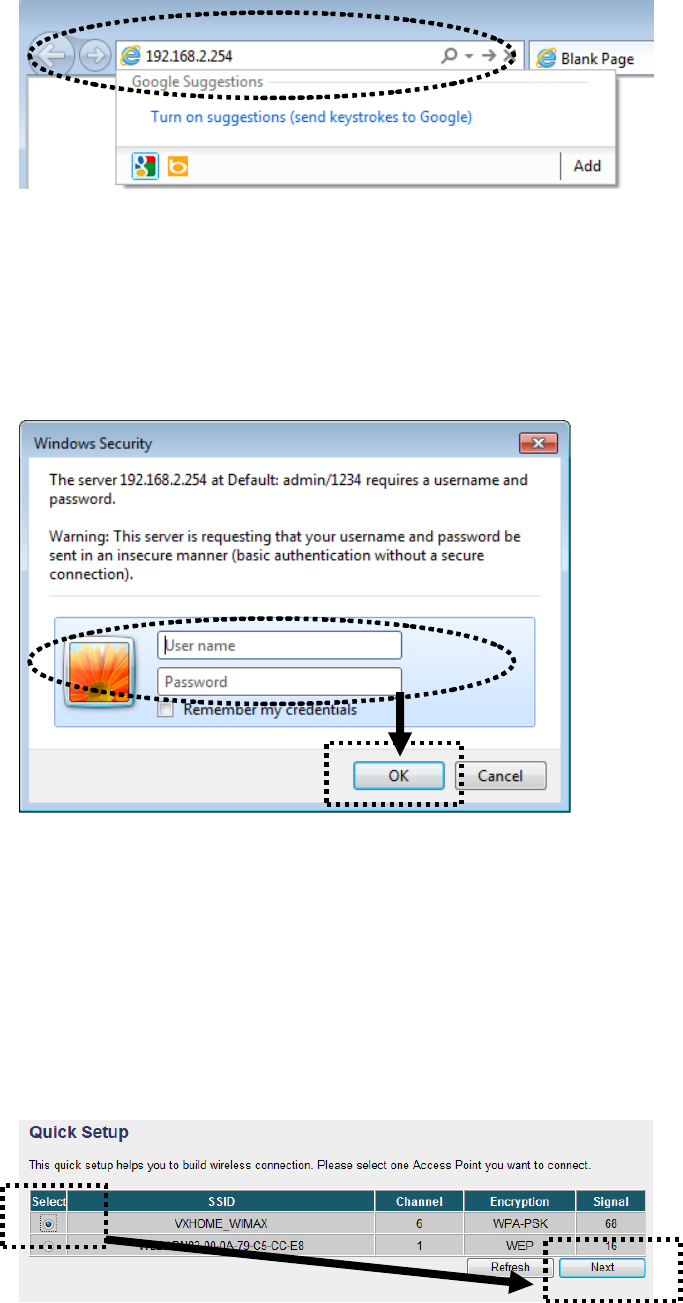
14
(3)Wireless repeater will prompt you to input username and password.
Default username is „admin‟ and password is „1234‟. Click „OK‟ button
to continue.
(4)All wireless access points nearby will be displayed on the list. Select
one access point you want to connect and click „Next‟ button to continue.
If the access point you wish to connect does not appear here, please click
„Refresh‟ until it appears on the list, or try to move wireless repeater
closer to the access point you wish to connect.
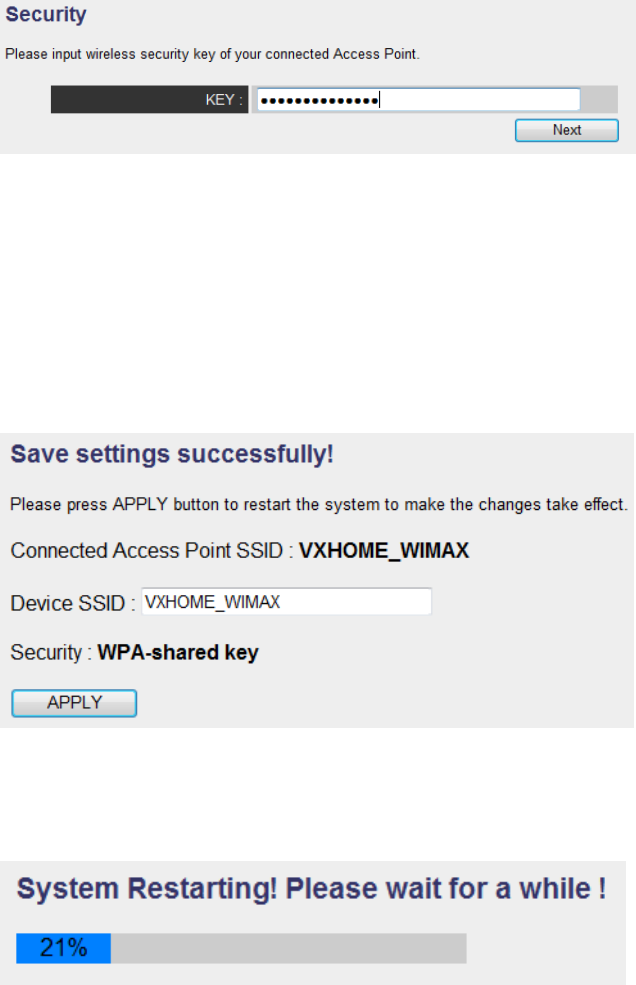
15
(5)You‟ll be prompted to input access point‟s wireless security key, input
it in „KEY‟ field and click „Next‟ to continue.
(6) Wireless repeater will display the connection information for you, if
everything‟s correct, please click „APPLY‟ button to get connected.
„Device SSID‟ will be the same of the access point‟s SSID you connected
in this step. You can change it to a different SSID if you want.
(7)Please wait for few seconds for wireless repeater to reboot.
(8) After reboot complete, web browser will login repeater‟s home page
of Web UI. You can close browser and use your computer to connect to
wireless access point by the SSID you set in last step and start using
network.

16
NOTE: After wireless connection of this repeater and wireless
broadband router is built, repeater is DHCP client and will get IP
address from broadband router automatically. If you want to login
Web UI of repeater, please refer to ‘2-2 Repeater mode Advanced
Settings’ for more functions or learn how to login web UI again.
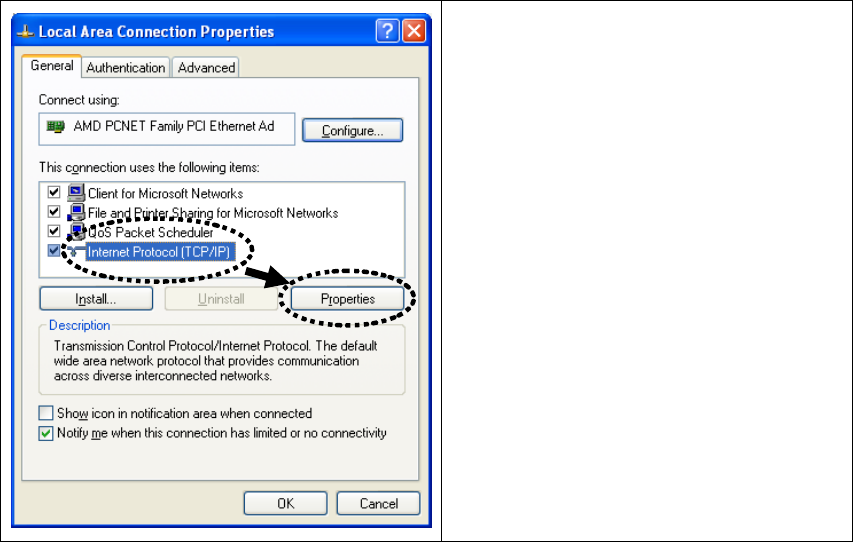
17
2-2 Repeater mode Advanced Settings
2-2-1 Setup IP address
Default IP address of this Wireless repeater is 192.168.2.254, please make
sure your PC‟s IP is within the range of 192.168.2.2~192.168.2.252.
Before you can login web UI, you can set your computer‟s IP address to
any IP within this subnet. If you don‟t know how to do this, please refer
to following instructions.
Windows XP IP address setup:
Click ‘Start’ button (it should be
located at lower-left corner of your
computer), then click control panel.
Double-click Network and Internet
Connections icon, click Network
Connections, and then double-click
Local Area Connection, Local
Area Connection Status window
will appear, and then click
‘Properties’
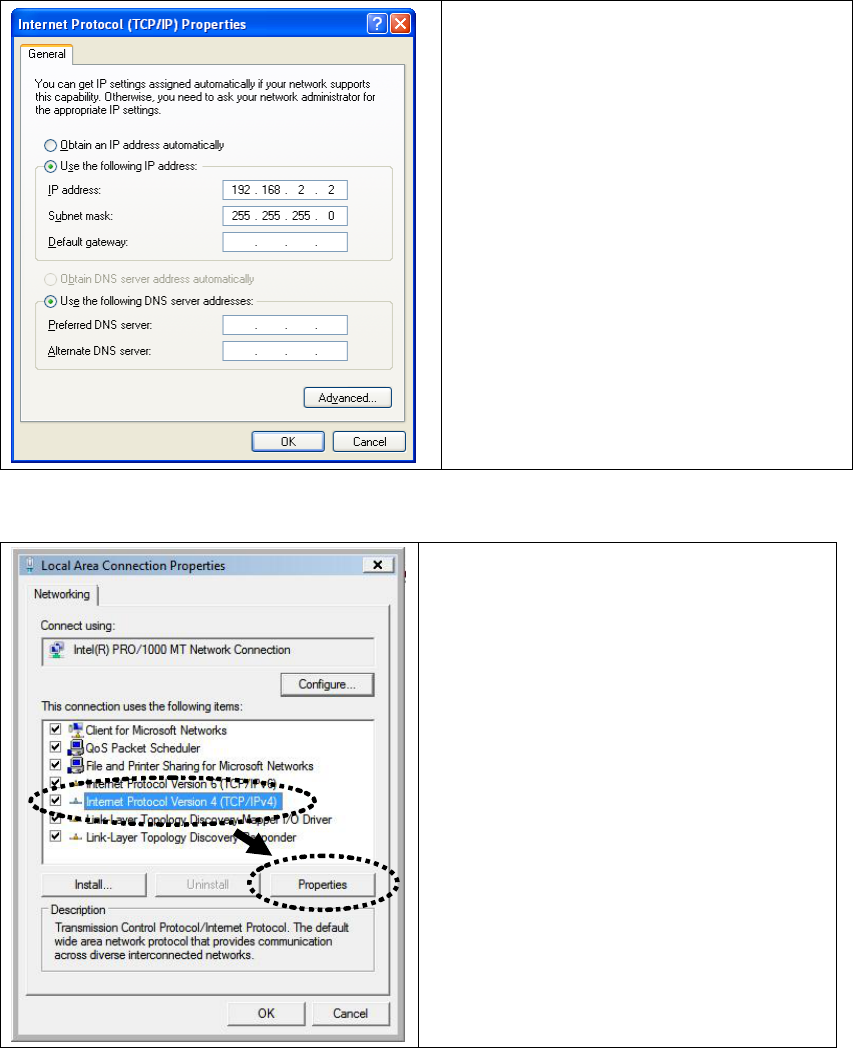
18
Select ‘Use the following IP
address’, then input the following
settings in respective field:
IP address: 192.168.2.x (where x is
an integer greater or less than 200, if
there’s more than one computer
need to use this wireless
presentation gateway on the same
network, every computer should use
an unique number)
Subnet Mask: 255.255.255.0
Click ‘OK’ when finish.
Windows Vista/7 IP address setup:
Click ‘Start’ button (it should be
located at lower-left corner of your
computer), then click control panel.
Click View Network Status and
Tasks, then click Manage Network
Connections..Right-click Local
Area Netwrok, then select
‘Properties’. Local Area
Connection Properties window will
appear, select ‘Internet Protocol
Version 4 (TCP / IPv4), and then click
‘Properties’
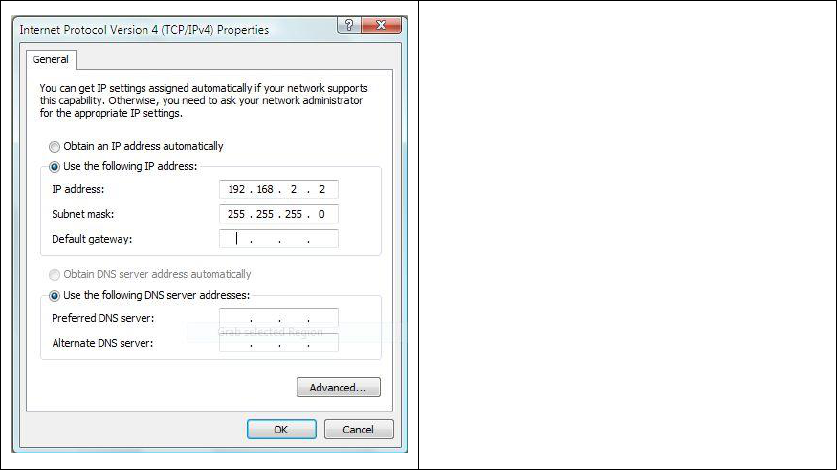
19
Select ‘Use the following IP address’,
then input the following settings in
respective field:
IP address: 192.168.2.x (where x is
an integer greater or less than 200, if
there’s more than one computer need
to use this wireless presentation
gateway on the same network, every
computer should use an unique
number)
Subnet Mask: 255.255.255.0
Click ‘OK’ when finish.
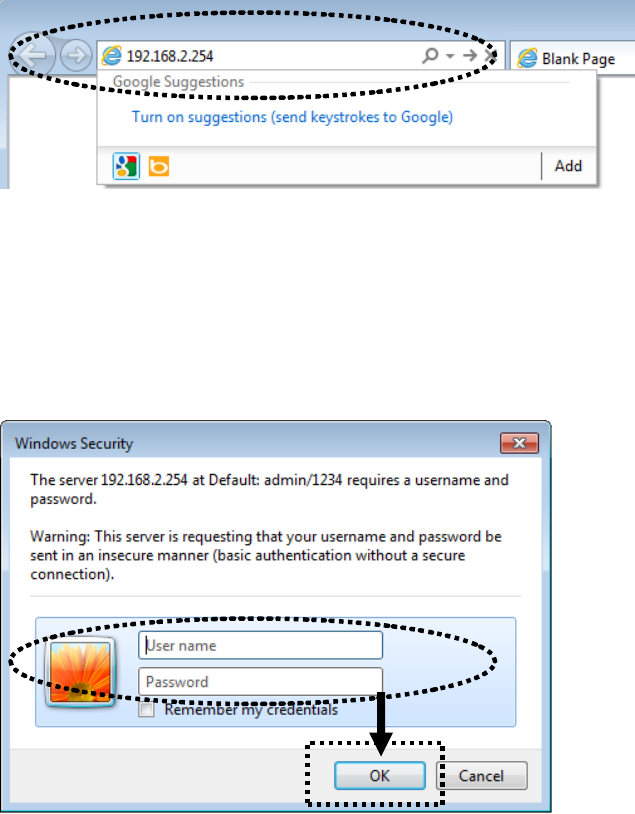
20
2-2-2 Connect to web configuration menu
Please open web browser (IE, firefox, chrome etc.) and input
192.168.2.254 in address bar then press ENTER key:
Wireless repeater will prompt you to input username and password.
Default username is „admin‟ and password is „1234‟. Click „OK‟ button
to continue.
You should be able to see the configuration manual of Wireless repeater
in very short time:
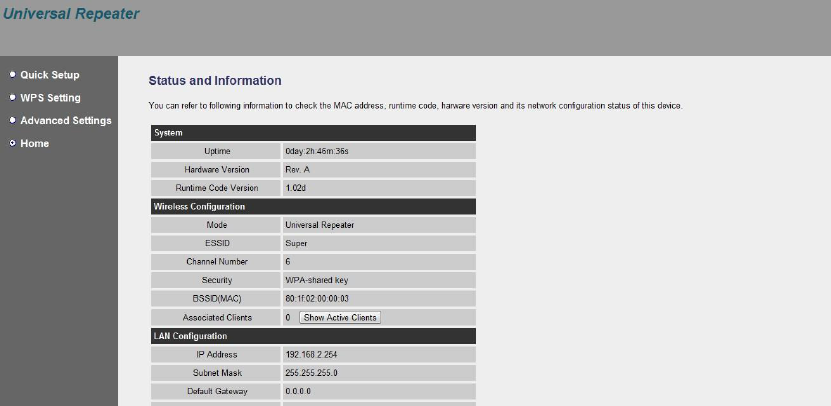
21
Detailed operation instructions will be given to following manual.
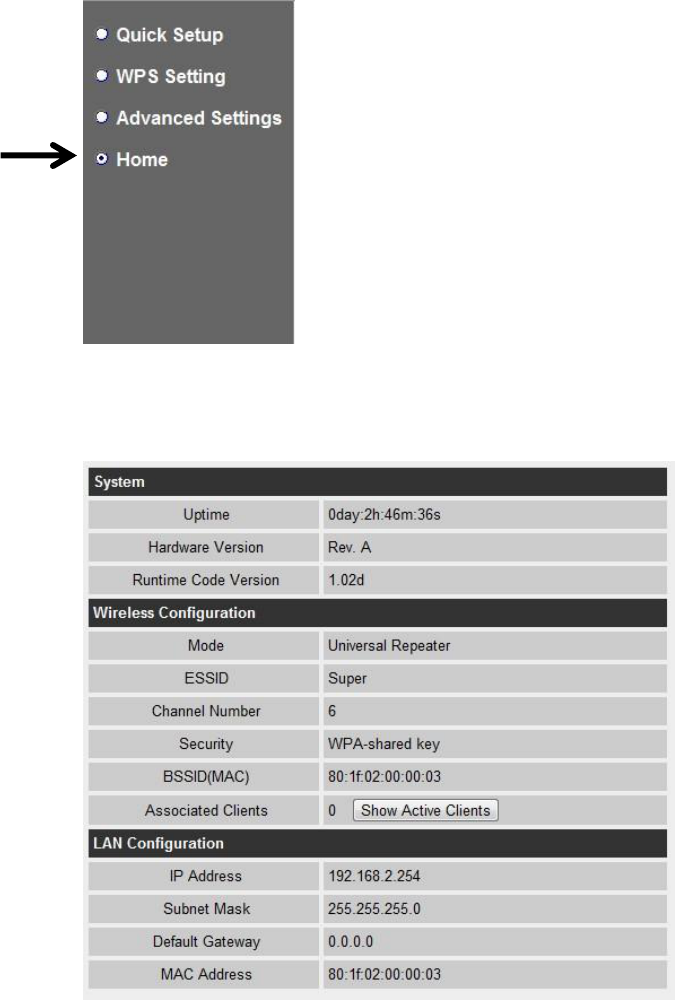
22
2-2-3 Home
The status and information of this wireless repeater will be displayed
here.
To access „Home‟ menu, click „Home‟ on the left.
You should see the screen looks like this (the contents will vary
depending on your actual setting):
You can click „Show Active Clients‟ button to show all connected
23
wireless clients.
Please note: By clicking ‘Show Active Clients’ button, a new browser
window will appear. If your browser prevents pop-up window from
appearing, please disable this function or you will not be able to use
‘Show Client’ function.
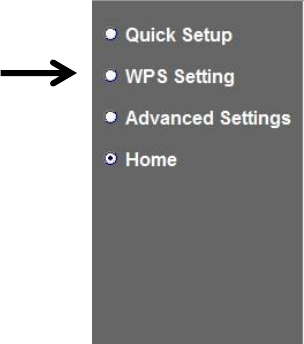
24
2-2-4 WPS Setting
You can configure WPS (Wi-Fi Protected Setup) here. By using WPS,
you can establish secure connection between this wireless repeater with
other wireless devices which also support WPS in a fast and secure
manner.
To access „WPS Setting‟ menu, click „WPS Settings‟ on the left.
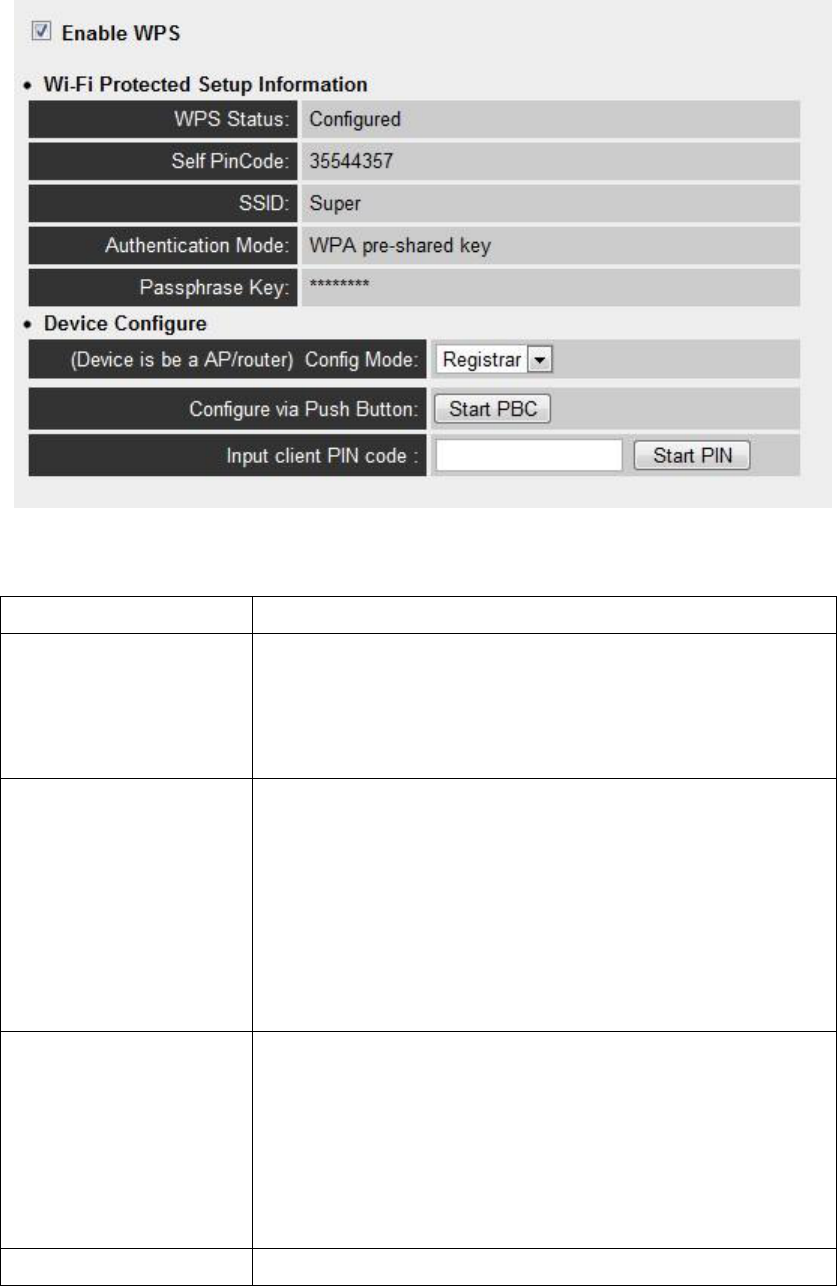
25
The following setup page will appear:
The description of every setup item is listed as follow:
Item
Description
Enable WPS
You can enable or disable WPS function.
Disabling WPS function is included hardware
WPS button function.
Default is „enable WPS‟.
WPS Status
Shows the security setting status of WPS. You
must setup the security setting of this wireless
repeater manually and the WPS status will
become „Configured‟. Currently only WPA
encryption is supported, if you select other
encryption method, WPS status will remain
„Unconfigured‟.
Self PinCode
Here displays an 8-digit number for WPS
PIN-style configuration. When other
WPS-compatible device wish to connect to this
wireless repeater and supports Self-PIN type
WPS, input this number to the wireless device to
establish connection.
SSID
Shows the SSID of this wireless repeater.

26
Authentication
Mode
Shows the authentication mode of this wireless
repeater.
Passphrase Key
Here shows asterisks (*) to indicate wireless
security is properly set.
Config Mode
There are „Registrar‟ and „Enrollee‟ modes for the
WPS connection. When „Registrar‟ is enabled,
the wireless clients will follow the repeater‟s
wireless settings for WPS connection. When
„Enrollee‟ mode is enabled, the repeater will
follow the wireless settings of wireless router for
WPS connection.
Start PBC
Click „Start PBC‟ to start Push-Button style WPS
setup procedure. This wireless repeater will wait
for WPS requests from another wireless device
for 2 minutes.
The „WPS‟ LED on the wireless repeater will be
blinking for 2 minutes when this wireless repeater
is waiting for incoming WPS request.
Start PIN
Please input the PIN code of the wireless client
you wish to connect, and click „Start PIN‟ button.
The „WPS‟ LED on the wireless repeater will be
blinking when this wireless repeater is waiting for
incoming WPS request.
NOTE: For WPS2.0 compliance specification, WEP and WPA-PSK
can’t support WPS connection, some of wireless devices may follow
this latest WPS2.0 specification, so we recommend you not to use
WEP and WPA-PSK to avoid WPS interoperability problem.
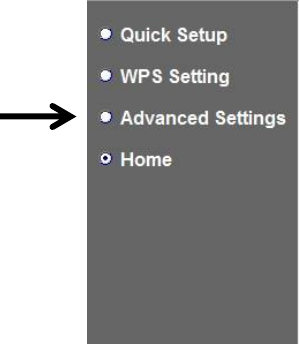
27
2-2-5 Advanced Settings
You can configure advanced wireless settings in this page. Please note
that these settings are not safe to be configured by novice users.
Configure these settings only when you understand what you‟re doing.
To access „Advanced Setting‟ menu, click „Advanced Setting‟ on the left.
The following setup page will appear:
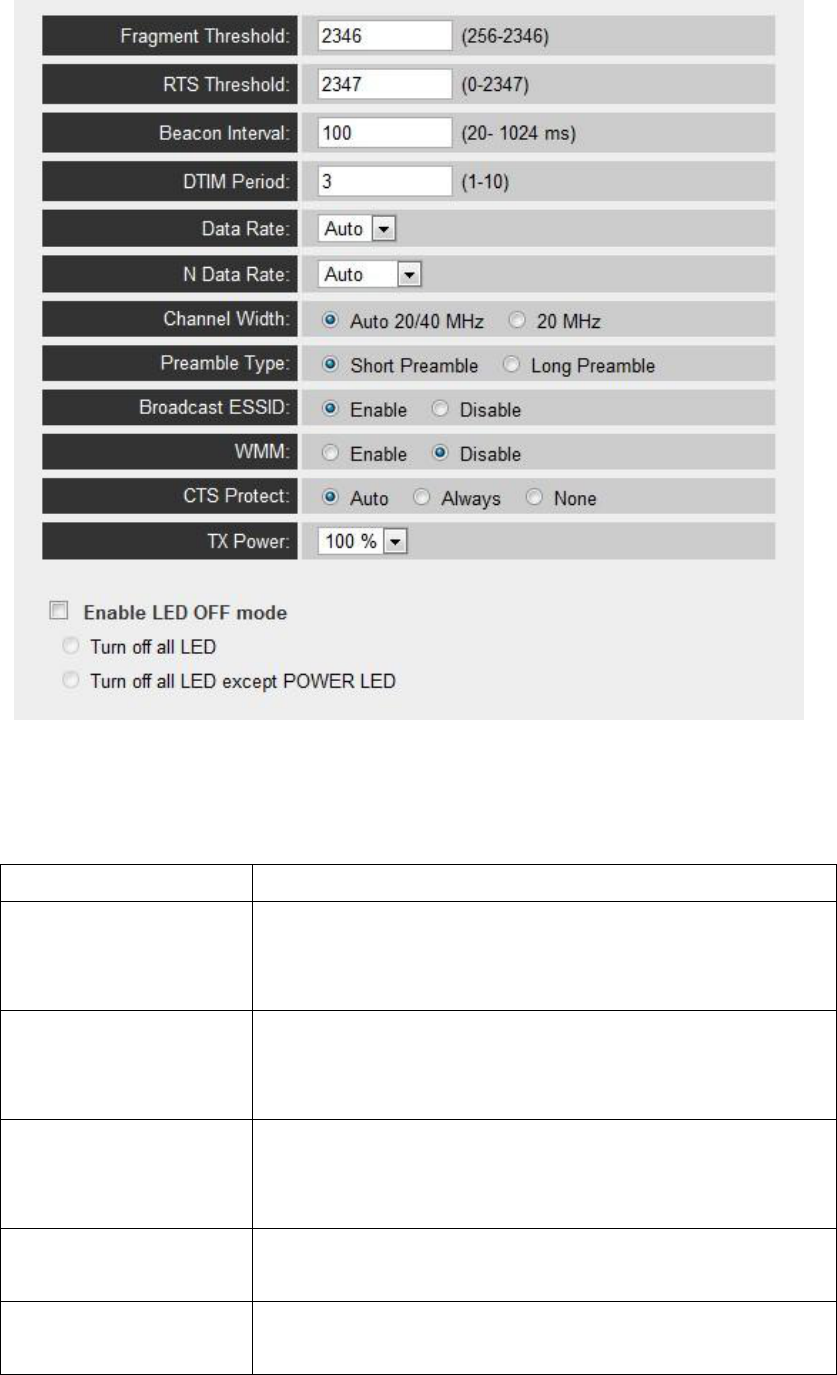
28
The description of every setup item is listed as follow:
Item
Description
Fragment Threshold
Set the Fragment threshold of wireless radio.
Threshold. Do not modify default value if you
don‟t know what it is, default value is 2346.
RTS Threshold
Set the RTS threshold of wireless radio. Do not
modify default value if you don‟t know what it is,
default value is 2347.
Beacon Interval
Set the beacon interval of wireless radio. Do not
modify default value if you don‟t know what it is,
default value is 100.
DTIM Period
Configures DTIM (Delivery Traffic Indication
Message) send period. Default value is 3.
Data Rate
Select wireless data transfer speed. When you
select a value here, this repeater will refuse to

29
establish connection with wireless clients by
other speed.
It‟s recommended to select „Auto‟ and this
wireless repeater will adjust the speed
automatically.
N Data Rate
Select wireless data transfer speed by MCS0 to
MCS7. MCS stands for Modulation and Coding
Scheme, which represents different speed when
bandwidth is 20MHz or 40MHz.
It‟s recommended to select „Auto‟ and this
wireless repeater will adjust the speed
automatically.
Channel Width
Select the wireless channel width, 20MHz or
40MHz. 40MHz provides better network speed
for 802.11n wireless clients.
However, if there‟re 802.11b / g clients
connecting to this wireless repeater, it will switch
to 20MHz mode automatically.
Preamble Type
Set the type of preamble of wireless radio, Do not
modify default value if you don‟t know what it is,
default setting is „Short Preamble‟.
Broadcast ESSID
When set to „enabled‟, every wireless devices can
scan and found this wireless repeater; when set to
„disabled‟, only wireless clients who know exact
SSID can get connected with this wireless
repeater. Set to disabled will help to improve
security.
WMM
Enable or disable Wireless Multi-Media. When
enabled, wireless repeater will give priority to
multimedia related network applications so they
will have better performance.
CTS Protect
This function provides CTS (Clear to Send)
protection when transferring data. It‟s
recommended to select „Auto‟ for this option.
TX Power
Select wireless transmitting power level, from
10% to 100%. When wireless clients are not too
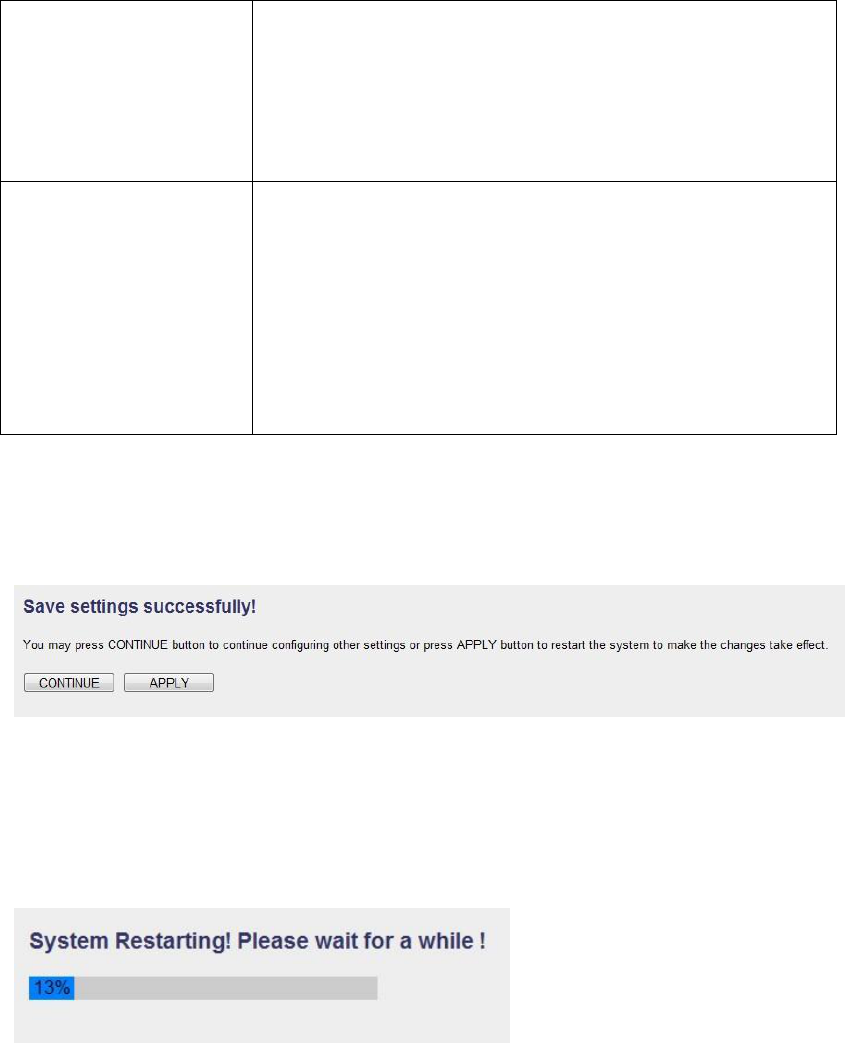
30
far from this wireless repeater, you don‟t have to
select a higher power level, since this may cause
some people to try to break into your wireless
network when you have a bad password or no
password.
Enable LED off
mode
You can enable or disable LED lights
Check „Enable LED OFF‟ mode to setup LED
behavior:
Turn off all LED: disabled all LED lights
Turn off all LED except POWER LED: all LED
lights will be disabled, except „POWER‟ LED
When you finish settings in this page, click „Apply‟ button. You‟ll see the
following message:
If you still need to configure this wireless repeater, click „CONTINUE‟
button; if you want to save changes and make it work now, click „APPLY‟
button.
You‟ll be prompted to wait for 30 seconds before you can reconnect to
this wireless repeater.
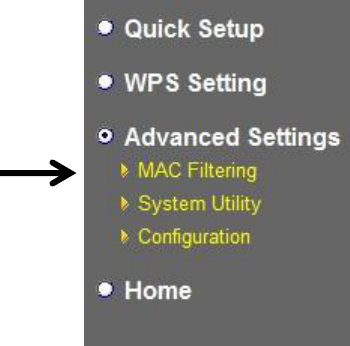
31
2-2-6 MAC Address Filtering
Besides using wireless security to only allow permitted wireless users to
use this wireless repeater, you can also use MAC address filter to allow
wireless users with certain MAC address to use this wireless repeater.
This will enhance security because you can make a „white list‟ to allow
users on the list to use this wireless repeater only in advance. For those
clients who don‟t list on this white list can‟t get connected, even he or she
know the password.
To access „MAC Filtering‟ menu, click „MAC Filtering‟ on the left.
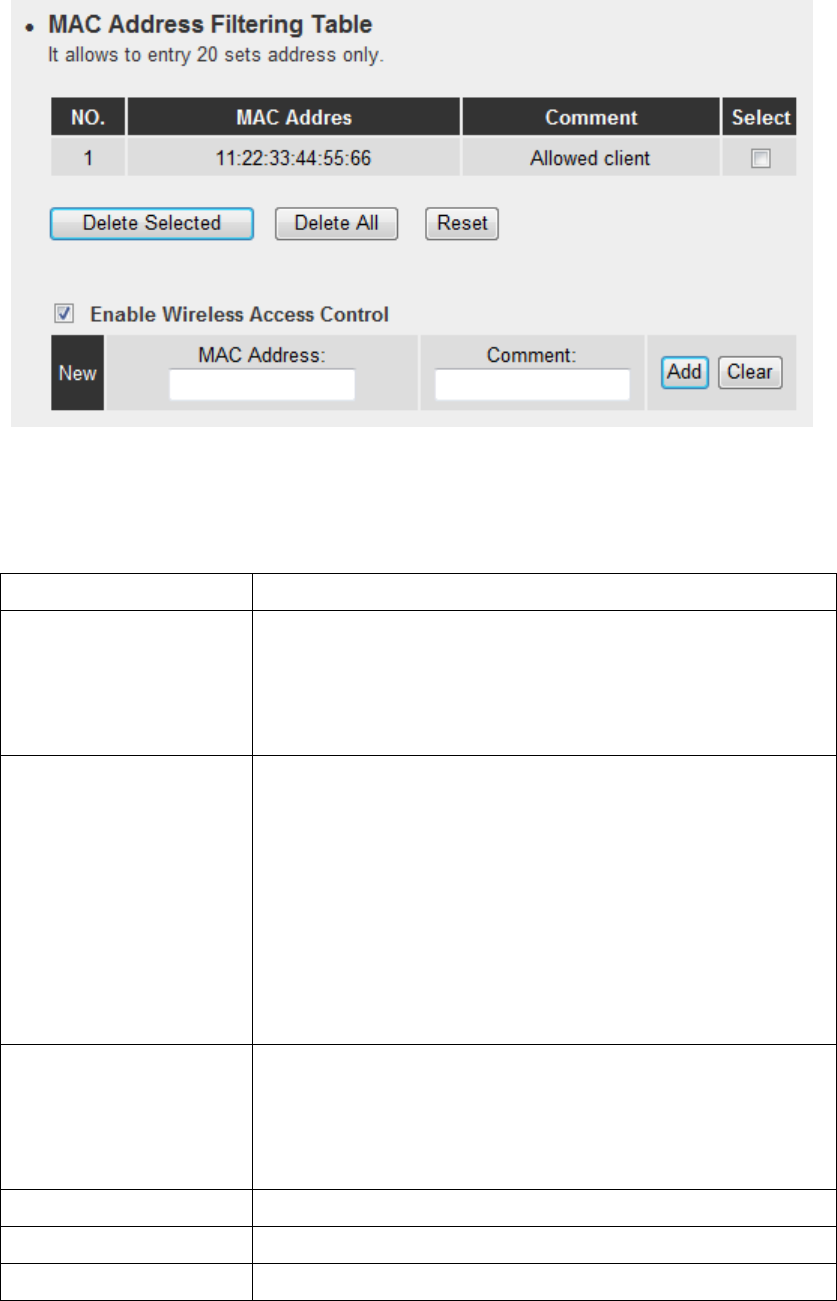
32
The following setup page will appear:
The description of every setup item is listed as follow:
Item
Description
Enable Wireless
Access Control
Check this box to enable MAC filtering. If you
didn‟t check this box, anyone who knows the
wireless password can get connected to this
wireless repeater.
MAC Address
Input the MAC address of the clients you wish to
deny or accept to access the repeater into the
MAC address list. Please input 12 HEX
characters here, and you don‟t have to add :
(colon) or - (dash) characters every 2 characters.
If you don‟t know how to get the MAC address of
a network client, see tips below.
Comment
Input any descriptive text about this rule, so you
can remember the purpose of this rule. You can
input up to 20 alphanumerical characters in this
field.
Add
Add this MAC address to the list.
Clear
Clear „MAC Address‟ and „Comment‟ field.
Delete Selected
Delete MAC address(es) you selected which
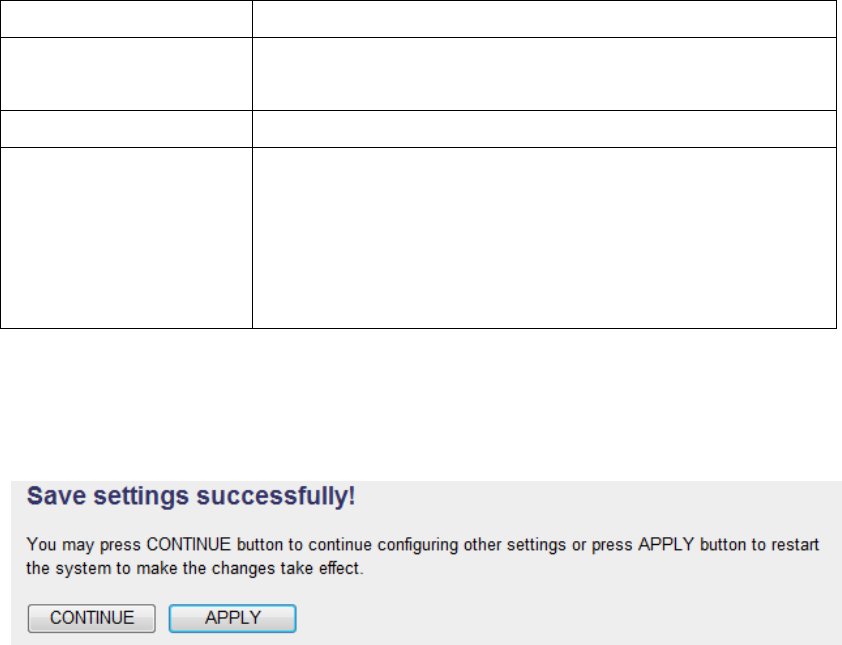
33
„Select‟ box is checked.
Delete All
Delete all MAC addresses in the list. You‟ll be
prompted to confirm deletion first.
Reset
Uncheck all checked boxes.
Select
All existing MAC addresses will be listed here.
To delete a MAC address from the list, check the
box of the MAC address you wish to delete first.
You can select more than one MAC addresses
here.
When you finish settings in this page, click „Apply‟ button. You‟ll see the
following message:
If you still need to configure this wireless repeater, click „CONTINUE‟
button; if you want to save changes and make it work now, click „APPLY‟
button. You‟ll be prompted to wait for 30 seconds before you can
reconnect to this wireless repeater.
TIPS: If you don‟t know the MAC address of your computer or wireless
device, you can follow the following procedure:
For wireless devices and computers which are connected to this wireless
repeater already, you can click „Show Active Clients‟ button in „Home‟
setting page.
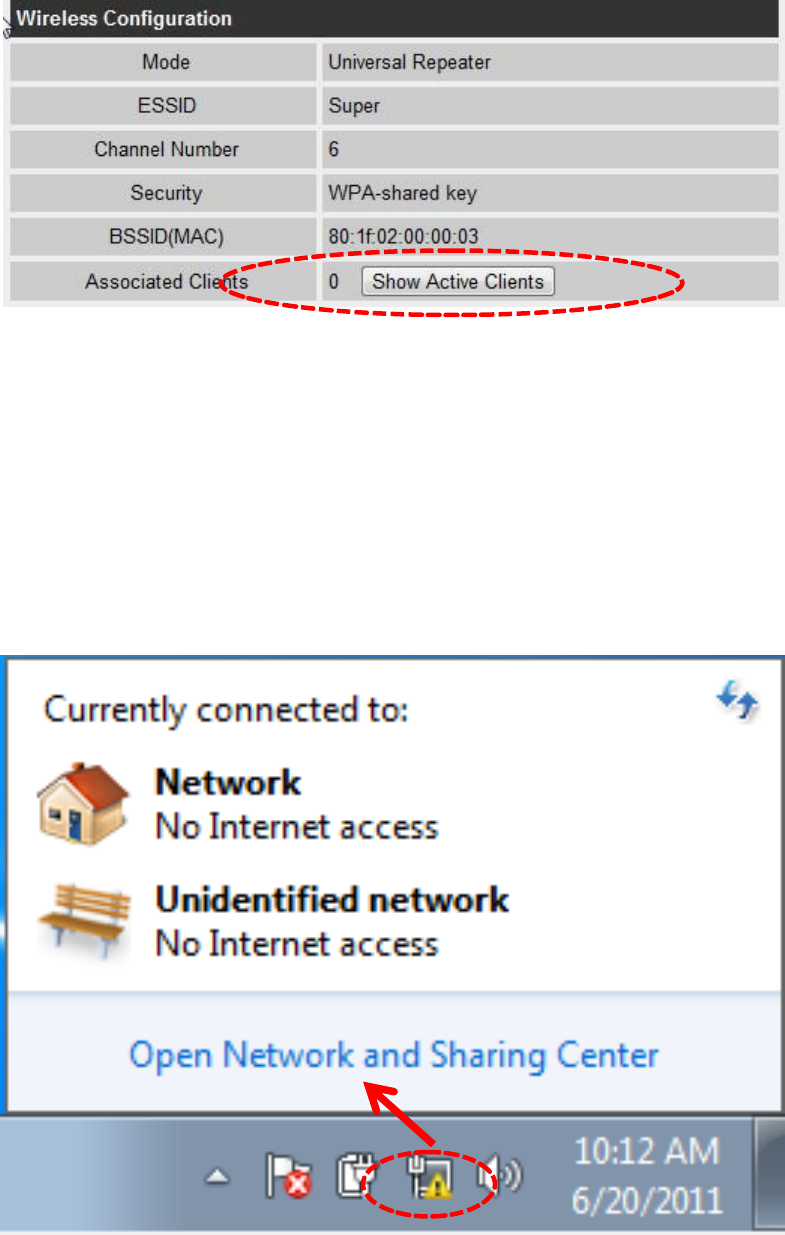
34
Their MAC address will be displayed at „MAC Address‟ field.
If you still can‟t identify the MAC address of computer, you can follow
the following procedure:
Click the network icon located at the lower-right corner, then click „Open
Network and Sharing Center‟.
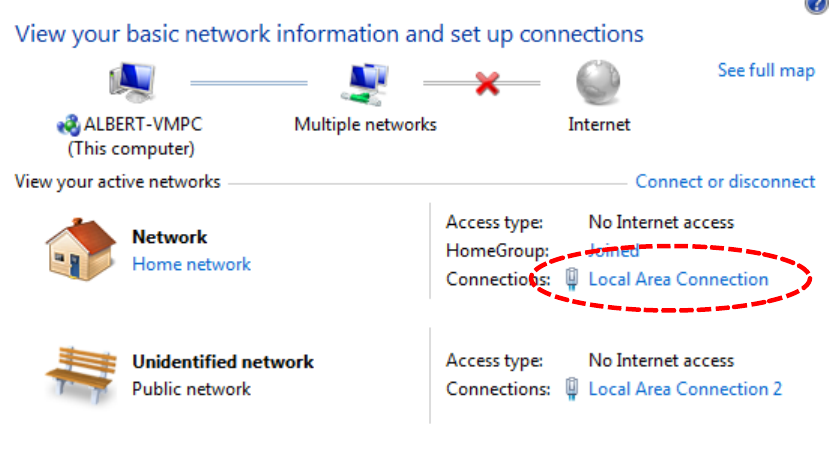
35
Click the connection that you‟ll be used to connect the wireless repeater
(in this example, „Local Area Connection‟):
Click „Details…‟ button.
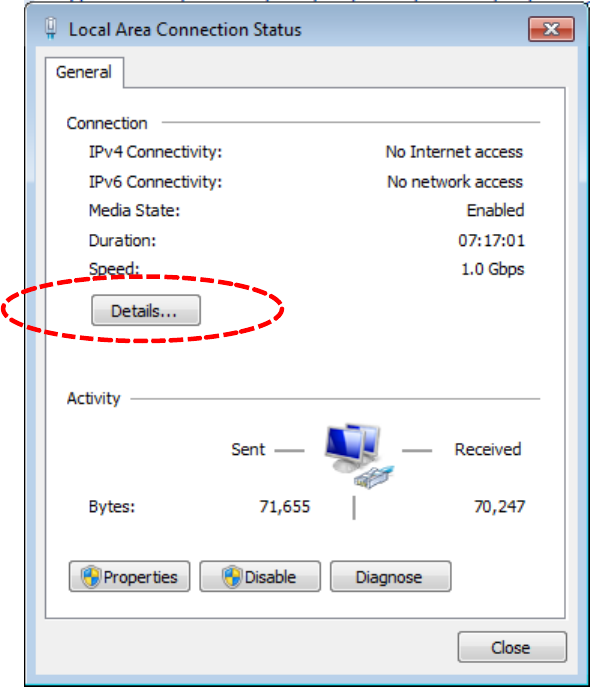
36
The MAC address of selected network connection will be displayed here
as „Physical Address‟.
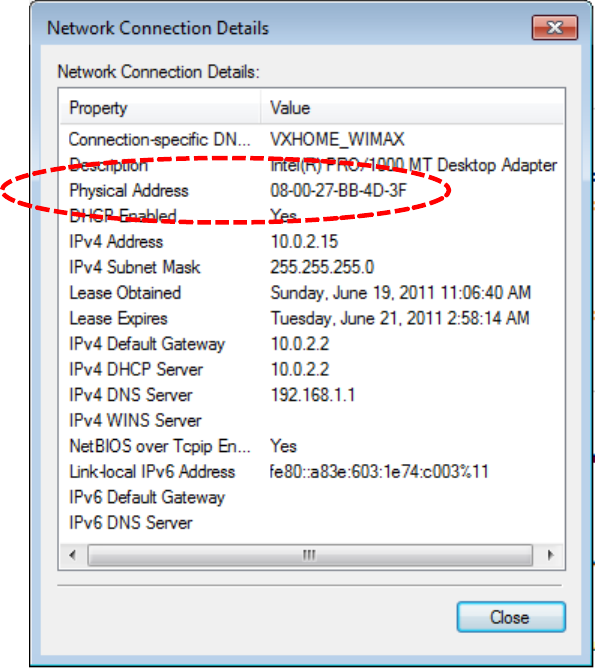
37
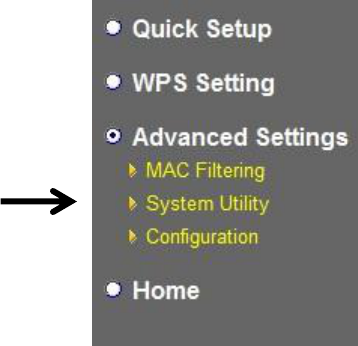
38
2-2-7 System Utility
You can change the settings of several system-level parameters in this
page, including administrator‟s password, and IP address.
To access „System Utility‟ menu, click „System Utility‟ on the left.
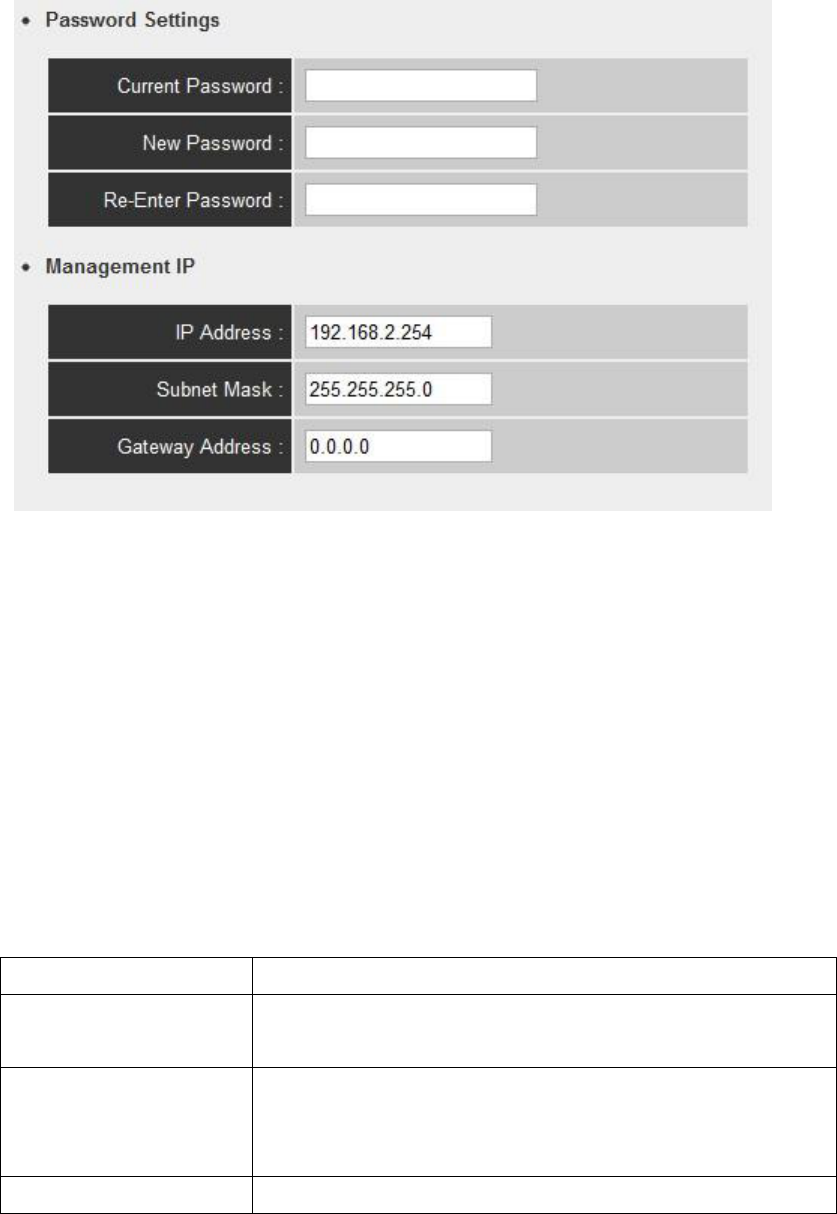
39
The following setup page will appear:
The description of every setup item is listed as follow:
Password Settings
Default password of this repeater is 1234, and it‟s displayed on the login
prompt when accessed from web browser. There‟s a security risk if you
don‟t change the default password, since everyone can see it. This is very
important when you have wireless function enabled.
Here are descriptions of every setup items:
Item
Description
Current Password
To change password, you have to input current
password first.
New Password
Input new password here. You can use the
combination of alphabets, number, and symbols
for up to 20 characters.
Re-Enter Password
Input new password again for conformation.
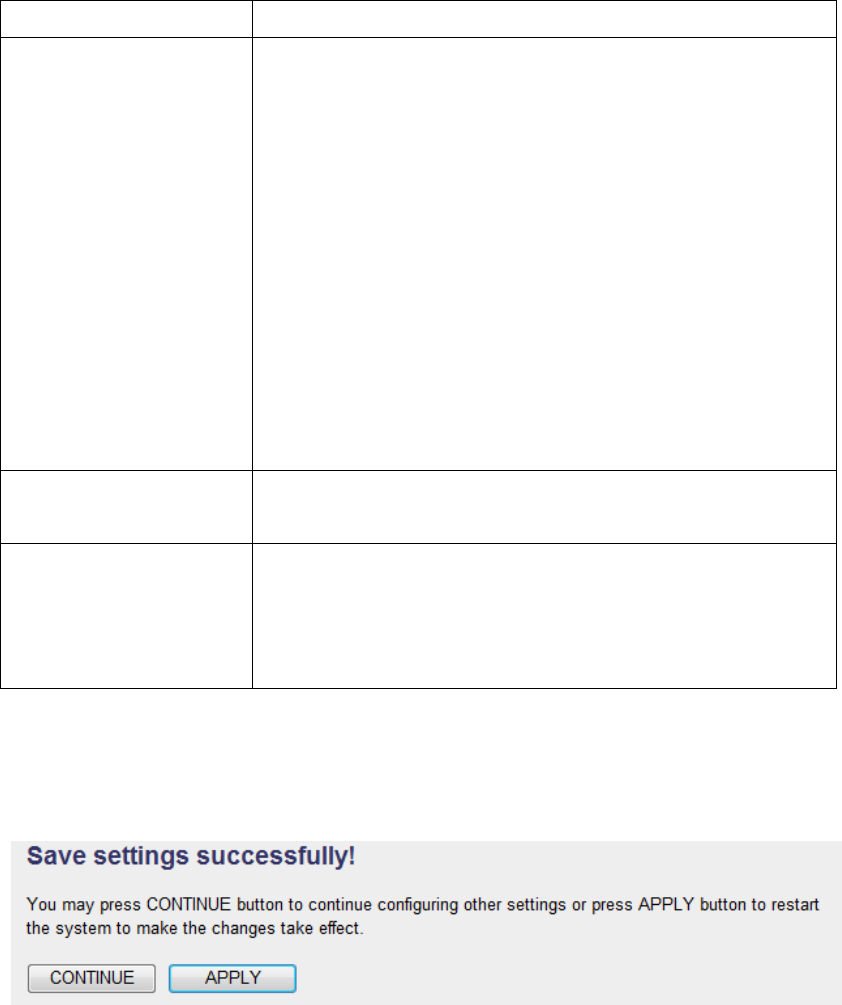
40
Management IP
To set up the IP address of this wireless repeater, please see the following
description.
Item
Description
IP Address
Input the IP address of LAN / Wi-Fi port of this
wireless repeater.
NOTE: Please remember this IP address. If you
forget this IP address and you didn‟t use DHCP
server function to assign IP address to clients,
you‟ll not be able to connect to this wireless
repeater and you‟ll need to clear all settings and
password to reset the IP address back to default
value „192.168.2.254‟.( Press WPS button and
hold for 10 seconds to restore all settings to
factory defaults)
Subnet Mask
Input the subnet mask of the IP address you‟re
using.
Gateway Address
Input the gateway‟s IP address of your network.
Generally you can use „0.0.0.0‟ (default value)
since this wireless repeater will access Internet
via WAN port.
When you finish settings in this page, click „Apply‟ button. You‟ll see the
following message:
If you still need to configure this wireless repeater, click „CONTINUE‟
button; if you want to save changes and make it work now, click „APPLY‟
button. You‟ll be prompted to wait for 30 seconds before you can
reconnect to this wireless repeater.
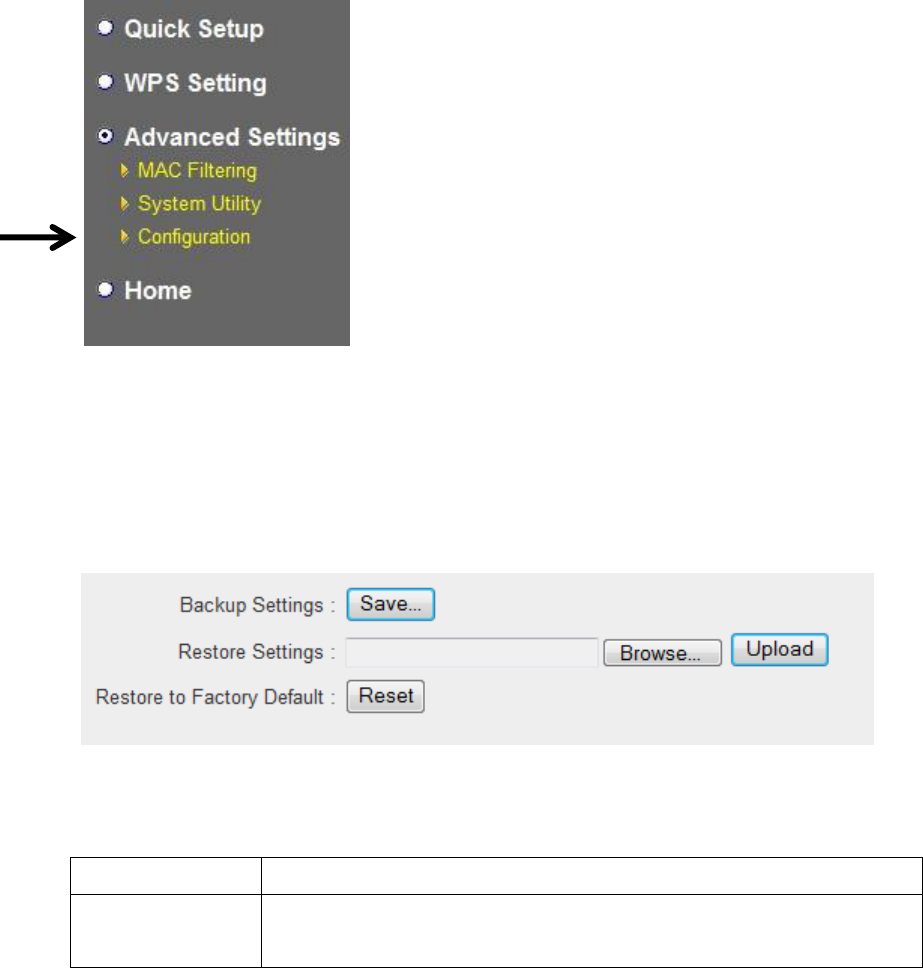
41
2-2-8 Configuration
You can backup and restore the configuration of this wireless repeater, so
you can recall all settings back in very short time, without doing
configuration again.
This function is especially useful when you need to use this mini Wi-Fi
repeater in different places, like home and hotel.
To access „Configuration‟ menu, click „Configuration‟ on the left.
Configuration Tool
The following setup page will appear:
The description of every setup item is listed as follow:
Item
Description
Backup
Settings
Click „Save‟ button to save the current settings to a file
on your computer.
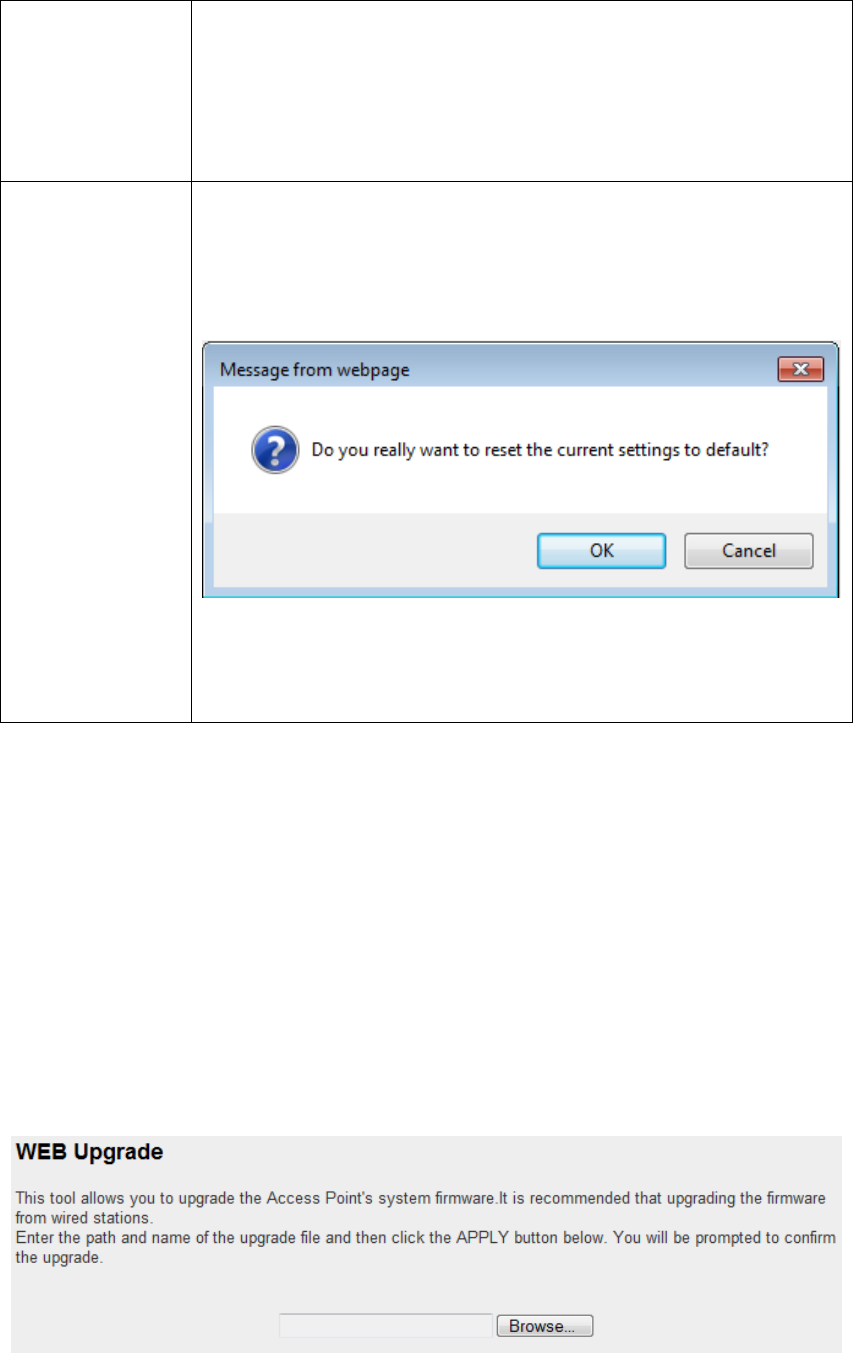
42
Restore
Settings
If you want to upload a saved configuration file to
wireless repeater, please click „Browse‟ button to select
a saved configuration file on your computer. Then
click ‟Upload‟ button to restore the current settings to
new one.
Reset to
Factory
Default
To reset all settings of this wireless repeater to factory
defaults, including password. You‟ll be prompted to
confirm the settings reset:
Click „OK‟ if you really want to restore all settings, or
click „Cancel‟ to abort.
WEB Upgrade
The software running in this wireless repeater (i.e. „Firmwre‟) can be
upgraded to improve the functionality of this wireless repeater.
You can access our website to look for latest firmware file. Then
download the latest firmware file and save on your computer and upload
to this wireless repeater.
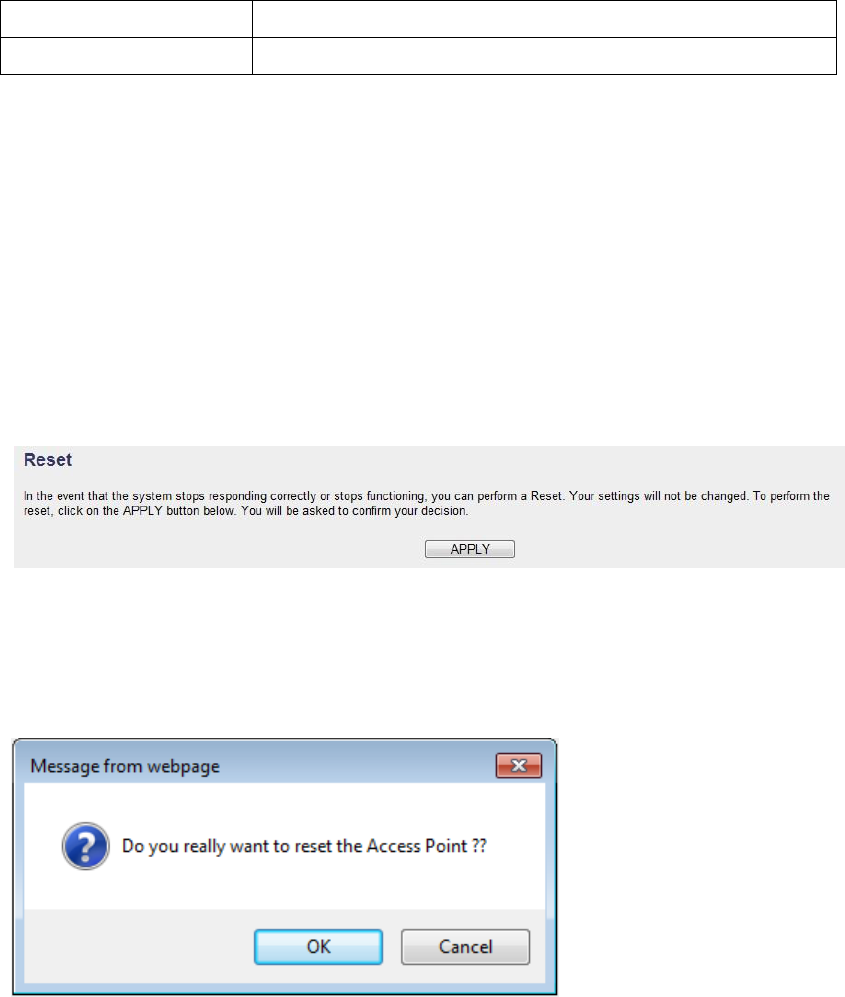
43
The description of every setup item is listed as follow:
Item
Description
Browse
Select a firmware file saved on your computer.
When you are ready, click „Apply‟ button to start firmware upgrade
procedure.
Reset
When you think this wireless repeater is not working properly, resetting it
may help.
To reset this wireless repeater, click „Apply‟ button. You‟ll be prompted
to confirm reset:
Click „OK‟ button to reset wireless repeater, or click „Cancel‟ to abort.
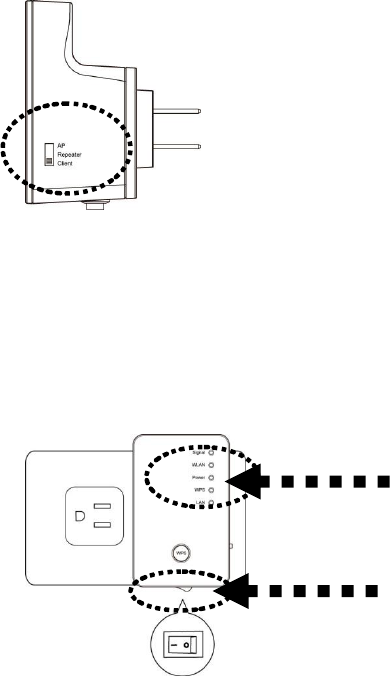
44
CHAPTER III: Client mode
Client mode can let your networking device have wireless capability; it
will become your networking device‟s wireless network card. You can
connect this device to Ethernet port of your existing internet TV or DVD
player or game console device with Ethernet cable.
This chapter will show you how to quickly install this device by using
quick setup and show you the each detailed setting on web UI page of
client mode.
3-1 Client mode Quick Installation Guide
Switch mode selector to „Client‟.
Insert this device into power outlet on the wall, and switch wireless
repeater‟s power switch to „ON‟ (1). You should see „Power‟ LED light
up in few seconds (2). If not, please check if the power outlet you‟re
using is working.
(2)
(1)
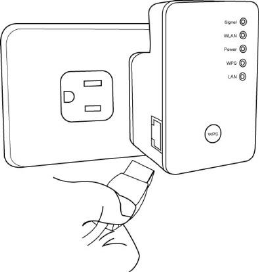
45
Connect your wired networking device(wired PC, or internet TV, or game
console..etc.) and this device by Ethernet cable.
NOTE: You must set your networking device as DHCP client (obtain IP
automatically from DHCP server)
You can build wireless connection via „Hardware WPS button‟ or
„Software web browser‟.
If your broadband router or access point also supports „WPS button‟, we
recommend you to use WPS button to establish connection, it is the fast
and secure way without computer.
Using WPS button - please go to section 3-1-1
Using Web browser - please go to section 3-1-2
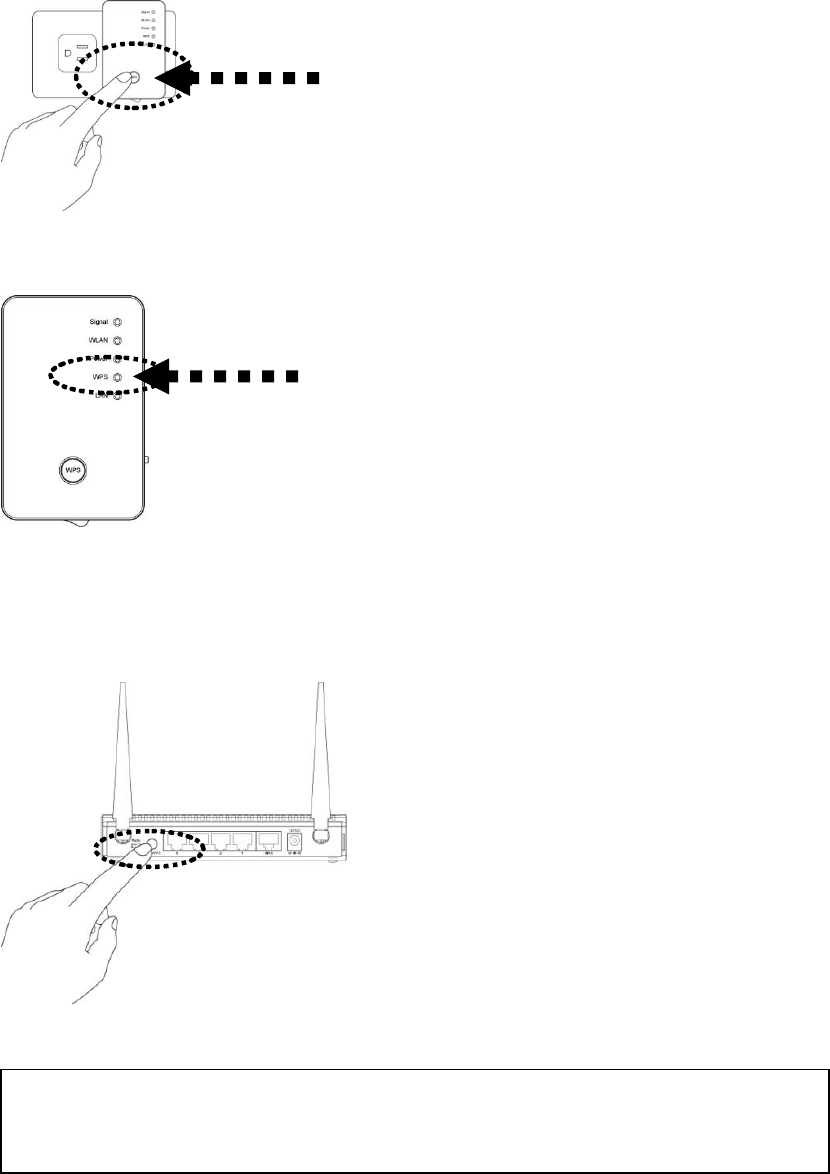
46
3-1-1 Hardware WPS button setup
(1) Press and hold WPS button on repeater for 2 seconds, „WPS‟ LED
will start flashing.
(2) Press WPS button on the wireless broadband router or access point
you wish to connect within 2 minutes.
WPS LED
WPS button
NOTE: this WPS button position on access point is for example,
different device may have different WPS button position.
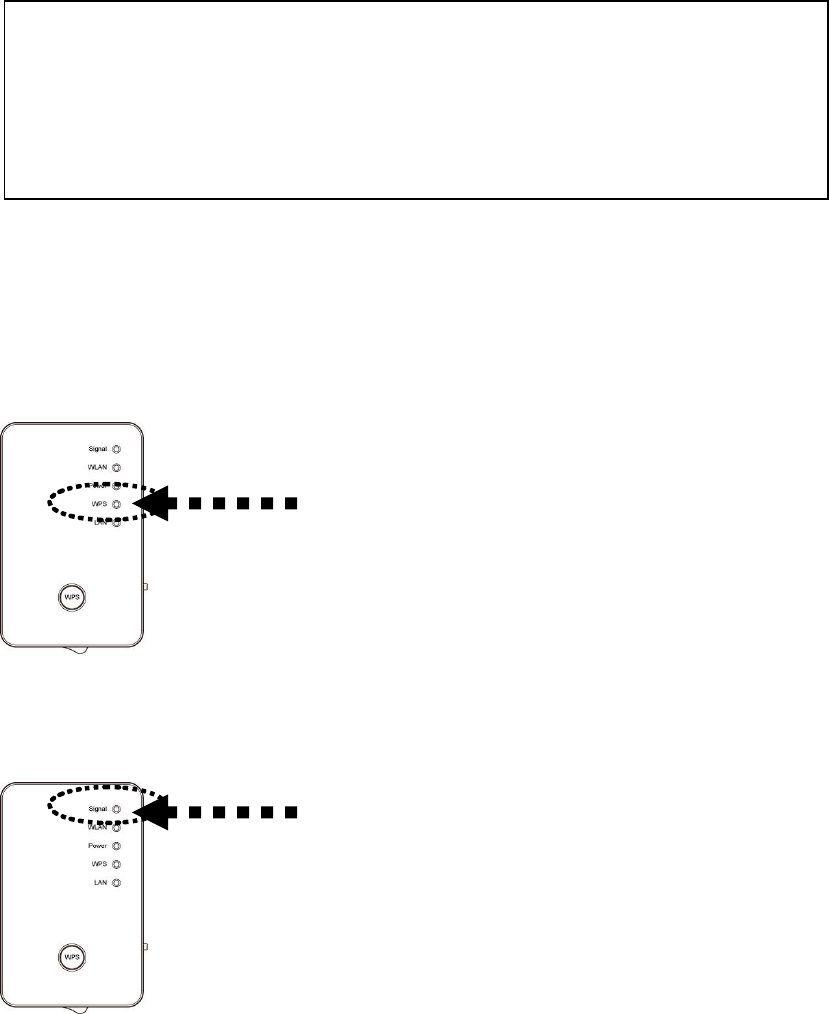
47
(3) If WPS connection is successfully established, „WPS‟ LED will light
for 5 minutes; if „WPS‟ LED flashes fast, there‟s something error, please
wait for 2 minutes until „WPS‟ LED off, and try from step(1) again.
When quick installation is successfully done, „Signal” LED will turn on.
(4) Connecting this device and your networking device (internet TV or
game console etc.) with Ethernet cable, the wireless connection will be
established automatically.
You can check „Signal‟ LED status to understand signal reception level.
Steady light: Excellent, Flash: Good, Fast flash: poor.
TIP: If the access point you wish to connect does not have hardware
WPS button, you can also use its web configuration menu’s WPS
function to establish connection. Or you can login this repeater web
UI to have quick setup (detailed setup refers to ‘3-1-2 Web browser
quick setup’ manual)
manual)
WPS LED
Signal LED

48
The quick installation setup is completely done, you can refer to „3-2
Client mode Advanced Settings‟ to login in web UI for other advanced
settings.
NOTE: If the Signal LED is off, it means this place is out of wireless
signal of your wireless broadband router or access point, please
move this repeater closer to broadband router until repeater device
can receive signal from broadband router.
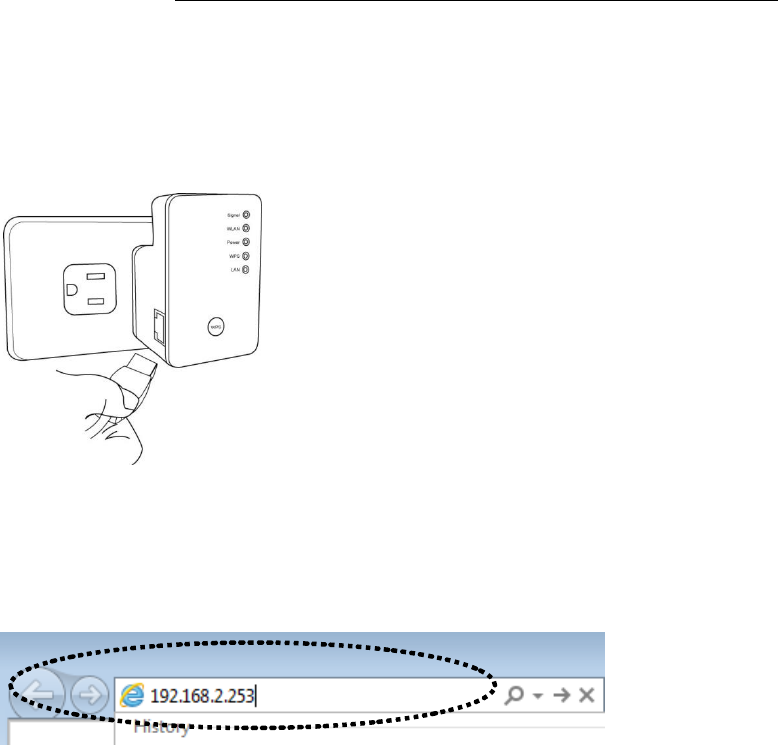
49
3-1-2 Web browser quick setup
Before you can connect to the repeater and start configuration procedures,
your computer must be able to get an IP address automatically (use
dynamic IP address). If it‟s set to use static IP address, or you‟re unsure,
please refer to „Chapter X: Appendix, 5-1 Configuring TCP/IP on PC‟ to
set your computer to use dynamic IP address.
(1)Use Ethernet cable to connect your computer‟s Ethernet port and this
wireless repeater‟s Ethernet port.
(2)Open web browser and input „http://repeater‟ in address bar. (or you
can input the default IP address „192.168.2.253‟)
(3)Wireless repeater will prompt you to input username and password.
Default username is „admin‟ and password is „1234‟. Click „OK‟ button
to continue.
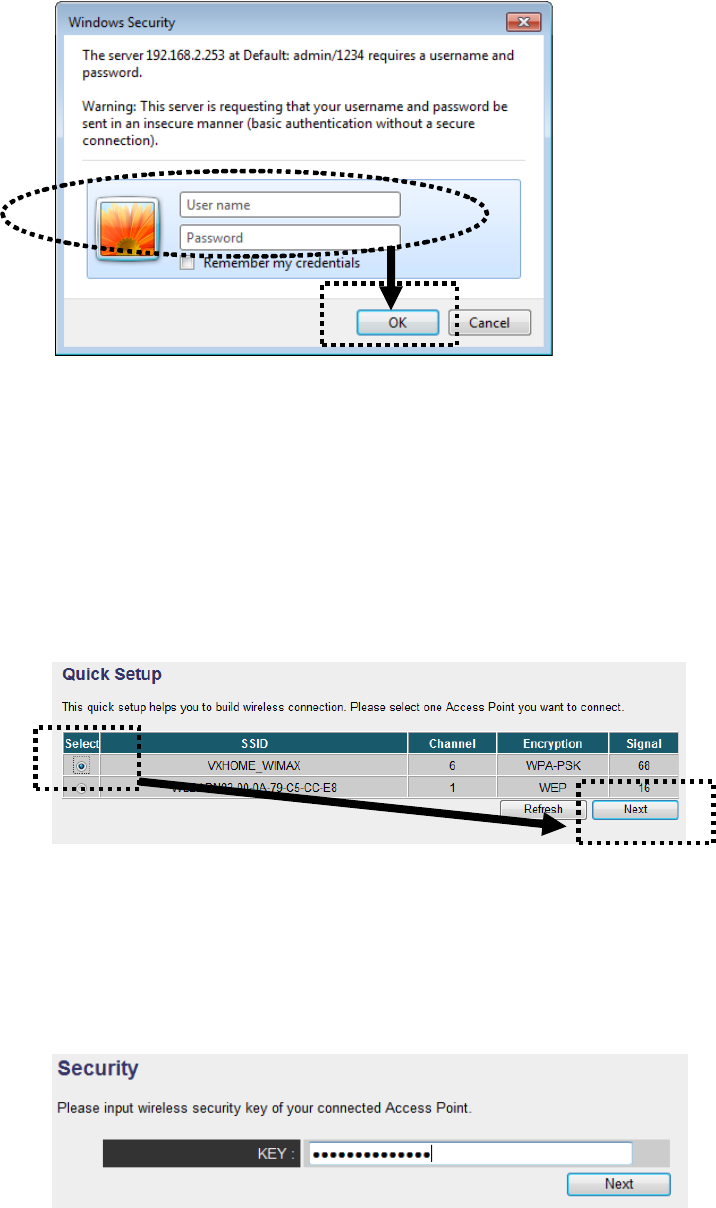
50
(4)All wireless access points nearby will be displayed on the list. Select
one access point you want to connect and click „Next‟ button to continue.
If the access point you wish to connect does not appear here, please click
„Refresh‟ until it appears on the list, or try to move this wireless repeater
closer to the access point you wish to connect.
(5)You‟ll be prompted to input access point‟s wireless security key, input
it in „KEY‟ field and click „Next‟ to continue.
(6) Wireless repeater will display the connection information for you, if
everything‟s correct, please click „APPLY‟ button to get connected.
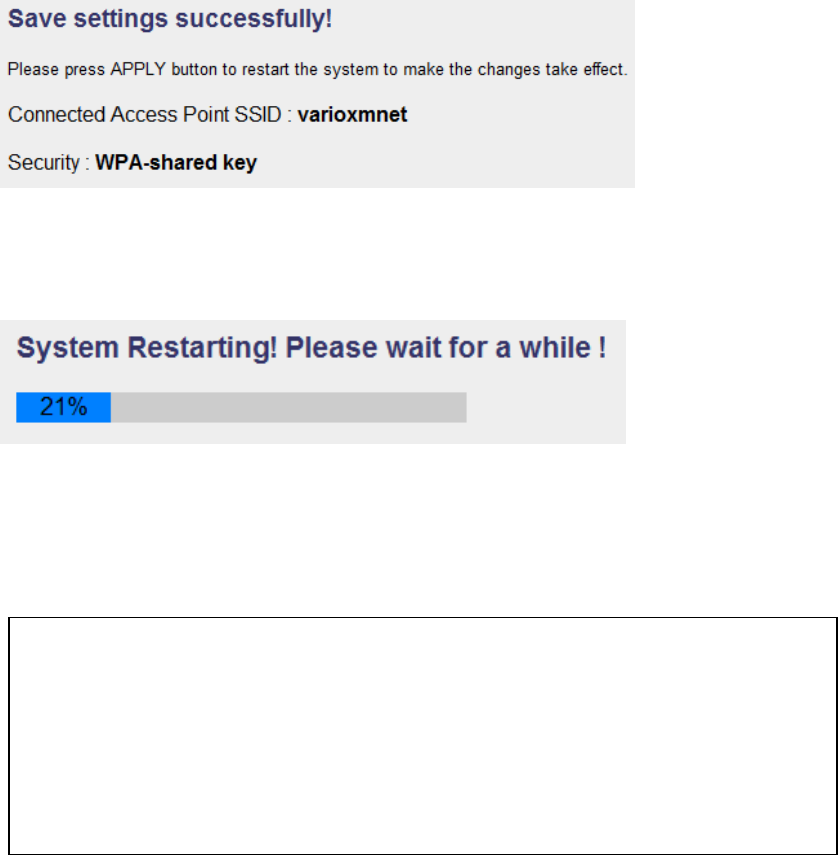
51
„Connected Access Point SSID‟ is the SSID of your access point that you
selected to connect in previous step, please double confirm all
information is correct, if you want to change it, you can press „Back‟ to
select again or press „APPLY‟ to take this change effect.
(7)Please wait for few seconds for wireless repeater to reboot.
(8) After reboot complete, web browser will login client mode‟s home
page of Web UI. You can close browser and start using network.
NOTE: After wireless connection of this repeater and wireless
broadband router is built, this device becomes DHCP client and will
get IP address from your broadband router automatically. If you want
to login Web UI of this repeater again, please refer to ‘3-2 Client mode
Advanced Settings’ for more functions setup or learn how to login
web UI again.
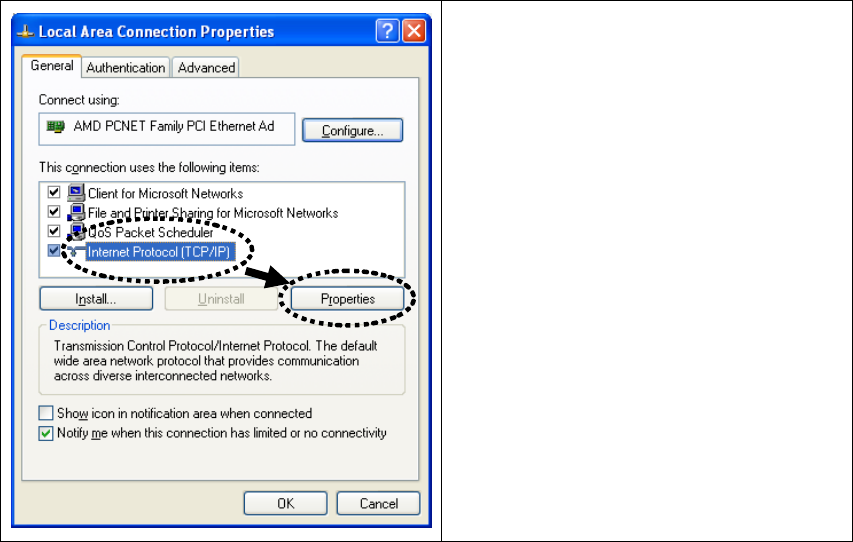
52
3-2 Client mode Advanced Settings
3-2-1 Setup IP address
Default IP address of Client mode is 192.168.2.253, please make sure
your PC‟s IP is within the range of 192.168.2.2~192.168.2.252.
Before you can login web UI, you can set your computer‟s IP address to
any IP within this subnet. If you don‟t know how to do this, please refer
to following instructions.
Windows XP IP address setup:
Click ‘Start’ button (it should be
located at lower-left corner of your
computer), then click control panel.
Double-click Network and Internet
Connections icon, click Network
Connections, and then double-click
Local Area Connection, Local
Area Connection Status window
will appear, and then click
‘Properties’
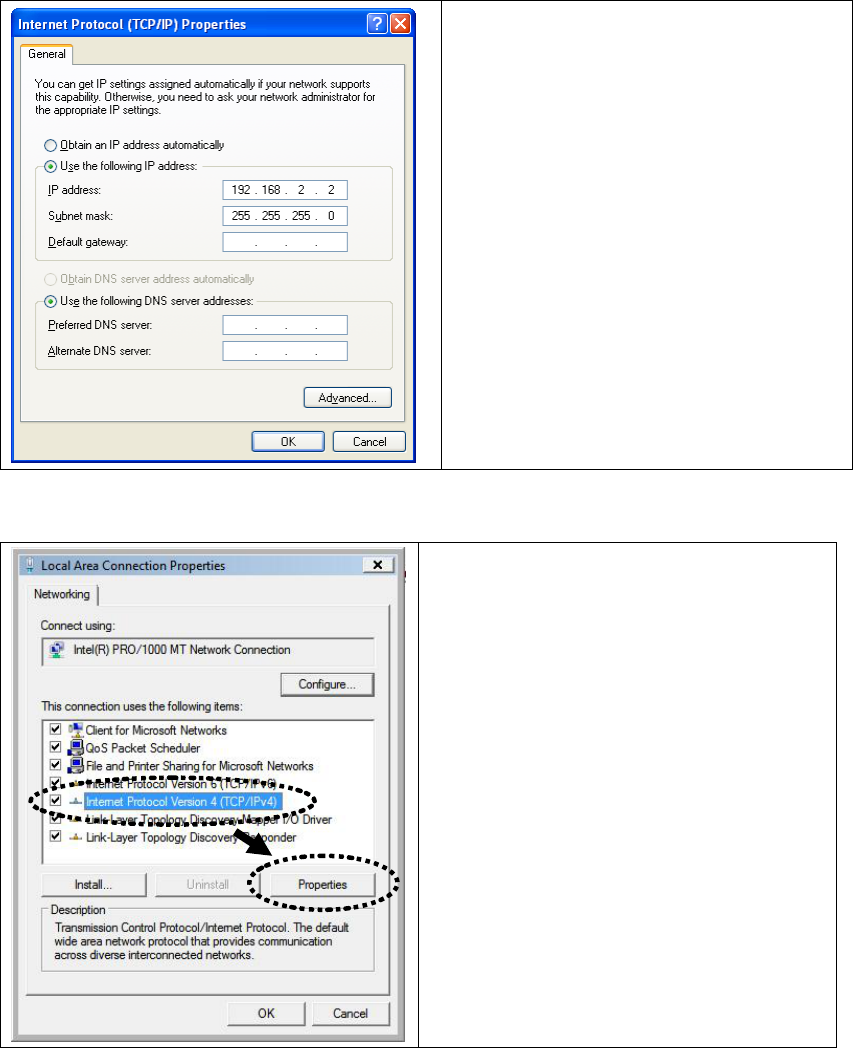
53
Select ‘Use the following IP
address’, then input the following
settings in respective field:
IP address: 192.168.2.x (where x is
an integer greater or less than 200, if
there’s more than one computer
need to use this wireless
presentation gateway on the same
network, every computer should use
an unique number)
Subnet Mask: 255.255.255.0
Click ‘OK’ when finish.
Windows Vista/7 IP address setup:
Click ‘Start’ button (it should be
located at lower-left corner of your
computer), then click control panel.
Click View Network Status and
Tasks, then click Manage Network
Connections..Right-click Local
Area Netwrok, then select
‘Properties’. Local Area
Connection Properties window will
appear, select ‘Internet Protocol
Version 4 (TCP / IPv4), and then click
‘Properties’
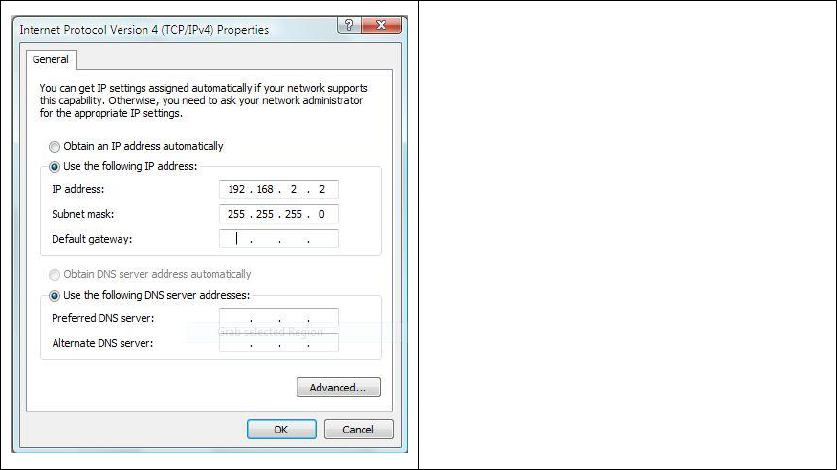
54
Select ‘Use the following IP address’,
then input the following settings in
respective field:
IP address: 192.168.2.x (where x is
an integer greater or less than 200, if
there’s more than one computer need
to use this wireless presentation
gateway on the same network, every
computer should use an unique
number)
Subnet Mask: 255.255.255.0
Click ‘OK’ when finish.
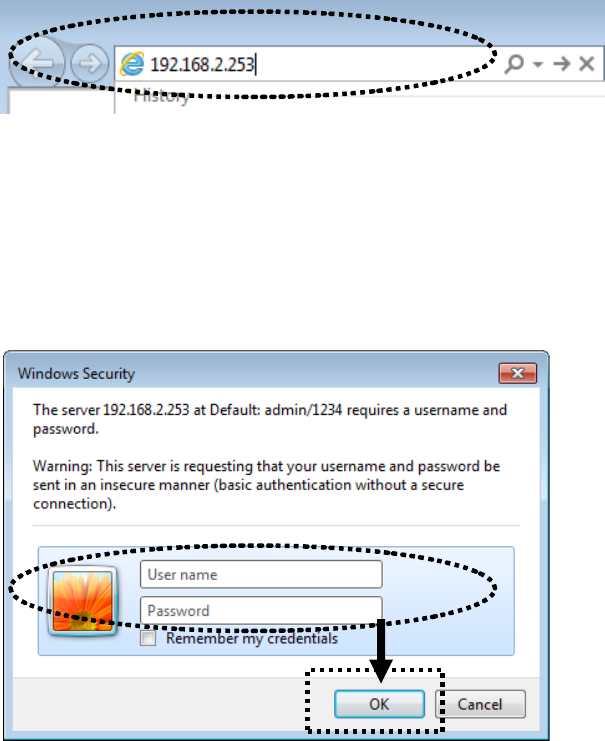
55
3-2-2 Connect to web configuration menu
Please open web browser (IE, firefox, chrome etc.) and input
192.168.2.253 in address bar then press ENTER key:
Wireless repeater will prompt you to input username and password.
Default username is „admin‟ and password is „1234‟. Click „OK‟ button
to continue.
You should be able to see the configuration manual of Client mode in
very short time:
Detailed operation instructions will be given to following manual.
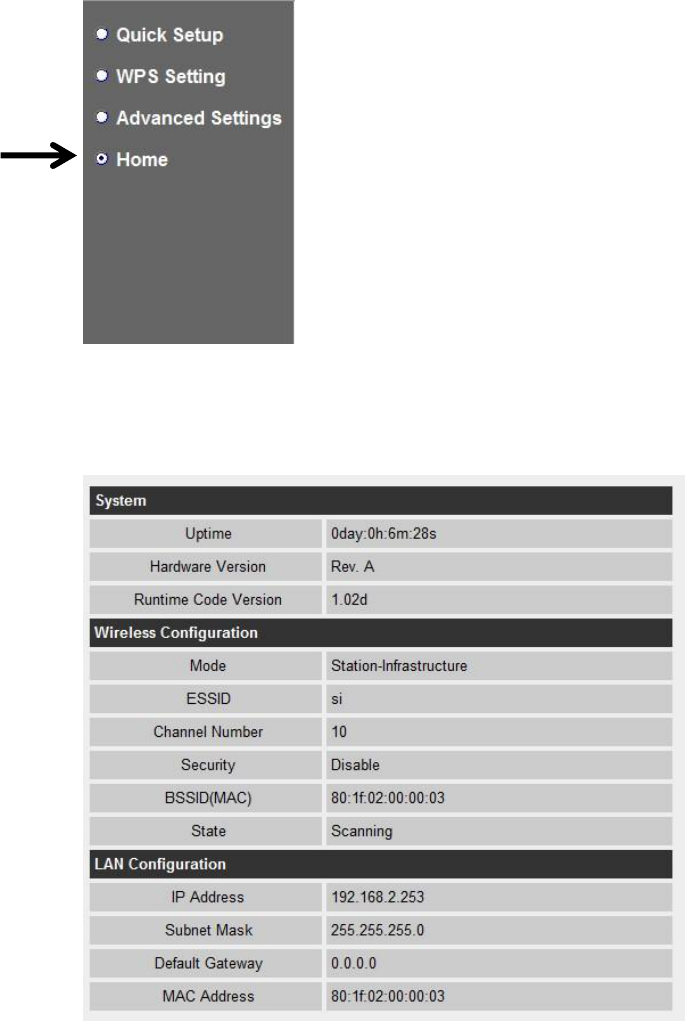
56
3-2-3 Home
The status and information of client mode will be displayed here.
To access „Home‟ menu, click „Home‟ on the left.
You should see the screen looks like this (the contents will vary
depending on your actual setting):
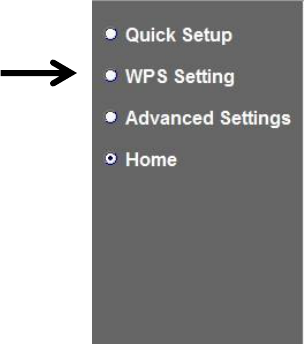
57
3-2-4 WPS Setting
You can configure WPS (Wi-Fi Protected Setup) here. By using WPS,
you can establish secure connection between this wireless repeater with
other wireless devices which also support WPS in a fast and secure
manner.
To access „WPS Setting‟ menu, click „WPS Settings‟ on the left.
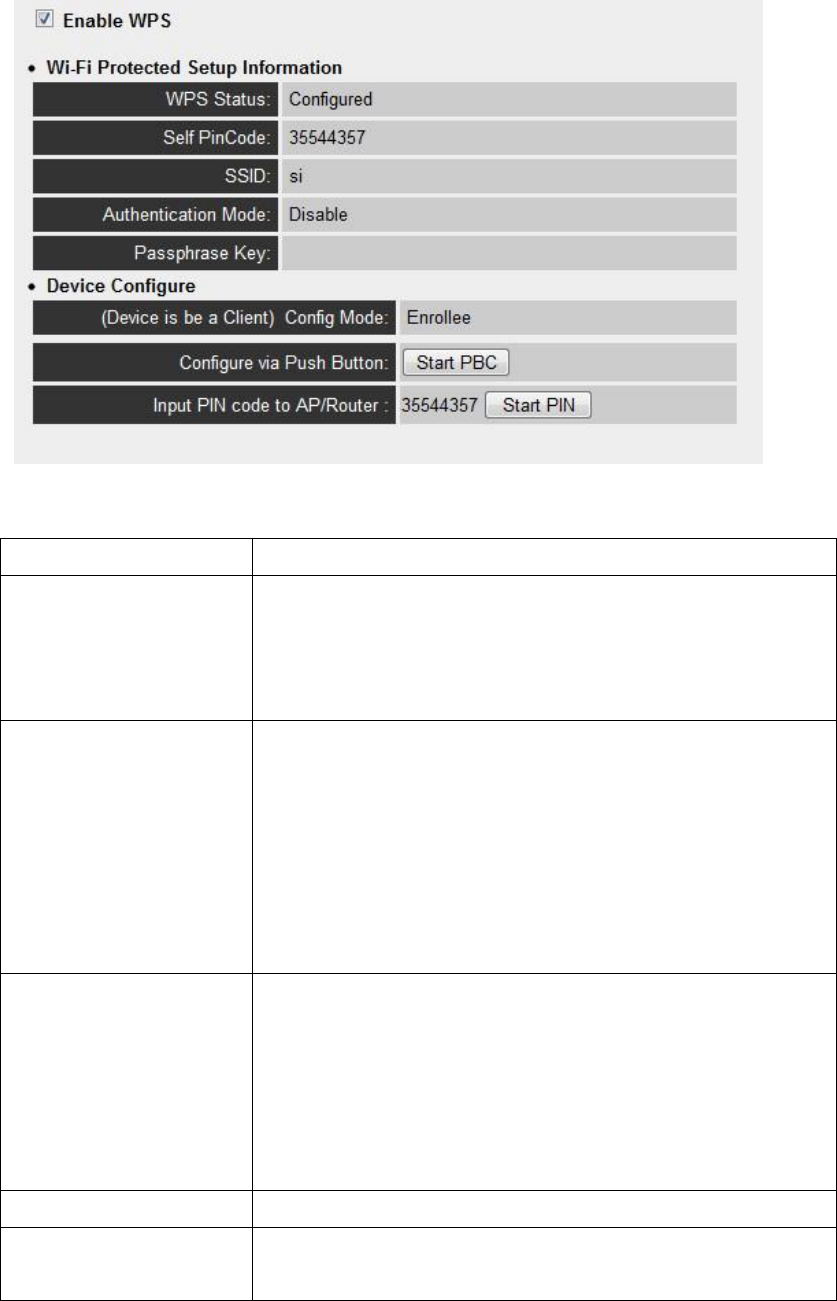
58
The following setup page will appear:
The description of every setup item is listed as follow:
Item
Description
Enable WPS
You can enable or disable WPS function.
Disabling WPS function is included hardware
WPS button function.
Default is „enable WPS‟.
WPS Status
Shows the security setting status of WPS. You
must setup the security setting of this wireless
repeater device manually and the WPS status will
become „Configured‟. Currently only WPA
encryption is supported, if you select other
encryption method, WPS status will remain
„Unconfigured‟.
Self PinCode
Here displays an 8-digit number for WPS
PIN-style configuration. When other
WPS-compatible device wish to connect to this
wireless repeater and supports Self-PIN type
WPS, input this number to the wireless device to
establish connection.
SSID
Shows the SSID of this wireless repeater.
Authentication
Mode
Shows the authentication mode of this wireless
repeater.

59
Passphrase Key
Here shows asterisks (*) to indicate wireless
security is properly set.
Config Mode
Client mode only supports „Enrollee‟ mode, you
can input this client mode‟s PIN code to
AP/Router.
Start PBC
Click „Start PBC‟ to start Push-Button style WPS
setup procedure. This wireless repeater device
will wait for WPS requests from another wireless
device for 2 minutes.
The „WPS‟ LED on the wireless repeater will be
blinking for 2 minutes when this wireless repeater
is waiting for incoming WPS request.
Start PIN
Please click „Start PIN‟ button and input this PIN
code to the wireless broadband router or Access
point you wish to connect.
The „WPS‟ LED on the wireless repeater will be
blinking when this wireless repeater is waiting for
incoming WPS request.
NOTE: For WPS2.0 compliance specification, WEP and WPA-PSK
can’t support WPS connection, some of wireless devices may follow
this latest WPS2.0 specification, so we recommend you not to use
WEP and WPA-PSK to avoid WPS interoperability problem.
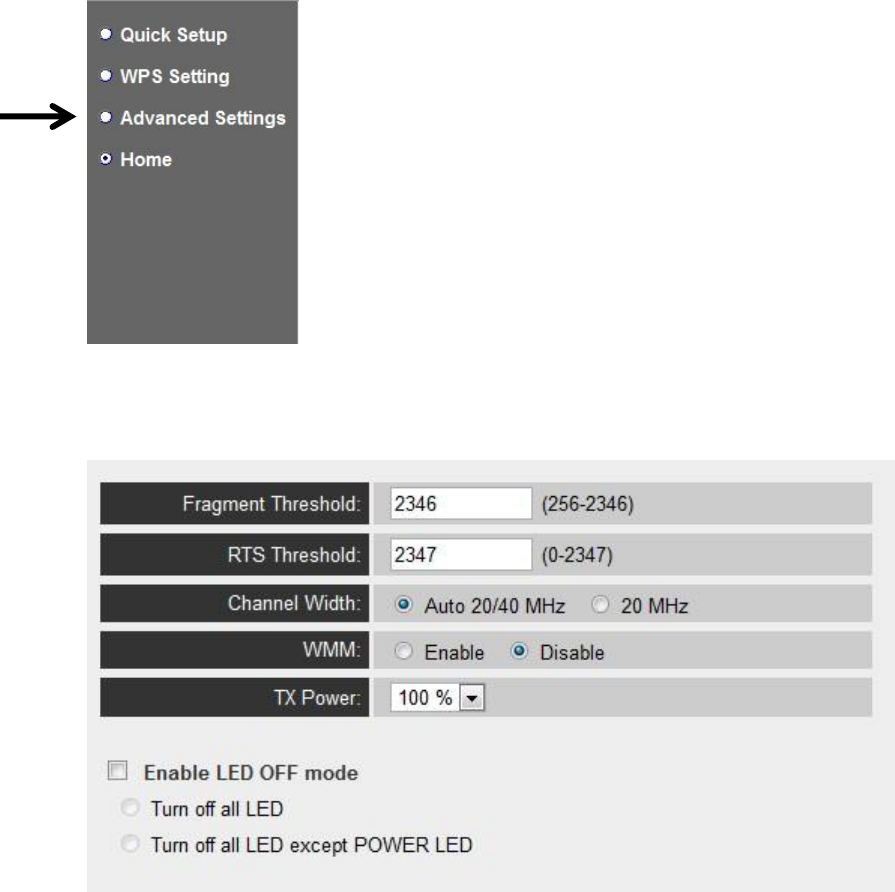
60
3-2-5 Advanced Settings
You can configure advanced wireless settings in this page. Please note
that these settings are not safe to be configured by novice users.
Configure these settings only when you understand what you‟re doing.
To access „Advanced Setting‟ menu, click „Advanced Setting‟ on the left.
The following setup page will appear:
The description of every setup item is listed as follow:

61
Item
Description
Fragment Threshold
Set the Fragment threshold of wireless radio.
Threshold. Do not modify default value if you
don‟t know what it is, default value is 2346.
RTS Threshold
Set the RTS threshold of wireless radio. Do not
modify default value if you don‟t know what it is,
default value is 2347.
Channel Width
Select the wireless channel width, 20MHz or
40MHz. 40MHz provides better network speed
for 802.11n wireless clients.
WMM
Enable or disable Wireless Multi-Media. When
enabled, this device will give priority to
multimedia related network applications so they
will have better performance.
TX Power
Select wireless transmitting power level, from
10% to 100%. When wireless clients are not too
far from this wireless repeater, you don‟t have to
select a higher power level, since this may cause
some people to try to break into your wireless
network when you have a bad password or no
password.
Enable LED off
mode
You can enable or disable LED lights
Check „Enable LED OFF‟ mode to setup LED
behavior:
Turn off all LED: disabled all LED lights.
Turn off all LED except POWER LED: all LED
lights will be disabled, except „POWER‟ LED.
When you finish settings in this page, click „Apply‟ button. You‟ll see the
following message:

62
If you still need to configure this device, click „CONTINUE‟ button; if
you want to save changes and make it work now, click „APPLY‟ button.
You‟ll be prompted to wait for 30 seconds before you can reconnect to
Web UI of this device.
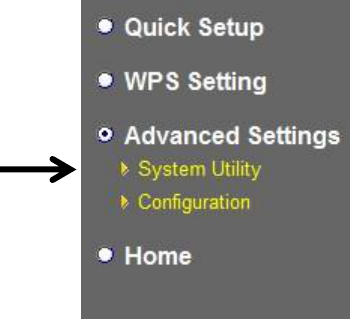
63
3-2-6 System Utility
You can change the settings of several system-level parameters in this
page, including administrator‟s password, and IP address.
To access „System Utility‟ menu, click „System Utility‟ on the left.
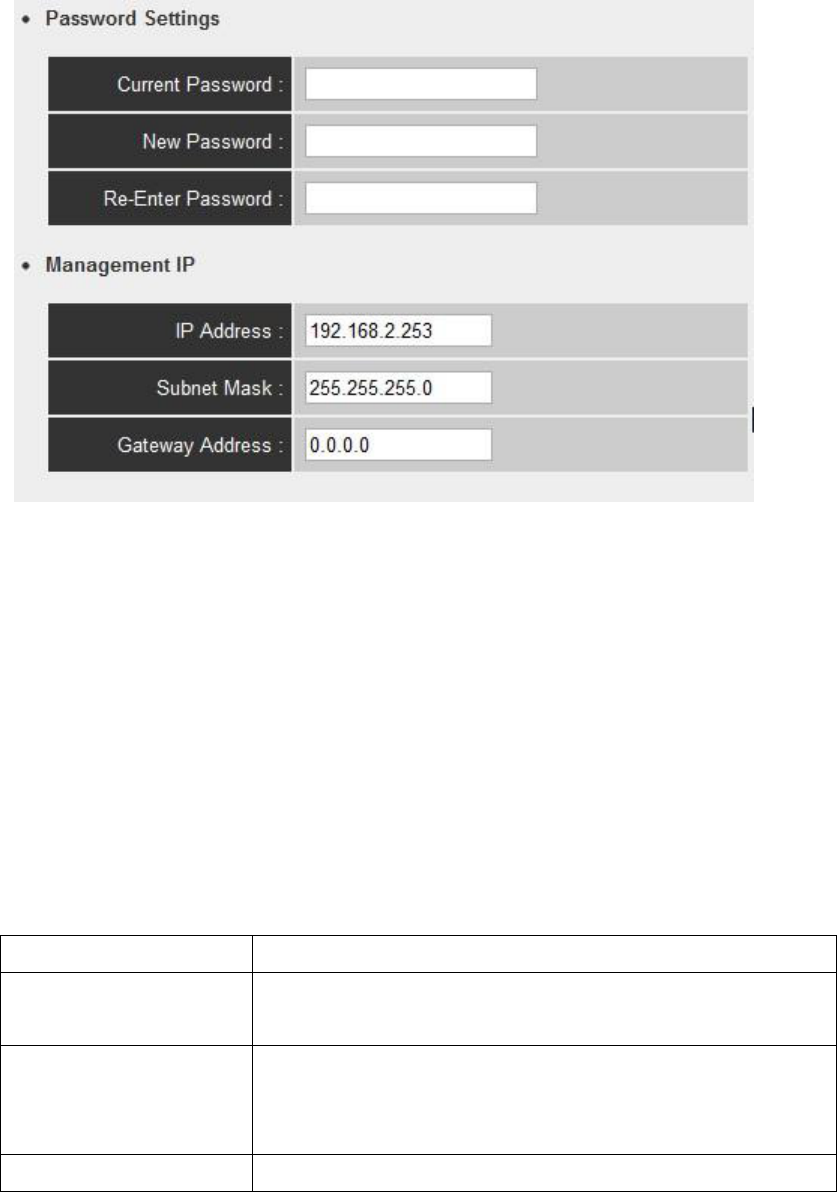
64
The following setup page will appear:
The description of every setup item is listed as follow:
Password Settings
Default password of this repeater is 1234, and it‟s displayed on the login
prompt when accessed from web browser. There‟s a security risk if you
don‟t change the default password, since everyone can see it. This is very
important when you have wireless function enabled.
Here are descriptions of every setup items:
Item
Description
Current Password
To change password, you have to input current
password first.
New Password
Input new password here. You can use the
combination of alphabets, number, and symbols
for up to 20 characters.
Re-Enter Password
Input new password again for conformation.
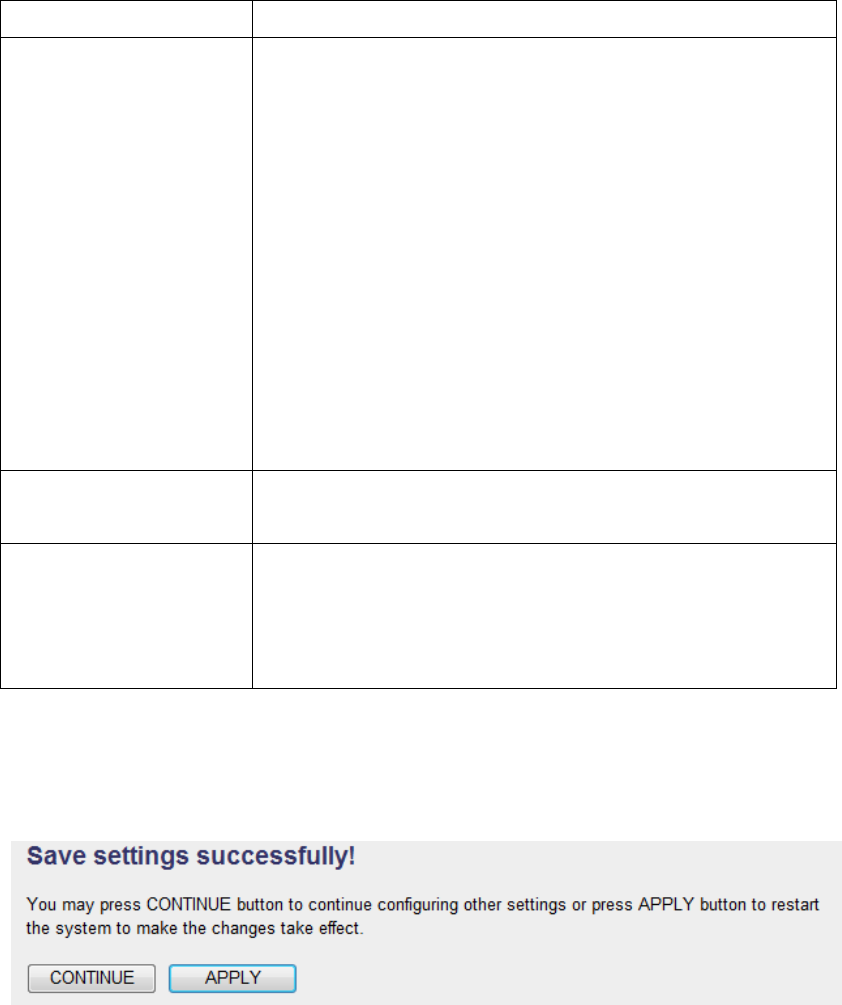
65
Management IP
To set up the IP address of this wireless repeater, please see the following
description.
Item
Description
IP Address
Input the IP address of LAN / Wi-Fi port of this
wireless repeater.
NOTE: Please remember this IP address. If you
forget this IP address and you didn‟t use DHCP
server function to assign IP address to clients,
you‟ll not be able to connect to this wireless
repeater device and you‟ll need to clear all
settings and password to reset the IP address
back to default value „192.168.2.253‟ on Client
mode.( Press WPS button and hold for 10 seconds
to restore all settings to factory defaults)
Subnet Mask
Input the subnet mask of the IP address you‟re
using.
Gateway Address
Input the gateway‟s IP address of your network.
Generally you can use „0.0.0.0‟ (default value)
since this wireless repeater will access Internet
via WAN port.
When you finish settings in this page, click „Apply‟ button. You‟ll see the
following message:
If you still need to configure this device, click „CONTINUE‟ button; if
you want to save changes and make it work now, click „APPLY‟ button.
You‟ll be prompted to wait for 30 seconds before you can reconnect to
Web UI of this device.
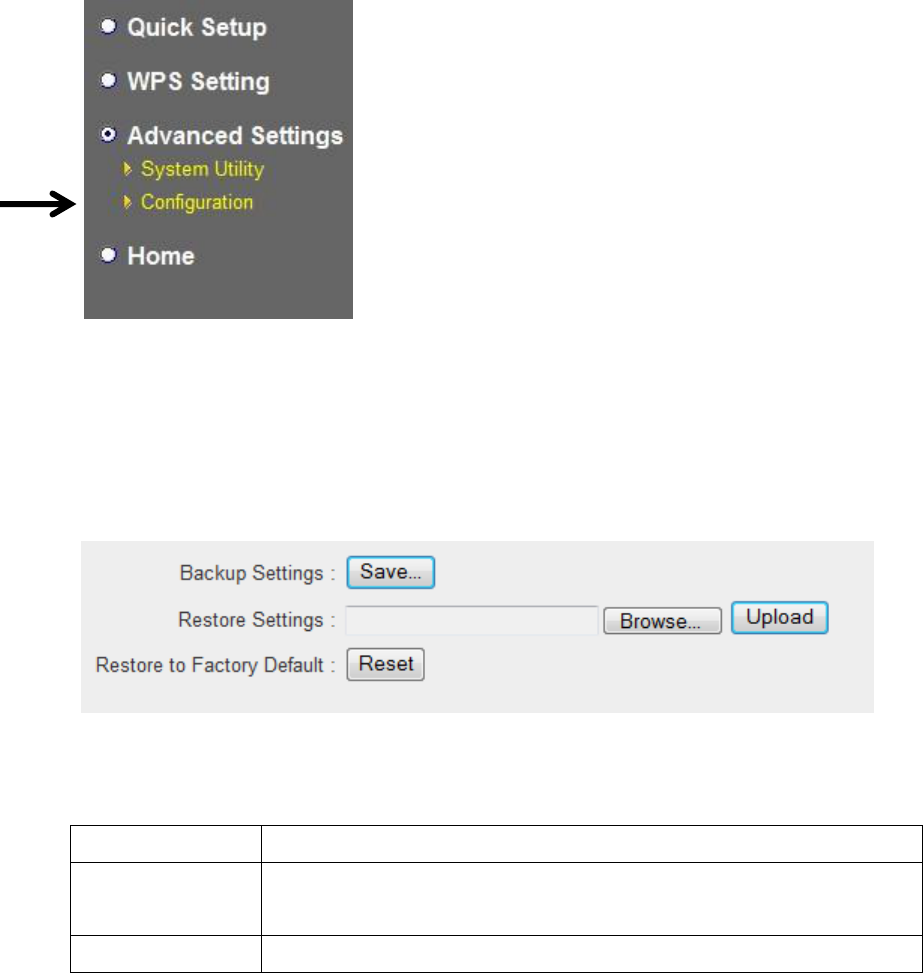
66
3-2-7 Configuration
You can backup and restore the configuration of this device, so you can
recall all settings back in very short time, without doing configuration
again.
This function is especially useful when you need to use this mini Wi-Fi
repeater in different places, like home and hotel.
To access „Configuration‟ menu, click „Configuration‟ on the left.
Configuration Tool
The following setup page will appear:
The description of every setup item is listed as follow:
Item
Description
Backup
Settings
Click „Save‟ button to save the current settings to a file
on your computer.
Restore
If you want to upload a saved configuration file to
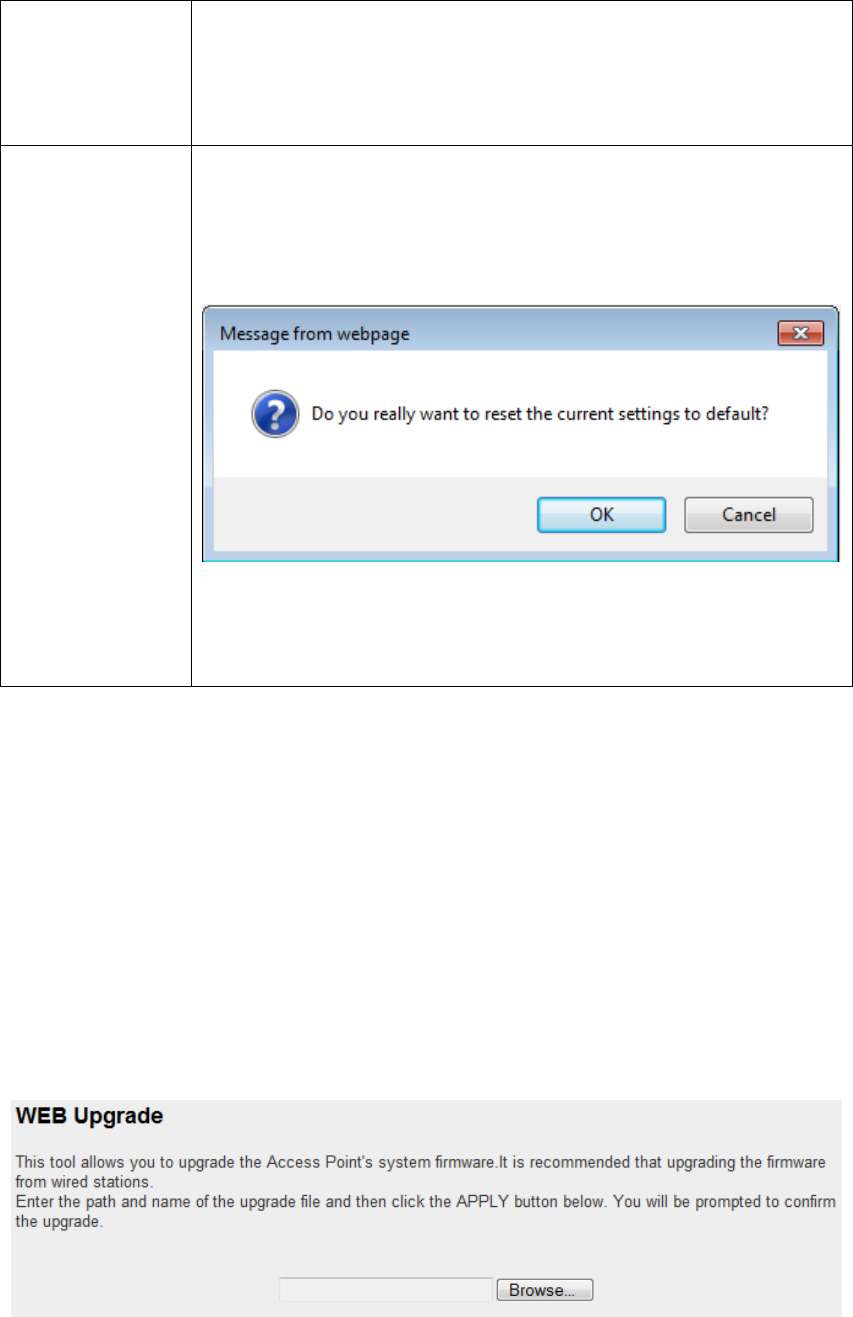
67
Settings
wireless repeater, please click „Browse‟ button to select
a saved configuration file on your computer. Then
click ‟Upload‟ button to restore the current settings to
new one.
Reset to
Factory
Default
To reset all settings of this wireless repeater to factory
defaults, including password. You‟ll be prompted to
confirm the settings reset:
Click „OK‟ if you really want to restore all settings, or
click „Cancel‟ to abort.
WEB Upgrade
The software running in this wireless repeater (i.e. „Firmwre‟) can be
upgraded to improve the functionality of this wireless repeater.
You can access our website to look for latest firmware file. Then
download the latest firmware file and save on your computer and upload
to this wireless repeater.
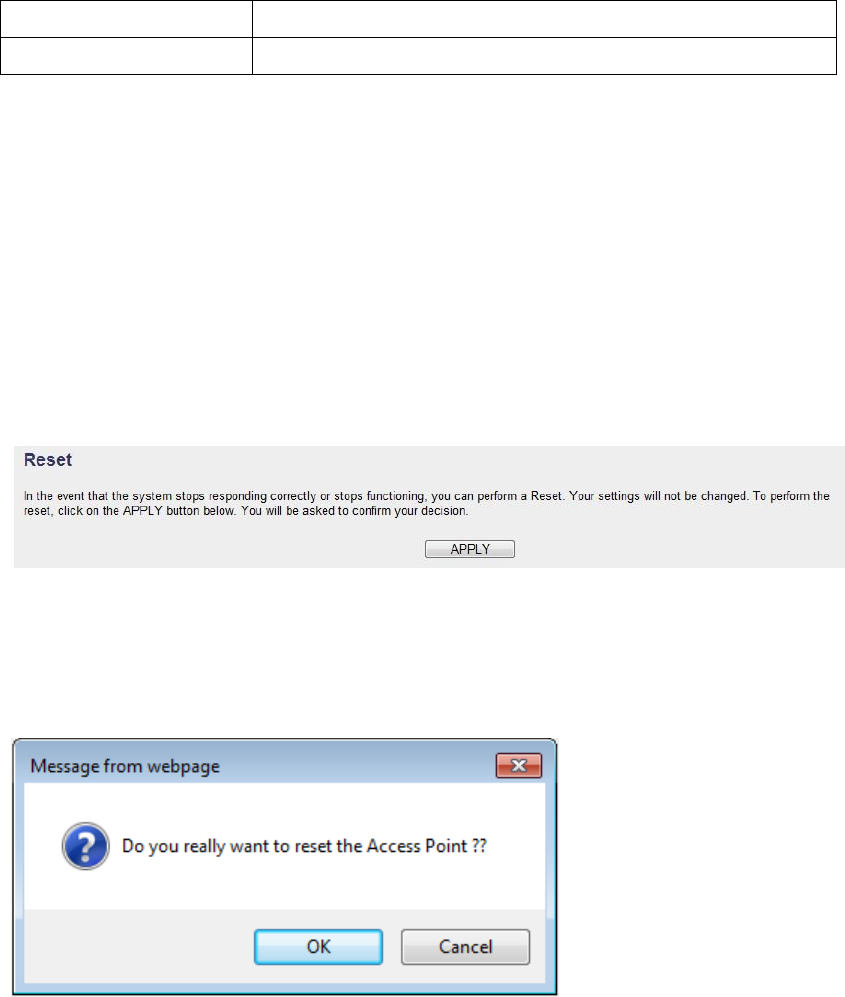
68
The description of every setup item is listed as follow:
Item
Description
Browse
Select a firmware file saved on your computer.
When you are ready, click „Apply‟ button to start firmware upgrade
procedure.
Reset
When you think this wireless repeater is not working properly, resetting it
may help.
To reset this wireless repeater, click „Apply‟ button. You‟ll be prompted
to confirm reset:
Click „OK‟ button to reset wireless repeater, or click „Cancel‟ to abort.
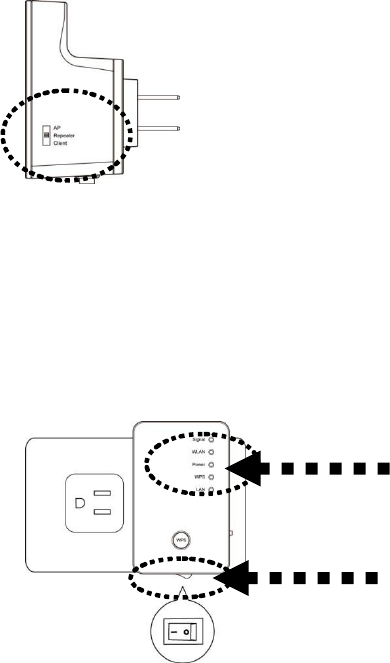
69
CHAPTER IX: AP mode
You can build a wireless networking environment for home or small
office, please switch this device to wireless access point mode and
connect it to your wired router. Then your wireless client users can access
internet by wirelessly connecting to this AP without wired cable burden.
This chapter will show you how to quickly install this device by using
quick setup and show you the each detailed setting on web UI page of AP
mode.
4-1 AP mode Quick Installation Guide
Switch mode selector to „AP‟.
Insert this device into power outlet on the wall, and switch wireless
repeater‟s power switch to „ON‟ (1). You should see „Power‟ LED light
up in few seconds (2). If not, please check if the power outlet you‟re
using is working.
You can build wireless connection via „Hardware WPS button‟ or
(2)
(1)
70
„Software web browser‟.
If your wireless client also supports „WPS button‟, we recommend you to
use WPS button to establish connection, it is the fast and secure way
without computer.
Using WPS button - please go to section 4-1-1
Using Web browser - please go to section 4-1-2
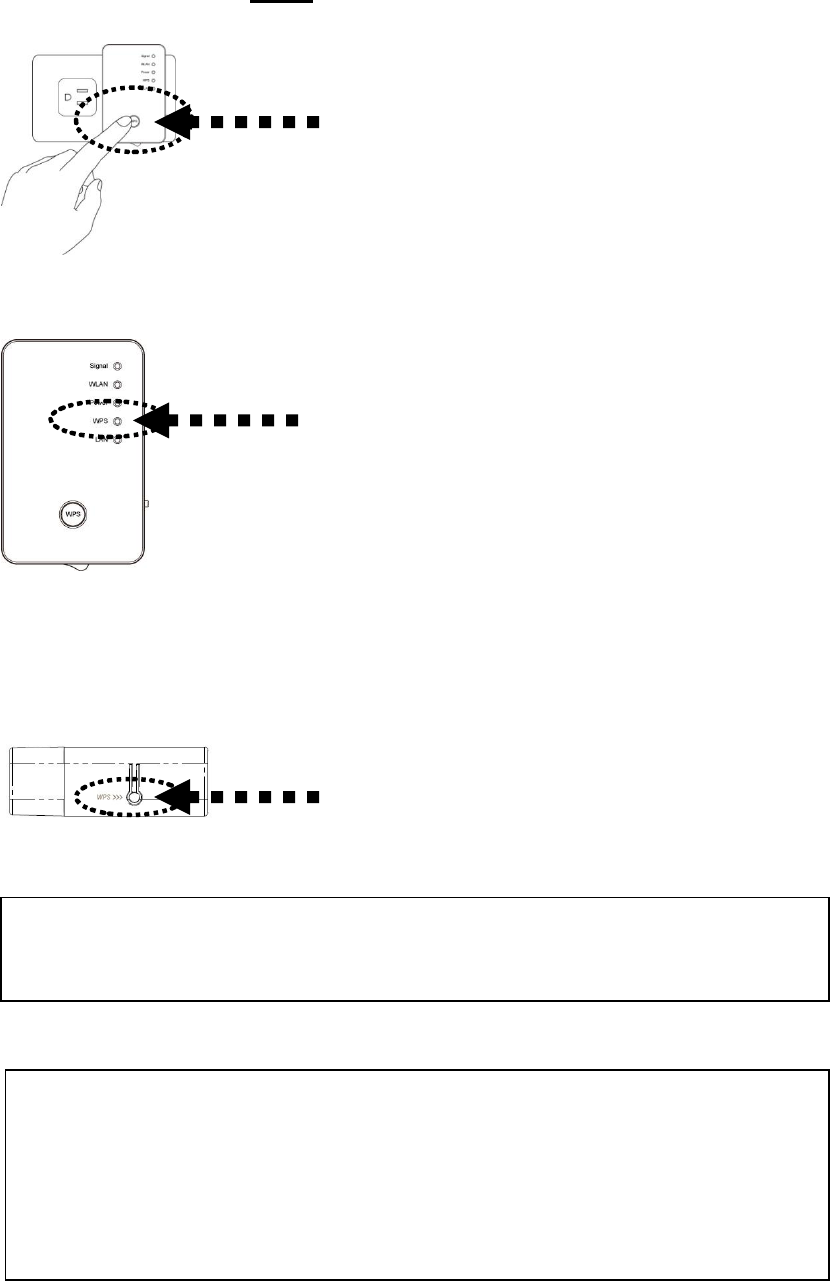
71
4-1-1 Hardware WPS button setup
(1) Press WPS button twice on repeater, „WPS‟ LED will start flashing.
(2) Press WPS button on the wireless client you wish to connect within 2
minutes.
WPS LED
WPS button
NOTE: this WPS button position on client card is for example,
different device may have different WPS button position.
TIP: If your wireless client card does not have hardware WPS button,
you can also use its web configuration menu’s WPS function to
establish connection. Or you can login this repeater web UI to have
quick setup (detailed setup refers to ‘4-1-2 Web browser quick setup’
manual)
WPS button
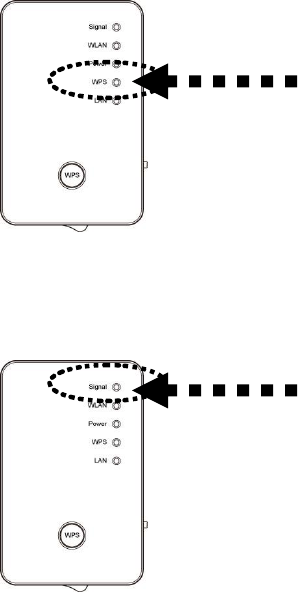
72
(3) If WPS connection is successfully established, „WPS‟ LED will light
for 5 minutes; if „WPS‟ LED flashes fast, there‟s something error, please
wait for 2 minutes until „WPS‟ LED off, and try from step(1) again.
When quick installation is successfully done, „Signal” LED will turn on.
(4) „Signal‟ LED in AP mode is Steady light to provide wireless clients
the best signal.
(5) Connect this access point to ADSL modem, wired router, or
switch/hub in your network through the LAN port of the access point by
Ethernet cable.
The quick installation setup is completely done, you can refer to „4-2 AP
mode Advanced Settings‟ to login in web UI for other advanced settings.
WPS LED
Signal LED
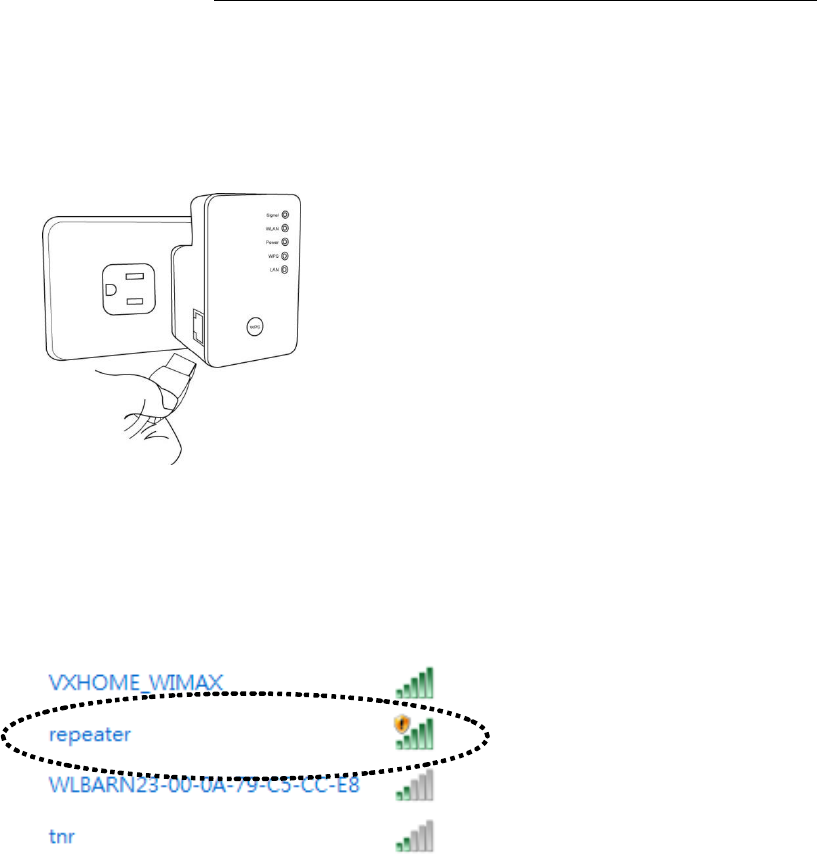
73
4-1-2 Web browser quick setup
Before you can connect to the repeater and start configuration procedures,
your computer must be able to get an IP address automatically (use
dynamic IP address). If it‟s set to use static IP address, or you‟re unsure,
please refer to „Chapter X: Appendix, 5-1 Configuring TCP/IP on PC‟ to
set your computer to use dynamic IP address.
(1)Use Ethernet cable to connect your computer‟s Ethernet port and
wireless repeater‟s Ethernet port.
Or use your computer‟s wireless configuration utility to search for access
point named „repeater‟ and get connected. (The default SSID of this
repeater device is „repeater‟)
(2)Open web browser and input „http://repeater‟ in address bar. (or you
can input the default IP address „192.168.2.1‟)
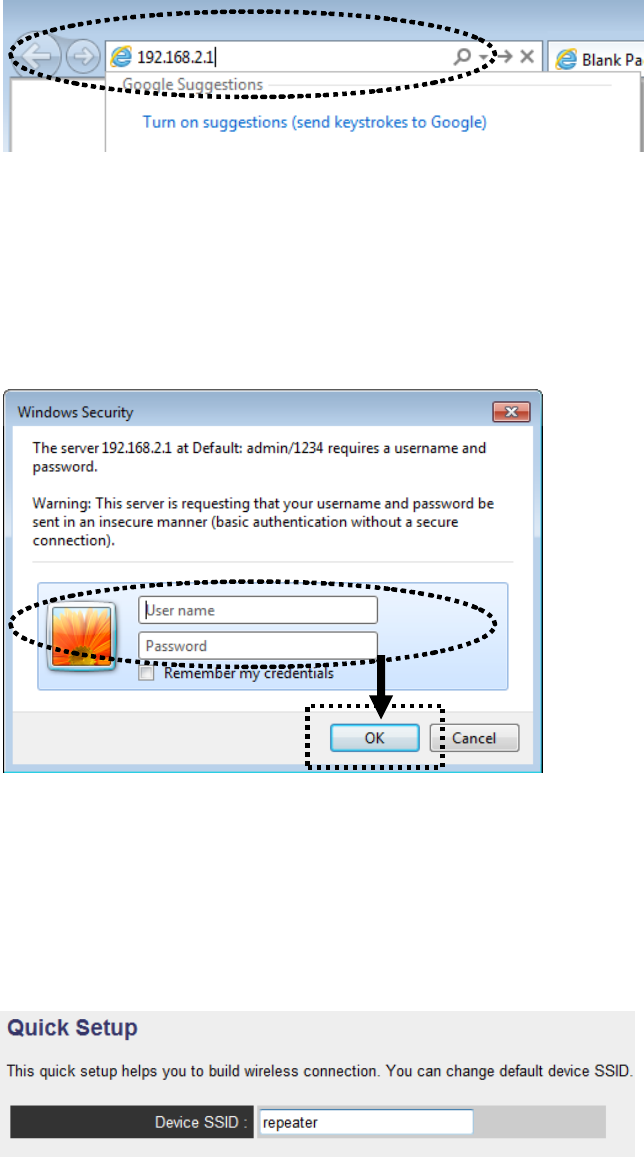
74
(3)Wireless repeater will prompt you to input username and password.
Default username is „admin‟ and password is „1234‟. Click „OK‟ button
to continue.
(4) Please input a SSID (a name used to identify this access point) in
„Device SSID‟ field, then click „Next‟ button.
Default SSID is repeater, you can change this default SSID if you want.
(5) Select security type of wireless link:
Encryption: Disable (no security), WEP, WPA pre-shared key, or WPA
RADIUS
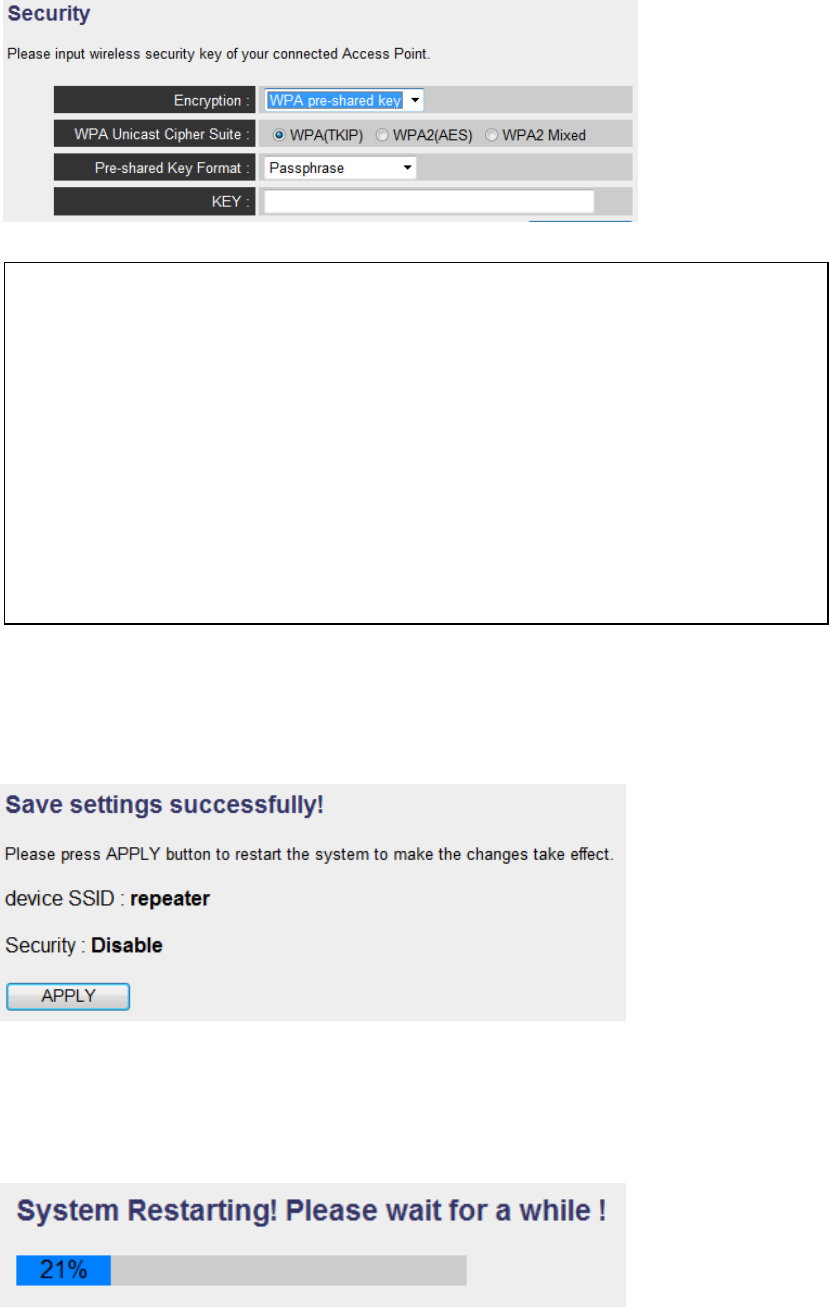
75
(6) Please recheck settings you made, and click „Apply‟ to continue.
(7)Please wait for few seconds for device to reboot.
Note: WEP encryption: Select key length (64 or 128bit), key format
(Hex or ASCII characters), Default Tx Key (usually use ‘Key 1’), and
input key characters (refer to ‘Key Format’ you selected for number of
characters)
WPA pre-shared key: Select one WPA Unicast Cipher Suite (usually
use default setting ‘WPA(TKIP)’), Pre-shared Key Format: Passphrase
(alphanumeric characters) or Hex (64 Hex Characters), and input key
characters in ‘KEY’ field.
WPA RADIUS: Only use this option if you have RADIUS
authentication server on your LAN. You have to input RADIUS
server‟s parameters (Server IP, port number, and password).

76
(8) After reboot complete, web browser will login access point‟s home
page of Web UI. You can close browser to finish this quick setup and
connect this access point to ADSL modem, wired router, or switch/hub in
your network through the LAN port of the access point by Ethernet cable.
NOTE: After quick installation is successfully finished and you want
to login Web UI of repeater, please refer to ‘5-2 AP mode Advanced
Settings’ for more functions or learn how to login web UI again.
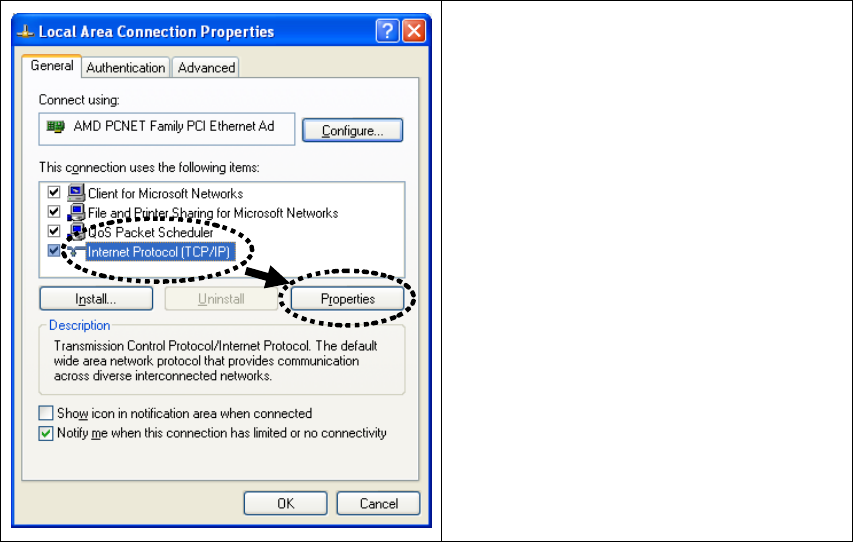
77
4-2 AP mode Advanced Settings
4-2-1 Setup IP address
Default IP address of this device in AP mode is 192.168.2.1, please make
sure your PC‟s IP is within the range of 192.168.2.2~192.168.2.252.
Before you can login web UI, you can set your computer‟s IP address to
any IP within this subnet. If you don‟t know how to do this, please refer
to following instructions.
Windows XP IP address setup:
Click ‘Start’ button (it should be
located at lower-left corner of your
computer), then click control panel.
Double-click Network and Internet
Connections icon, click Network
Connections, and then double-click
Local Area Connection, Local
Area Connection Status window
will appear, and then click
‘Properties’
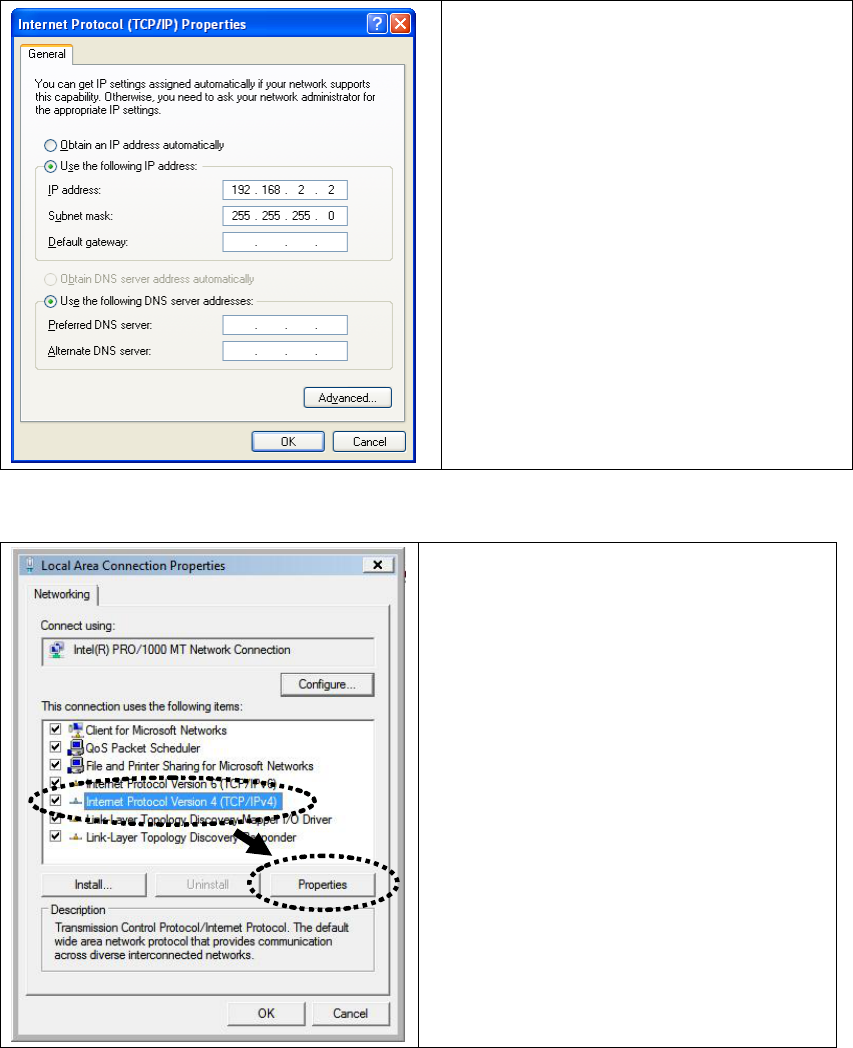
78
Select ‘Use the following IP
address’, then input the following
settings in respective field:
IP address: 192.168.2.x (where x is
an integer greater or less than 200, if
there’s more than one computer
need to use this wireless
presentation gateway on the same
network, every computer should use
an unique number)
Subnet Mask: 255.255.255.0
Click ‘OK’ when finish.
Windows Vista/7 IP address setup:
Click ‘Start’ button (it should be
located at lower-left corner of your
computer), then click control panel.
Click View Network Status and
Tasks, then click Manage Network
Connections..Right-click Local
Area Netwrok, then select
‘Properties’. Local Area
Connection Properties window will
appear, select ‘Internet Protocol
Version 4 (TCP / IPv4), and then click
‘Properties’
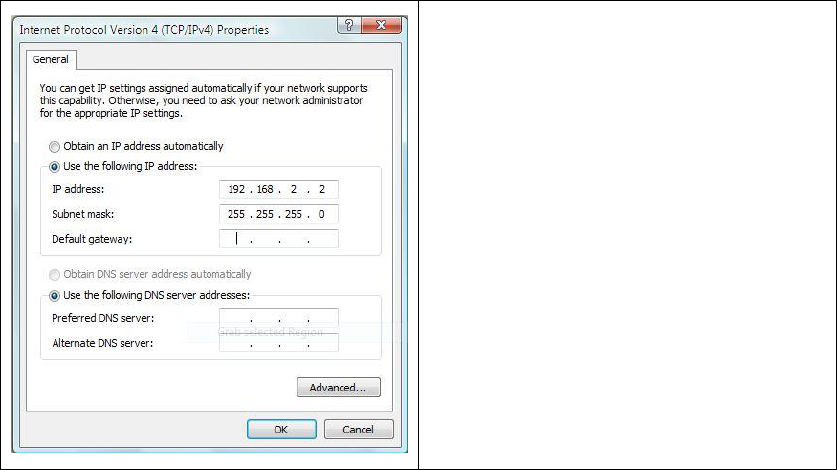
79
Select ‘Use the following IP address’,
then input the following settings in
respective field:
IP address: 192.168.2.x (where x is
an integer greater or less than 200, if
there’s more than one computer need
to use this wireless presentation
gateway on the same network, every
computer should use an unique
number)
Subnet Mask: 255.255.255.0
Click ‘OK’ when finish.
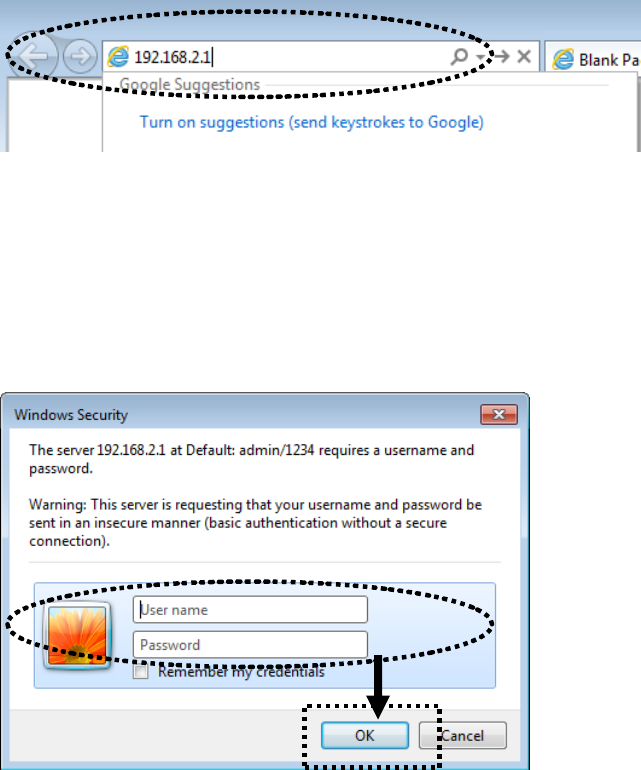
80
4-2-2 Connect to web configuration menu
Please open web browser (IE, firefox, chrome etc.) and input 192.168.2.1
in address bar then press ENTER key:
Wireless repeater will prompt you to input username and password.
Default username is „admin‟ and password is „1234‟. Click „OK‟ button
to continue.
You should be able to see the configuration manual of this Access Point
mode in very short time:
Detailed operation instructions will be given to following manual.
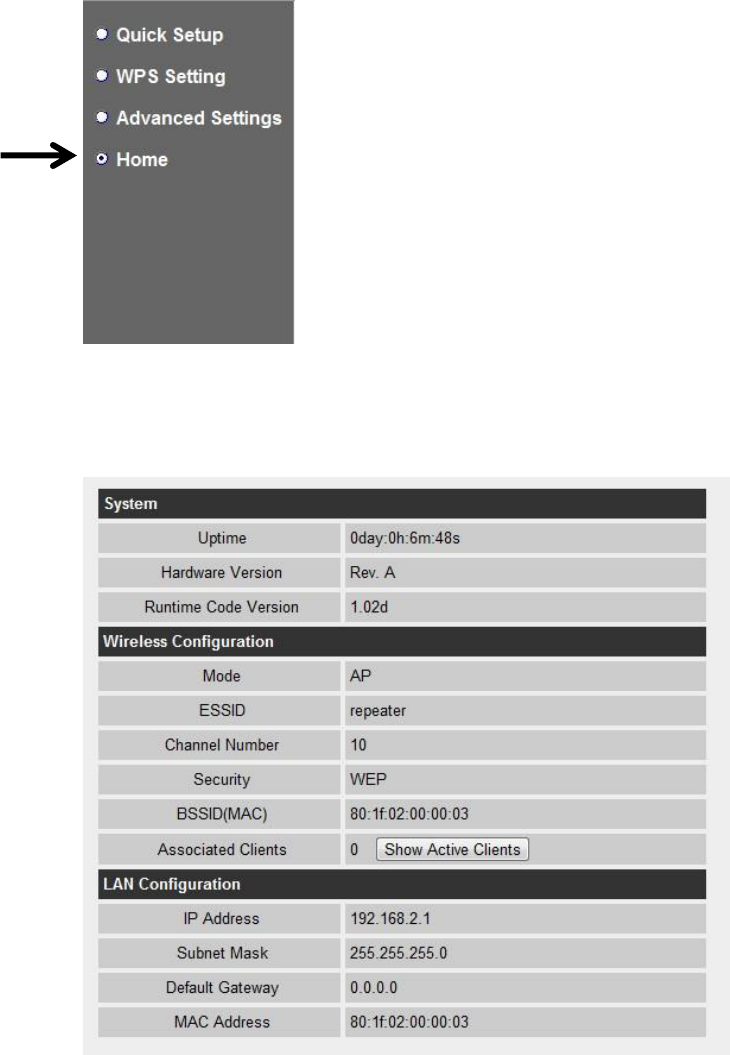
81
4-2-3 Home
The status and information of this access point will be displayed here.
To access „Home‟ menu, click „Home‟ on the left.
You should see the screen looks like this (the contents will vary
depending on your actual setting):
82
You can click „Show Active Clients‟ button to show all connected
wireless clients.
Please note: By clicking ‘Show Active Clients’ button, a new browser
window will appear. If your browser prevents pop-up window from
appearing, please disable this function or you will not be able to use
‘Show Client’ function.
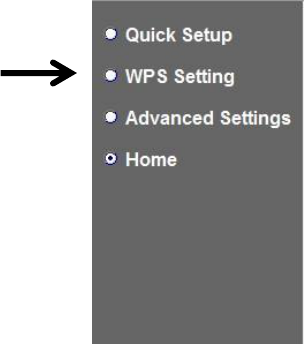
83
4-2-4 WPS Setting
You can configure WPS (Wi-Fi Protected Setup) here. By using WPS,
you can establish secure connection between this wireless repeater with
other wireless devices which also support WPS in a fast and secure
manner.
To access „WPS Setting‟ menu, click „WPS Settings‟ on the left.
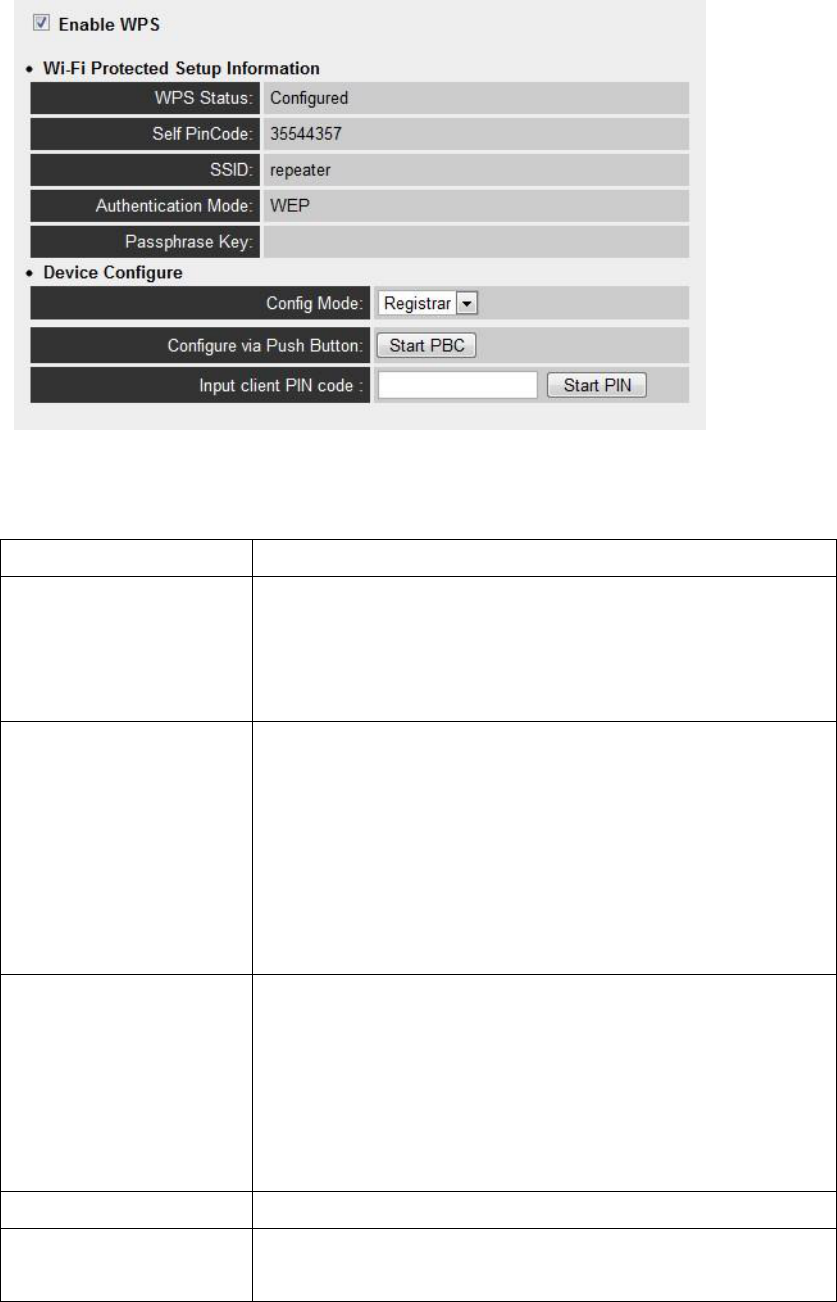
84
The following setup page will appear:
The description of every setup item is listed as follow:
Item
Description
Enable WPS
You can enable or disable WPS function.
Disabling WPS function is included hardware
WPS button function.
Default is „enable WPS‟.
WPS Status
Shows the security setting status of WPS. You
must setup the security setting of this wireless
repeater manually and the WPS status will
become „Configured‟. Currently only WPA
encryption is supported, if you select other
encryption method, WPS status will remain
„Unconfigured‟.
Self PinCode
Here displays an 8-digit number for WPS
PIN-style configuration. When other
WPS-compatible device wish to connect to this
wireless repeater and supports Self-PIN type
WPS, input this number to the wireless device to
establish connection.
SSID
Shows the SSID of this wireless access point.
Authentication
Mode
Shows the authentication mode of this wireless
access point.

85
Passphrase Key
Here shows asterisks (*) to indicate wireless
security is properly set.
Config Mode
There are „Registrar‟ and „Enrollee‟ modes for the
WPS connection. When „Registrar‟ is enabled,
the wireless clients will follow the access point‟s
wireless settings for WPS connection. When
„Enrollee‟ mode is enabled, the access point will
follow the wireless settings of wireless router for
WPS connection.
Start PBC
Click „Start PBC‟ to start Push-Button style WPS
setup procedure. This wireless repeater will wait
for WPS requests from another wireless device
for 2 minutes.
The „WPS‟ LED on this device will be blinking
for 2 minutes when this access point is waiting
for incoming WPS request.
Start PIN
Please input the PIN code of the wireless client
you wish to connect, and click „Start PIN‟ button.
The „WPS‟ LED on the wireless repeater will be
blinking when this wireless repeater is waiting for
incoming WPS request.
NOTE: For WPS2.0 compliance specification, WEP and WPA-PSK
can’t support WPS connection, some of wireless devices may follow
this latest WPS2.0 specification, so we recommend you not to use
WEP and WPA-PSK to avoid WPS interoperability problem.
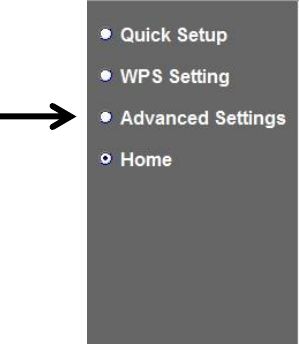
86
4-2-5 Advanced Settings
You can configure advanced wireless settings in this page. Please note
that these settings are not safe to be configured by novice users.
Configure these settings only when you understand what you‟re doing.
To access „Advanced Setting‟ menu, click „Advanced Setting‟ on the left.
The following setup page will appear:
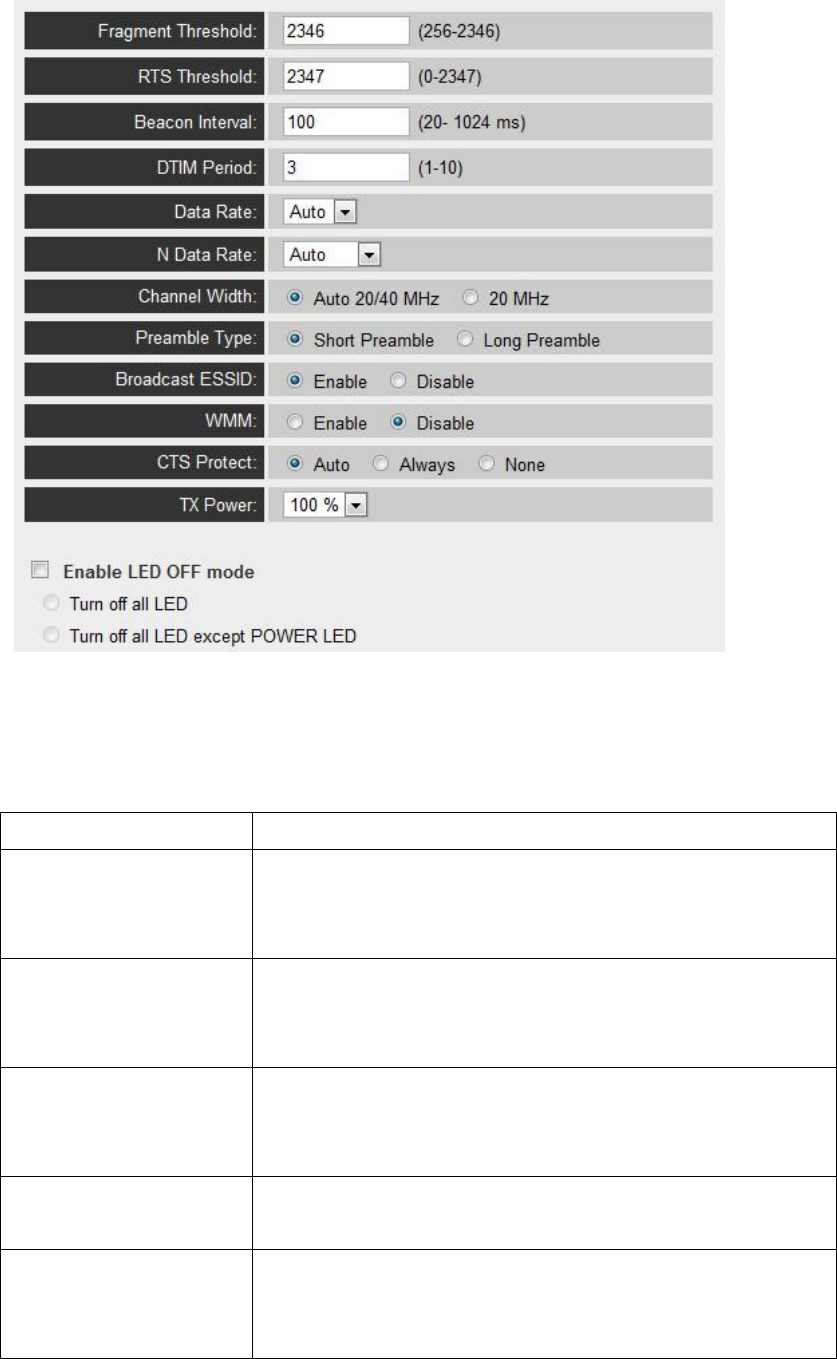
87
The description of every setup item is listed as follow:
Item
Description
Fragment Threshold
Set the Fragment threshold of wireless radio.
Threshold. Do not modify default value if you
don‟t know what it is, default value is 2346.
RTS Threshold
Set the RTS threshold of wireless radio. Do not
modify default value if you don‟t know what it is,
default value is 2347.
Beacon Interval
Set the beacon interval of wireless radio. Do not
modify default value if you don‟t know what it is,
default value is 100.
DTIM Period
Configures DTIM (Delivery Traffic Indication
Message) send period. Default value is 3.
Data Rate
Select wireless data transfer speed. When you
select a value here, this repeater will refuse to
establish connection with wireless clients by

88
other speed.
It‟s recommended to select „Auto‟ and this
wireless repeater will adjust the speed
automatically.
N Data Rate
Select wireless data transfer speed by MCS0 to
MCS7. MCS stands for Modulation and Coding
Scheme, which represents different speed when
bandwidth is 20MHz or 40MHz.
It‟s recommended to select „Auto‟ and this
wireless repeater will adjust the speed
automatically.
Channel Width
Select the wireless channel width, 20MHz or
40MHz. 40MHz provides better network speed
for 802.11n wireless clients.
However, if there‟re 802.11b / g clients
connecting to this wireless repeater, it will switch
to 20MHz mode automatically.
Preamble Type
Set the type of preamble of wireless radio, Do not
modify default value if you don‟t know what it is,
default setting is „Short Preamble‟.
Broadcast ESSID
When set to „enabled‟, every wireless devices can
scan and found this wireless repeater; when set to
„disabled‟, only wireless clients who know exact
SSID can get connected with this wireless
repeater. Set to disabled will help to improve
security.
WMM
Enable or disable Wireless Multi-Media. When
enabled, wireless repeater will give priority to
multimedia related network applications so they
will have better performance.
CTS Protect
This function provides CTS (Clear to Send)
protection when transferring data. It‟s
recommended to select „Auto‟ for this option.
TX Power
Select wireless transmitting power level, from
10% to 100%. When wireless clients are not too
far from this wireless repeater, you don‟t have to
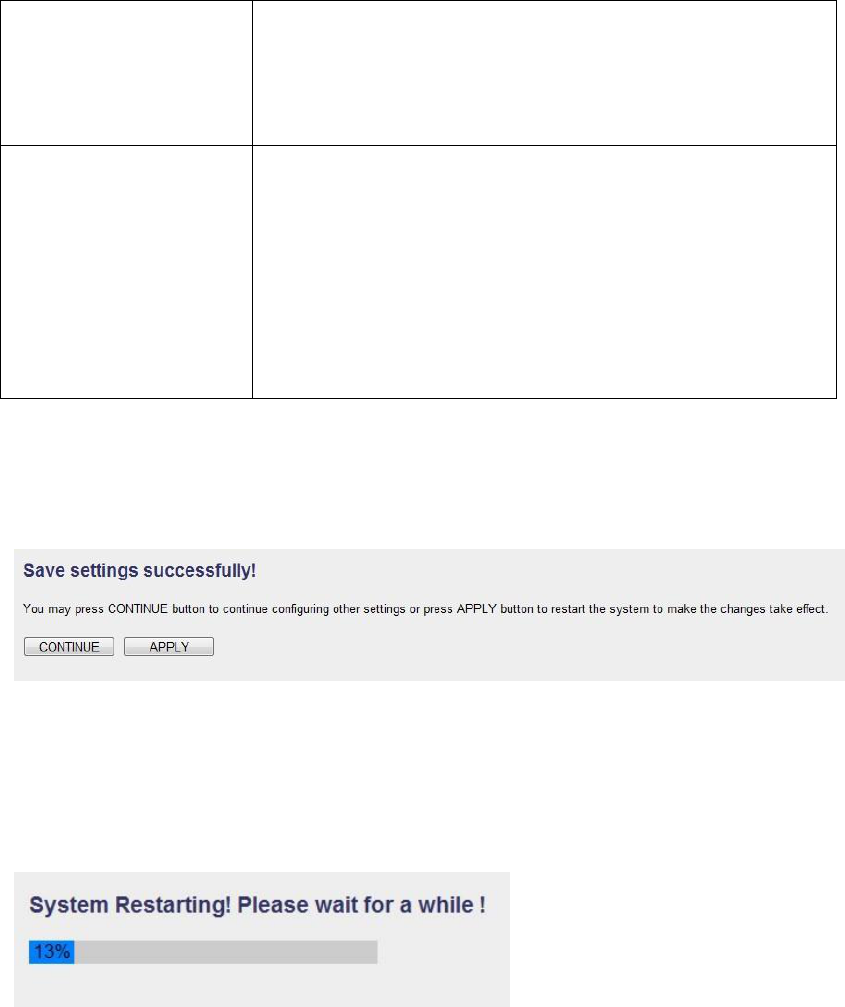
89
select a higher power level, since this may cause
some people to try to break into your wireless
network when you have a bad password or no
password.
Enable LED off
mode
You can enable or disable LED lights
Check „Enable LED OFF‟ mode to setup LED
behavior:
Turn off all LED: disabled all LED lights
Turn off all LED except POWER LED: all LED
lights will be disabled, except „POWER‟ LED
When you finish settings in this page, click „Apply‟ button. You‟ll see the
following message:
If you still need to configure this wireless repeater, click „CONTINUE‟
button; if you want to save changes and make it work now, click „APPLY‟
button.
You‟ll be prompted to wait for 30 seconds before you can reconnect to
Web UI of this access point.
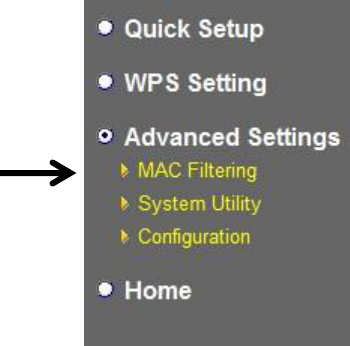
90
4-2-6 MAC Address Filtering
Besides using wireless security to only allow permitted wireless users to
use this wireless access point, you can also use MAC address filter to
allow wireless users with certain MAC address to use this access point.
This will enhance security because you can make a „white list‟ to allow
users on the list to use this wireless repeater only in advance. For those
clients who don‟t list on this white list can‟t get connected, even he or she
know the password.
To access „MAC Filtering‟ menu, click „MAC Filtering‟ on the left.
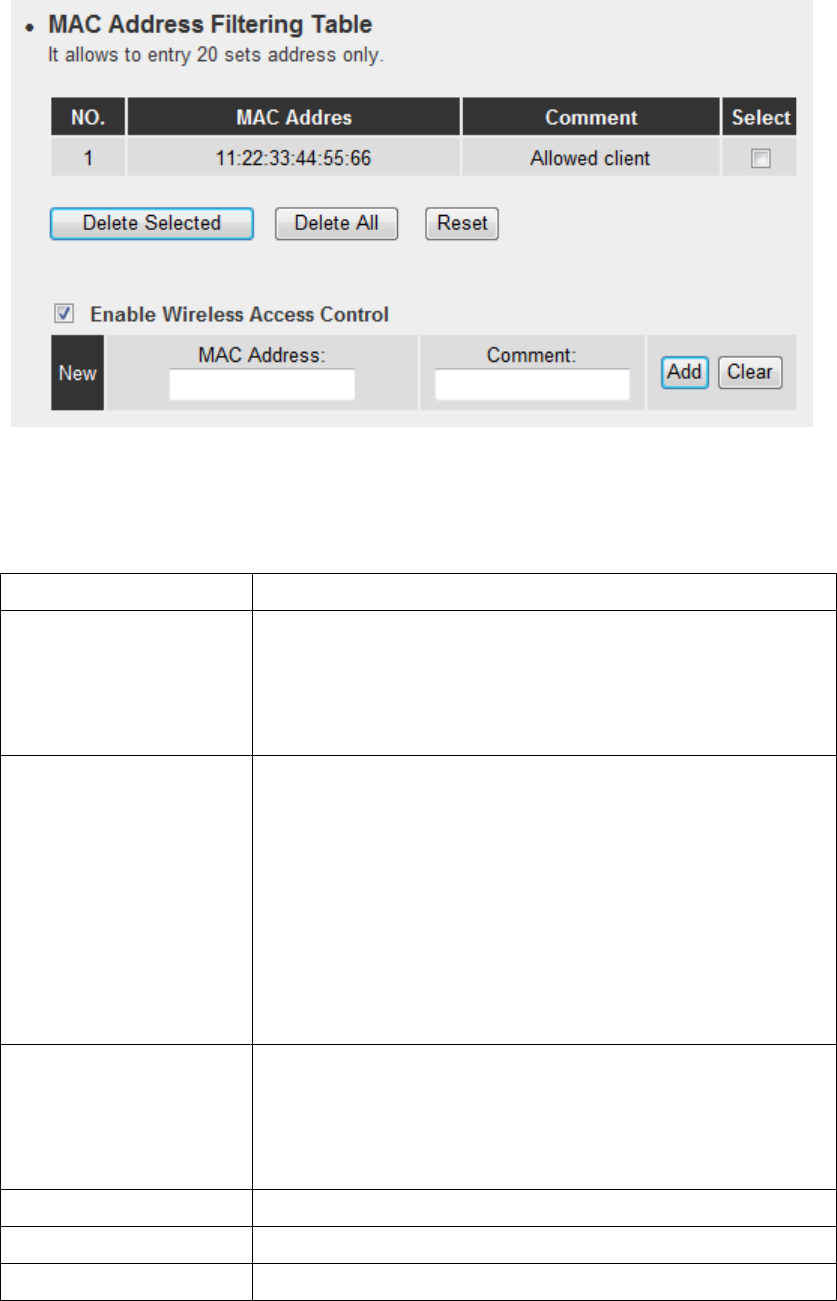
91
The following setup page will appear:
The description of every setup item is listed as follow:
Item
Description
Enable Wireless
Access Control
Check this box to enable MAC filtering. If you
didn‟t check this box, anyone who knows the
wireless password can get connected to this
access point.
MAC Address
Input the MAC address of the clients you wish to
deny or accept to access this AP into the MAC
address list. Please input 12 HEX characters here,
and you don‟t have to add : (colon) or - (dash)
characters every 2 characters.
If you don‟t know how to get the MAC address of
a network client, see tips below.
Comment
Input any descriptive text about this rule, so you
can remember the purpose of this rule. You can
input up to 20 alphanumerical characters in this
field.
Add
Add this MAC address to the list.
Clear
Clear „MAC Address‟ and „Comment‟ field.
Delete Selected
Delete MAC address(es) you selected which
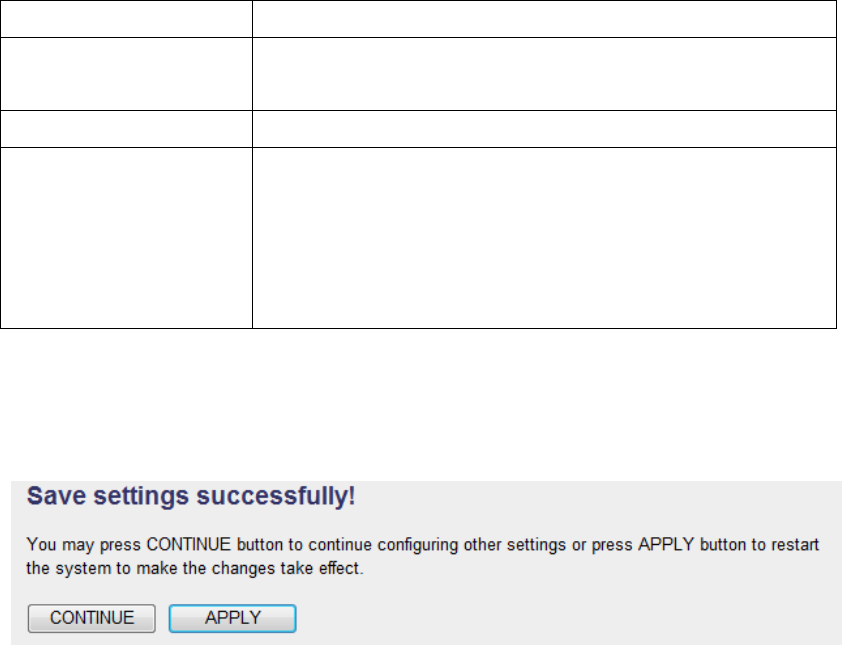
92
„Select‟ box is checked.
Delete All
Delete all MAC addresses in the list. You‟ll be
prompted to confirm deletion first.
Reset
Uncheck all checked boxes.
Select
All existing MAC addresses will be listed here.
To delete a MAC address from the list, check the
box of the MAC address you wish to delete first.
You can select more than one MAC addresses
here.
When you finish settings in this page, click „Apply‟ button. You‟ll see the
following message:
If you still need to configure this wireless repeater, click „CONTINUE‟
button; if you want to save changes and make it work now, click „APPLY‟
button. You‟ll be prompted to wait for 30 seconds before you can
reconnect to this access point.
TIPS: If you don‟t know the MAC address of your computer or wireless
device, you can follow the following procedure:
For wireless devices and computers which are connected to this wireless
repeater already, you can click „Show Active Clients‟ button in „Home‟
setting page.
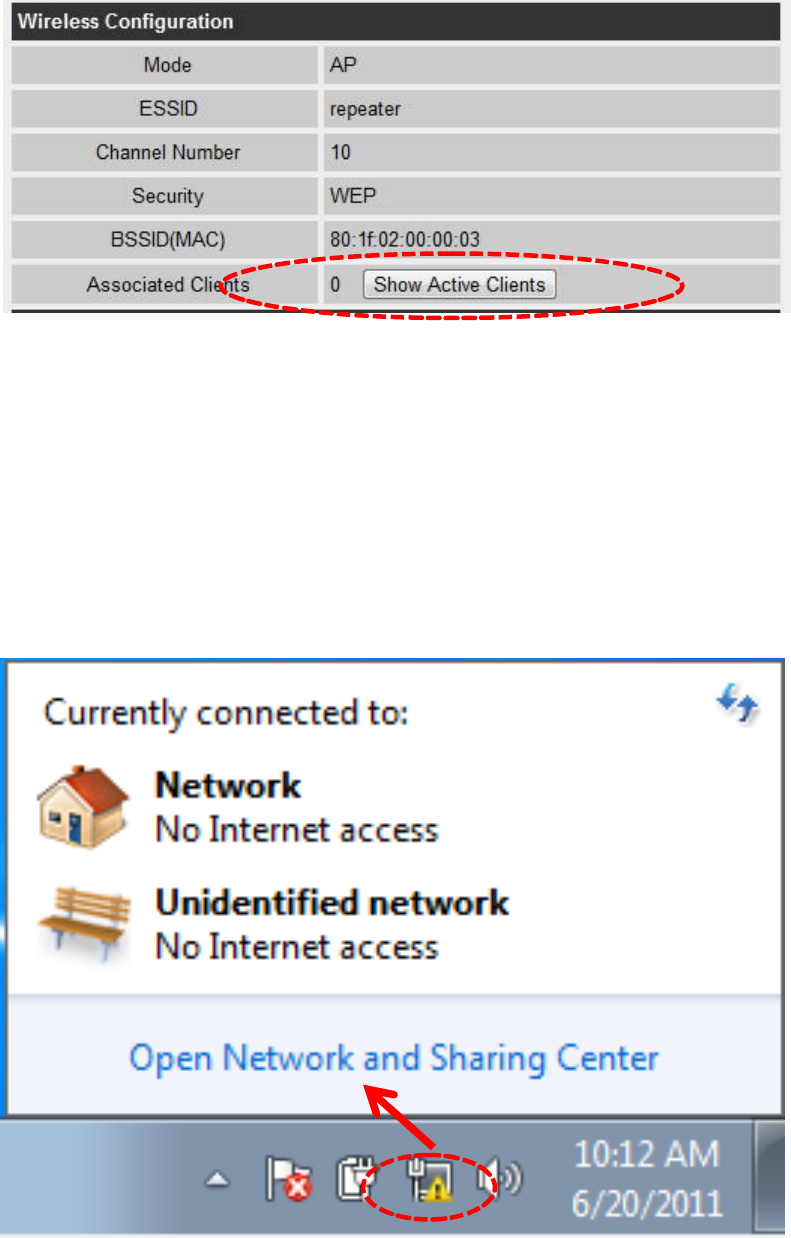
93
Their MAC address will be displayed at „MAC Address‟ field.
If you still can‟t identify the MAC address of computer, you can follow
the following procedure:
Click the network icon located at the lower-right corner, then click „Open
Network and Sharing Center‟.
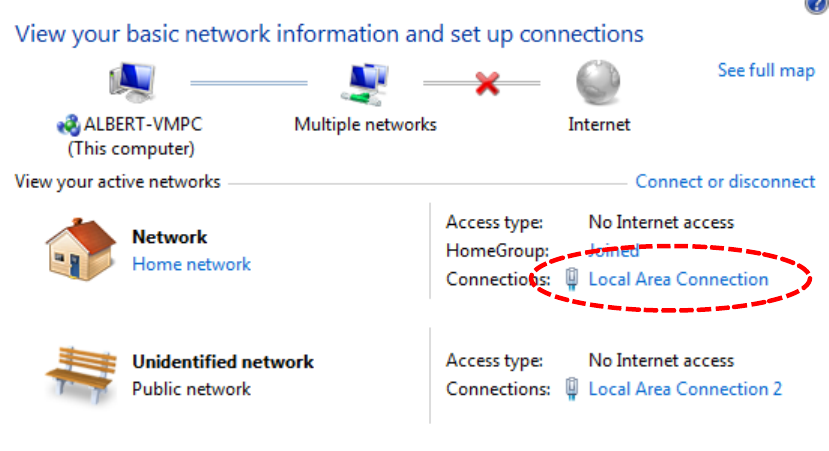
94
Click the connection that you‟ll be used to connect the wireless AP (in
this example, „Local Area Connection‟):
Click „Details…‟ button.
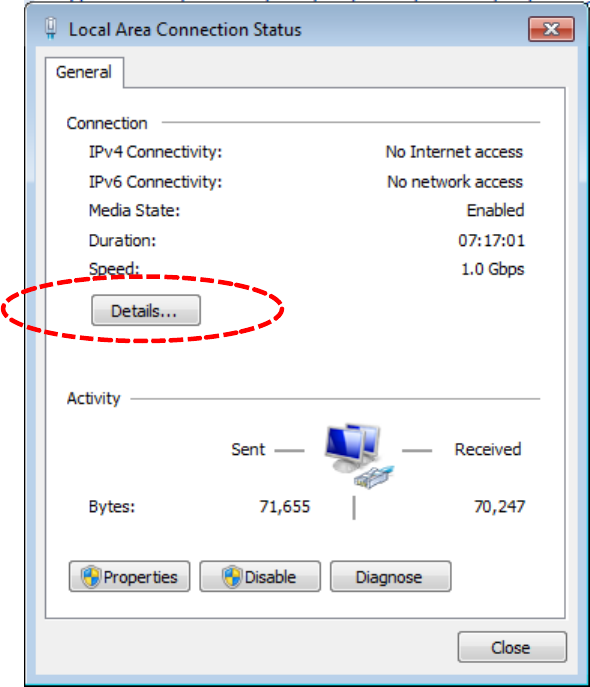
95
The MAC address of selected network connection will be displayed here
as „Physical Address‟.
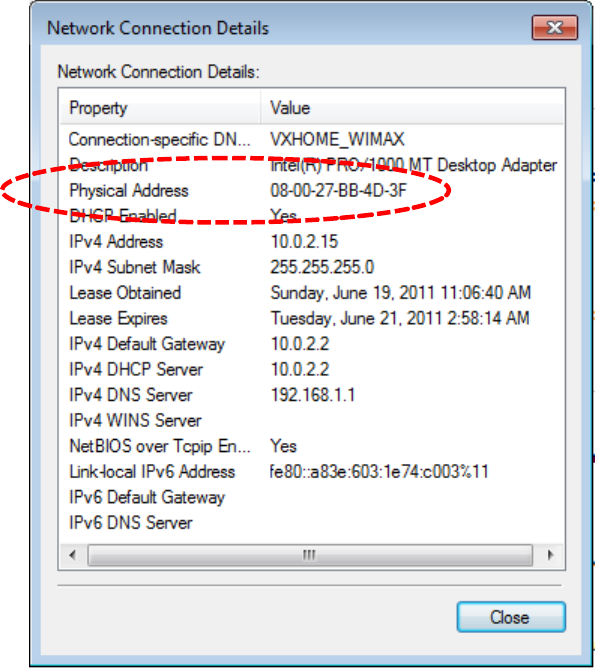
96
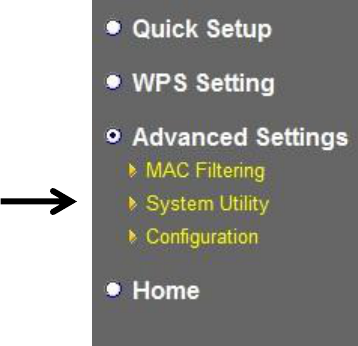
97
4-2-7 System Utility
You can change the settings of several system-level parameters in this
page, including administrator‟s password, and IP address.
To access „System Utility‟ menu, click „System Utility‟ on the left.
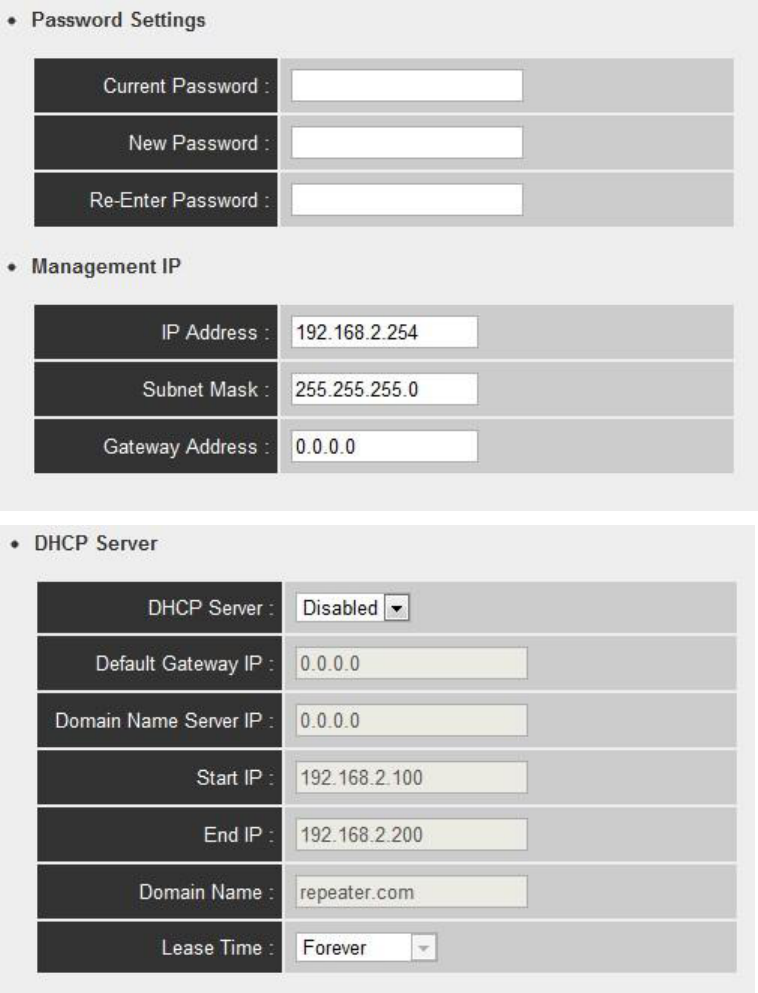
98
The following setup page will appear:
The description of every setup item is listed as follow:
Password Settings
Default password of this repeater is 1234, and it‟s displayed on the login
prompt when accessed from web browser. There‟s a security risk if you
don‟t change the default password, since everyone can see it. This is very

99
important when you have wireless function enabled.
Here are descriptions of every setup items:
Item
Description
Current Password
To change password, you have to input current
password first.
New Password
Input new password here. You can use the
combination of alphabets, number, and symbols
for up to 20 characters.
Re-Enter Password
Input new password again for conformation.

100
Management IP
To set up the IP address of this wireless repeater, please see the following
description.
Item
Description
IP Address
Input the IP address of LAN / Wi-Fi port of this
access point.
NOTE: Please remember this IP address. If you
forget this IP address and you didn‟t use DHCP
server function to assign IP address to clients,
you‟ll not be able to connect to this device and
you‟ll need to clear all settings and password to
reset the IP address back to default value
„192.168.2.1‟.( Press WPS button and hold for 10
seconds to restore all settings to factory defaults)
Subnet Mask
Input the subnet mask of the IP address you‟re
using.
Gateway Address
Input the gateway‟s IP address of your network.
Generally you can use „0.0.0.0‟ (default value)
since this wireless repeater will access Internet
via WAN port.
DHCP Server
This wireless access point is capable to act as a DHCP server for your
network, and it‟s disabled by default. If you want to activate this function,
please select „Enabled‟ in „DHCP Server‟ option, and see next detailed
instructions; if you don‟t want to use DHCP server function of this
wireless access point, or there‟s another DHCP server on the network this
access point connects to, please select „Disable‟.
NOTE: If you select ‘Disable’ in ‘DHCP Server’ option, all
DHCP-related fields will be grayed out, and you will not be able to
input any DHCP parameter.
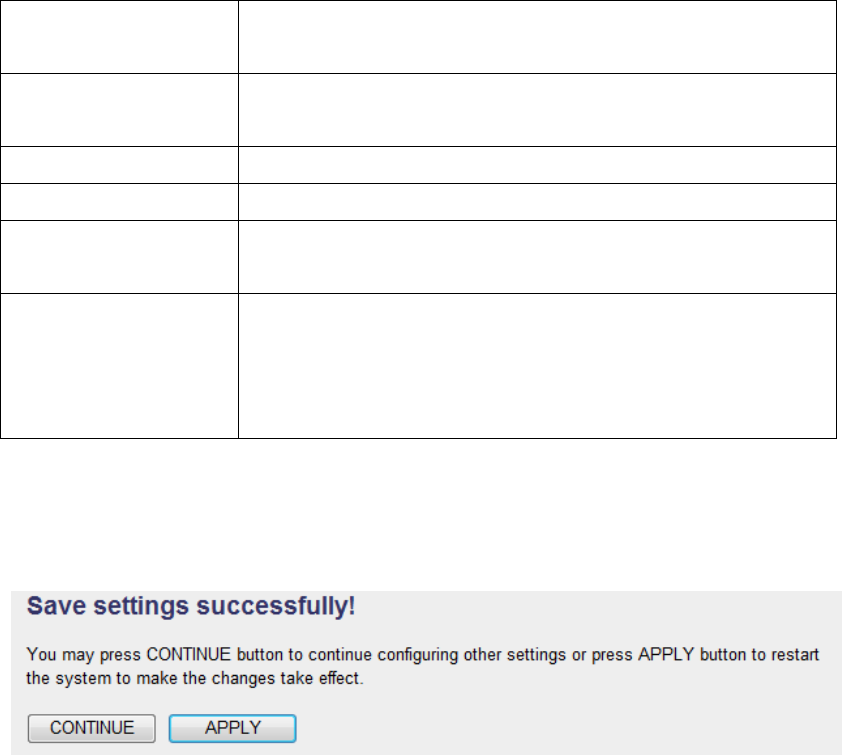
101
Here are descriptions of every setup item:
Default Gateway
IP
Please input the IP address of default gateway of
your network here.
Domain Name
Server IP
Please input the IP address of domain name server
(DNS) here.
Start IP
Please input the start IP address of the IP range.
End IP
Please input the end IP address of the IP range.
Domain Name
If you wish, you can also optionally input the
domain name for your network. This is optional.
Lease Time
Please choose a lease time (the duration that every
computer can keep a specific IP address) of every
IP address assigned by this access point from
dropdown menu.
When you finish settings in this page, click „Apply‟ button. You‟ll see the
following message:
If you still need to configure this wireless repeater, click „CONTINUE‟
button; if you want to save changes and make it work now, click „APPLY‟
button. You‟ll be prompted to wait for 30 seconds before you can
reconnect to this device.
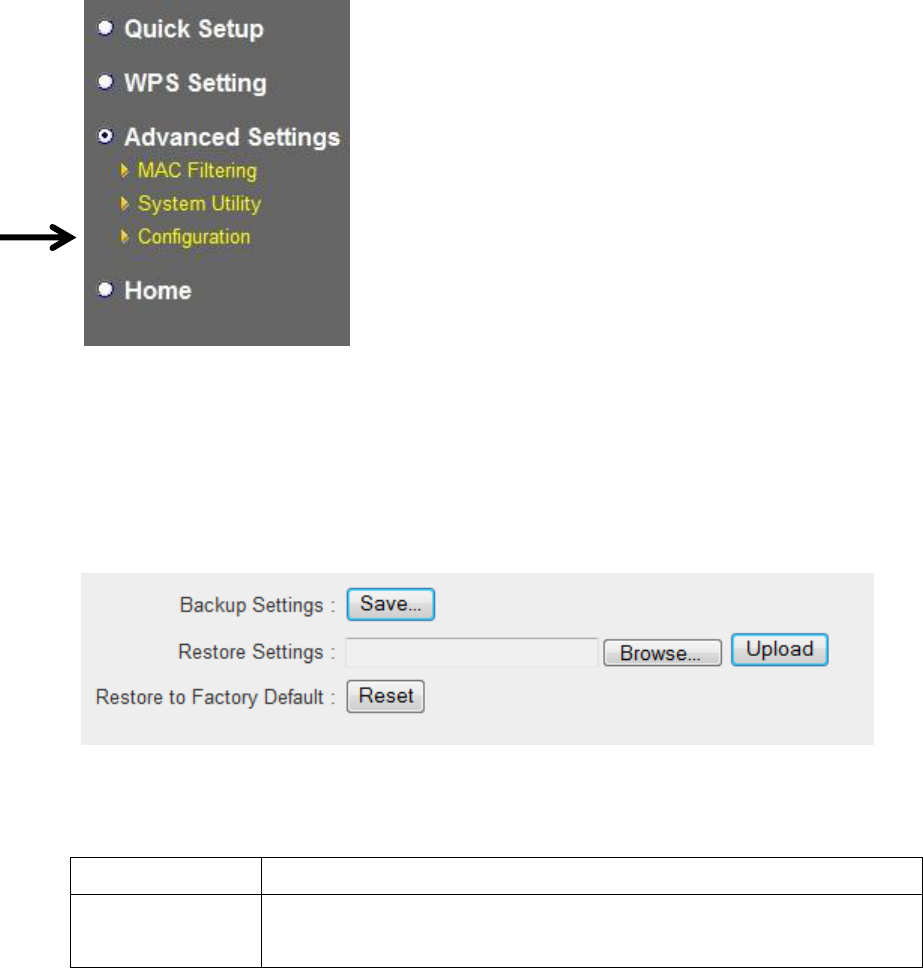
102
4-2-8 Configuration
You can backup and restore the configuration of this access point, so you
can recall all settings back in very short time, without doing configuration
again.
This function is especially useful when you need to use this mini Wi-Fi
AP in different places, like home and hotel.
To access „Configuration‟ menu, click „Configuration‟ on the left.
Configuration Tool
The following setup page will appear:
The description of every setup item is listed as follow:
Item
Description
Backup
Settings
Click „Save‟ button to save the current settings to a file
on your computer.
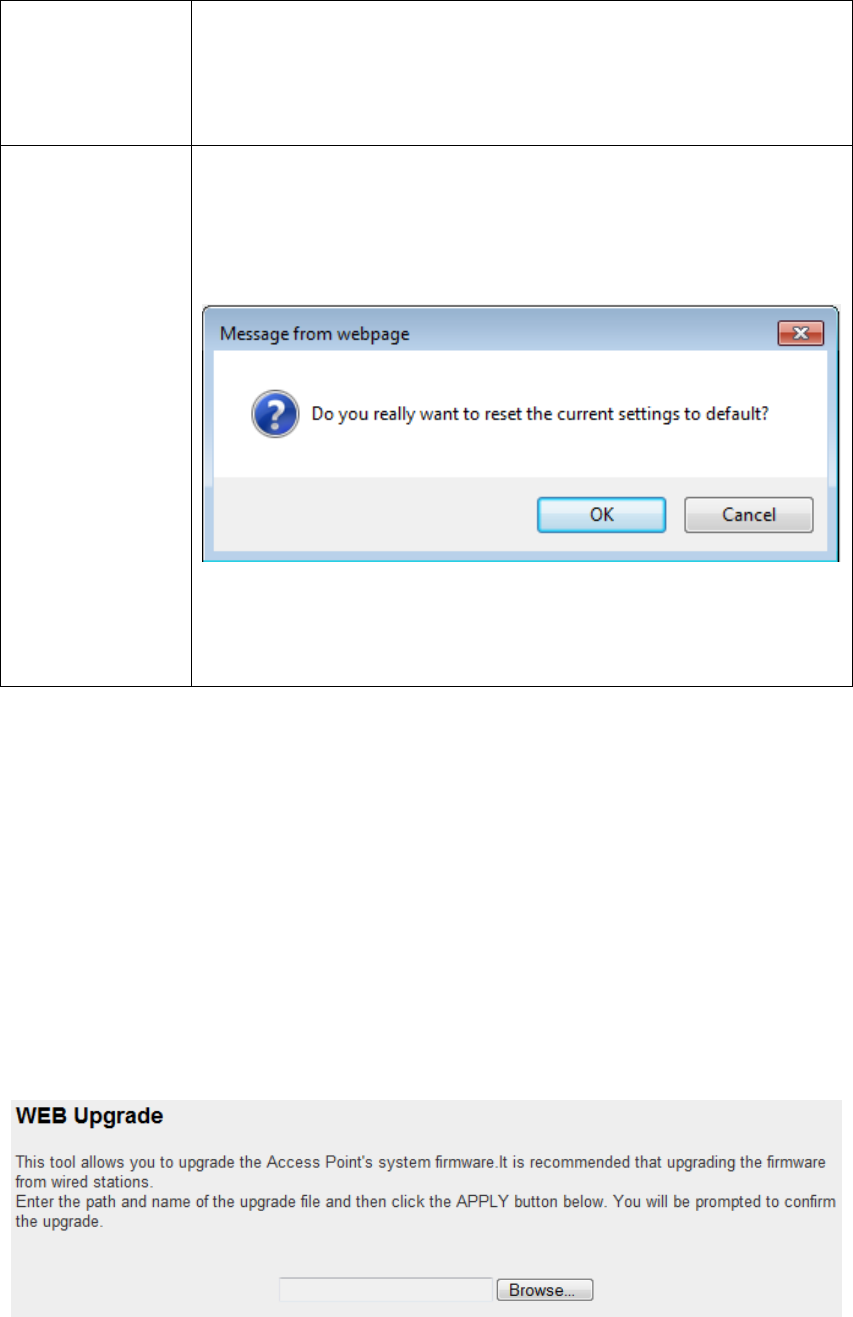
103
Restore
Settings
If you want to upload a saved configuration file to this
device, please click „Browse‟ button to select a saved
configuration file on your computer. Then click ‟Upload‟
button to restore the current settings to new one.
Reset to
Factory
Default
To reset all settings of this device to factory defaults,
including password. You‟ll be prompted to confirm the
settings reset:
Click „OK‟ if you really want to restore all settings, or
click „Cancel‟ to abort.
WEB Upgrade
The software running in this device (i.e. „Firmwre‟) can be upgraded to
improve the functionality of this access point.
You can access our website to look for latest firmware file. Then
download the latest firmware file and save on your computer and upload
to this wireless AP.
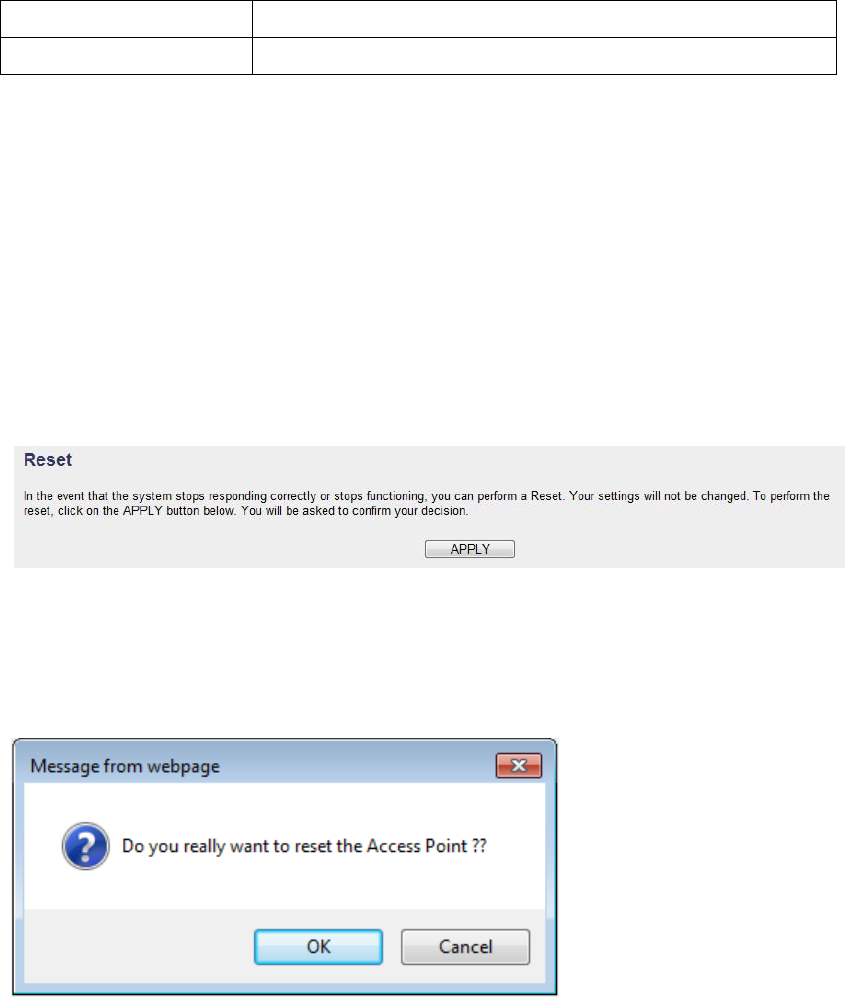
104
The description of every setup item is listed as follow:
Item
Description
Browse
Select a firmware file saved on your computer.
When you are ready, click „Apply‟ button to start firmware upgrade
procedure.
Reset
When you think this wireless AP is not working properly, resetting it may
help.
To reset this wireless repeater, click „Apply‟ button. You‟ll be prompted
to confirm reset:
Click „OK‟ button to reset wireless repeater, or click „Cancel‟ to abort.
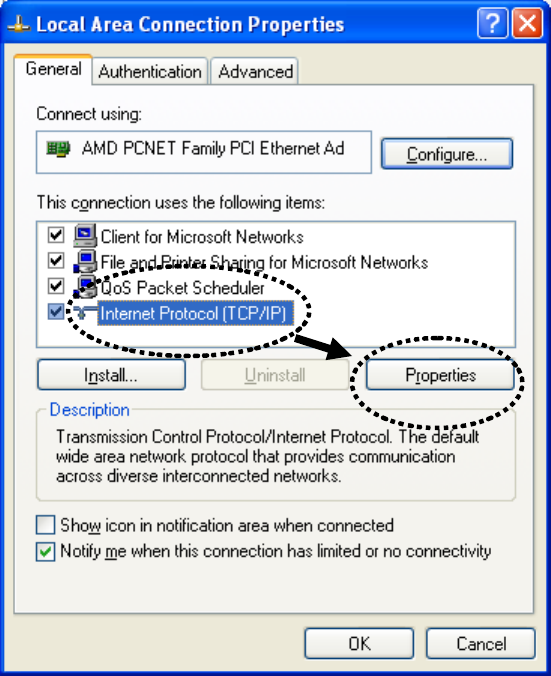
105
Chapter X: Appendix
5-1 Configuring TCP/IP on PC
5-1-1 Windows XP IP address setup:
1. Click „Start‟ button (it should be located at lower-left corner of your
computer), then click control panel. Double-click Network and Internet
Connections icon, click Network Connections, then double-click Local
Area Connection, Local Area Connection Status window will appear,
and then click „Properties‟
2. Select „Obtain an IP address automatically‟ and „Obtain DNS server
address automatically‟, then click „OK‟.
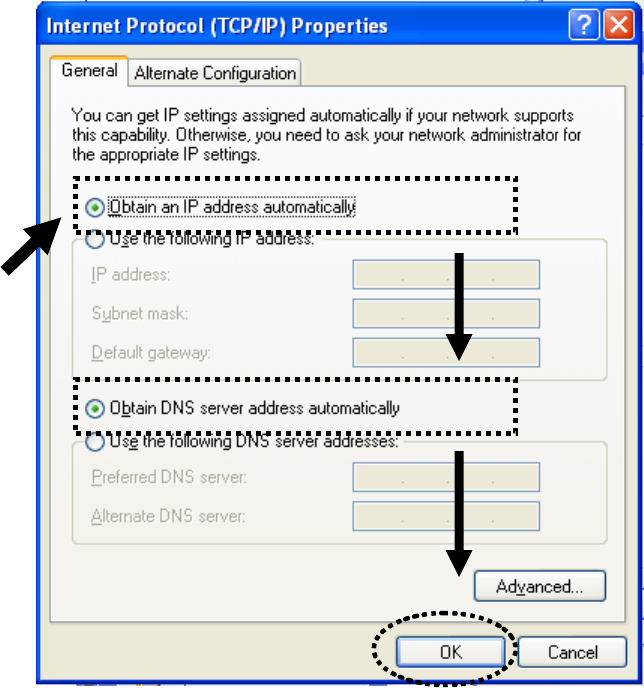
106
5-1-2 Windows Vista/Windows 7 IP address setup:
1. Click „Start‟ button (it should be located at lower-left corner of your
computer), then click control panel. Click View Network Status and
Tasks, and then click Manage Network Connections. Right-click Local
Area Network, then select ‘Properties’. Local Area Connection
Properties window will appear, select „Internet Protocol Version 4 (TCP /
IPv4), and then click „Properties‟
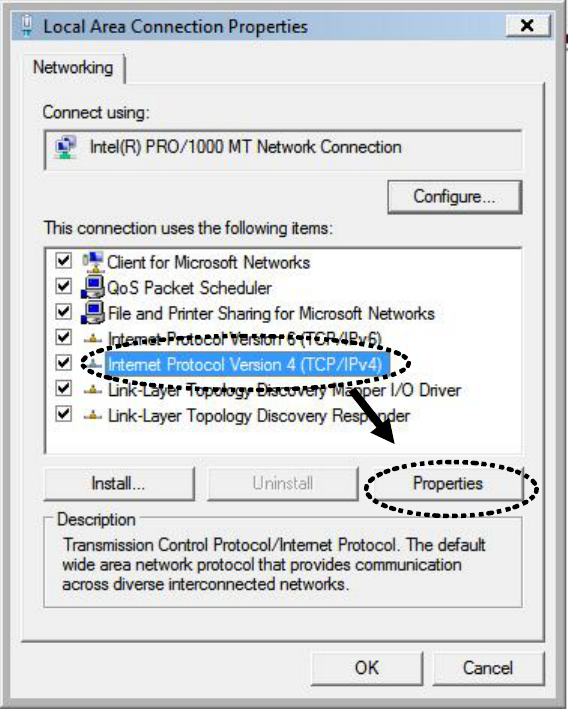
107
2. Select „Obtain an IP address automatically‟ and „Obtain DNS server
address automatically‟, then click „OK‟.
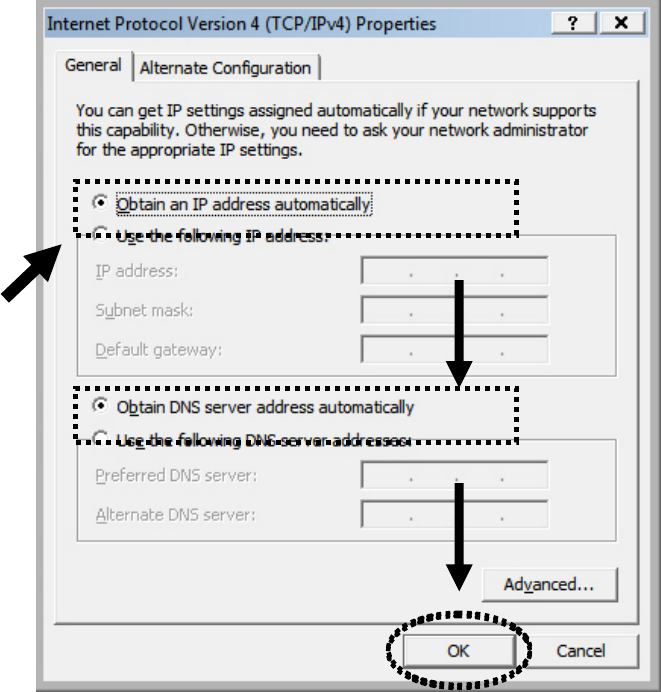
108
109
5-2 Specification
SoC + RF: Realtek RTL8196CS+ RTL8192CE
Flash: 2MB
SDRAM: 16MB
LAN Port: 10/100M UTP Port x 1
Power: 5VDC, 1A Switching Power Module Inside
Dimension: 46.5(W) x 73(H) x 41(D) mm excluding power plug
Transmit Power: 11n: 13dBm±1.5dBm, 11g: 14dBm±1.5dBm, 11b:
17dBm±1.5dBm
Temperature: 32~104°F (0 ~ 40°C)
Humidity: 10-90% (NonCondensing)
Certification: FCC, CE
110
5-3 Glossary
1. What is the IEEE 802.11g standard?
802.11g is the new IEEE standard for high-speed wireless LAN
communications that provides for up to 54 Mbps data rate in the 2.4
GHz band. 802.11g is quickly becoming the next mainstream
wireless LAN technology for the home, office and public networks.
802.11g defines the use of the same OFDM modulation technique
specified in IEEE 802.11a for the 5 GHz frequency band and applies
it in the same 2.4 GHz frequency band as IEEE 802.11b. The
802.11g standard requires backward compatibility with 802.11b.
The standard specifically calls for:
A. A new physical layer for the 802.11 Medium Access Control
(MAC) in the 2.4 GHz frequency band, known as the extended
rate PHY (ERP). The ERP adds OFDM as a mandatory new
coding scheme for 6, 12 and 24 Mbps (mandatory speeds), and 18,
36, 48 and 54 Mbps (optional speeds). The ERP includes the
modulation schemes found in 802.11b including CCK for 11 and
5.5 Mbps and Barker code modulation for 2 and 1 Mbps.
B. A protection mechanism called RTS/CTS that governs how
802.11g devices and 802.11b devices interoperate.
2. What is the IEEE 802.11b standard?
The IEEE 802.11b Wireless LAN standard subcommittee, which
formulates the standard for the industry. The objective is to enable
wireless LAN hardware from different manufactures to
communicate.
3. What does IEEE 802.11 feature support?
The product supports the following IEEE 802.11 functions:
CSMA/CA plus Acknowledge Protocol
Multi-Channel Roaming
Automatic Rate Selection
RTS/CTS Feature
Fragmentation
Power Management
4. What is Ad-hoc?
An Ad-hoc integrated wireless LAN is a group of computers, each
has a Wireless LAN card, Connected as an independent wireless
LAN. Ad hoc wireless LAN is applicable at a departmental scale for
111
a branch or SOHO operation.
5. What is Infrastructure?
An integrated wireless and wireless and wired LAN is called an
Infrastructure configuration. Infrastructure is applicable to enterprise
scale for wireless access to central database, or wireless application
for mobile workers.
6. What is BSS ID?
A specific Ad hoc LAN is called a Basic Service Set (BSS).
Computers in a BSS must be configured with the same BSS ID.
7. What is WEP?
WEP is Wired Equivalent Privacy, a data privacy mechanism based
on a 40 bit shared key algorithm, as described in the IEEE 802 .11
standard.
8. What is TKIP?
TKIP is a quick-fix method to quickly overcome the inherent
weaknesses in WEP security, especially the reuse of encryption keys.
TKIP is involved in the IEEE 802.11i WLAN security standard, and
the specification might be officially released by early 2003.
9. What is AES?
AES (Advanced Encryption Standard), a chip-based security, has
been developed to ensure the highest degree of security and
authenticity for digital information, wherever and however
communicated or stored, while making more efficient use of
hardware and/or software than previous encryption standards. It is
also included in IEEE 802.11i standard. Compare with AES, TKIP is
a temporary protocol for replacing WEP security until manufacturers
implement AES at the hardware level.
10. Can Wireless products support printer sharing?
Wireless products perform the same function as LAN products.
Therefore, Wireless products can work with Netware, Windows
2000, or other LAN operating systems to support printer or file
sharing.
11. Would the information be intercepted while transmitting on air?
WLAN features two-fold protection in security. On the hardware
side, as with Direct Sequence Spread Spectrum technology, it has
the inherent security feature of scrambling. On the software side,
WLAN series offer the encryption function (WEP) to enhance
security and Access Control. Users can set it up depending upon
112
their needs.
12. What is DSSS? What is FHSS? And what are their differences?
Frequency-hopping spread-spectrum (FHSS) uses a narrowband
carrier that changes frequency in a pattern that is known to both
transmitter and receiver. Properly synchronized, the net effect is to
maintain a single logical channel. To an unintended receiver, FHSS
appears to be short-duration impulse noise. Direct-sequence
spread-spectrum (DSSS) generates a redundant bit pattern for each
bit to be transmitted. This bit pattern is called a chip (or chipping
code). The longer the chip is, the greater the probability that the
original data can be recovered. Even if one or more bits in the chip
are damaged during transmission, statistical techniques embedded in
the radio can recover the original data without-the need for
retransmission. To an unintended receiver, DSSS appears as low
power wideband noise and is rejected (ignored) by most narrowband
receivers.
13. What is Spread Spectrum?
Spread Spectrum technology is a wideband radio frequency
technique developed by the military for use in reliable, secure,
mission-critical communication systems. It is designed to trade off
bandwidth efficiency for reliability, integrity, and security. In other
words, more bandwidth is consumed than in the case of narrowband
transmission, but the trade off produces a signal that is, in effect,
louder and thus easier to detect, provided that the receiver knows the
parameters of the spread-spectrum signal being broadcast. If a
receiver is not tuned to the right frequency, a spread –spectrum
signal looks like background noise. There are two main alternatives,
Direct Sequence Spread Spectrum (DSSS) and Frequency Hopping
Spread Spectrum (FHSS).
14. What is WPS?
WPS stands for Wi-Fi Protected Setup. It provides a simple way to
establish unencrypted or encrypted connections between wireless
clients and access point automatically. User can press a software or
hardware button to activate WPS function, and WPS-compatible
wireless clients and access point will establish connection by
themselves. There are two types of WPS: PBC (Push-Button
Configuration) and PIN code.